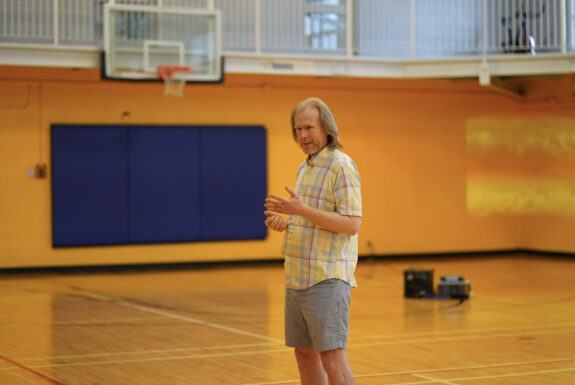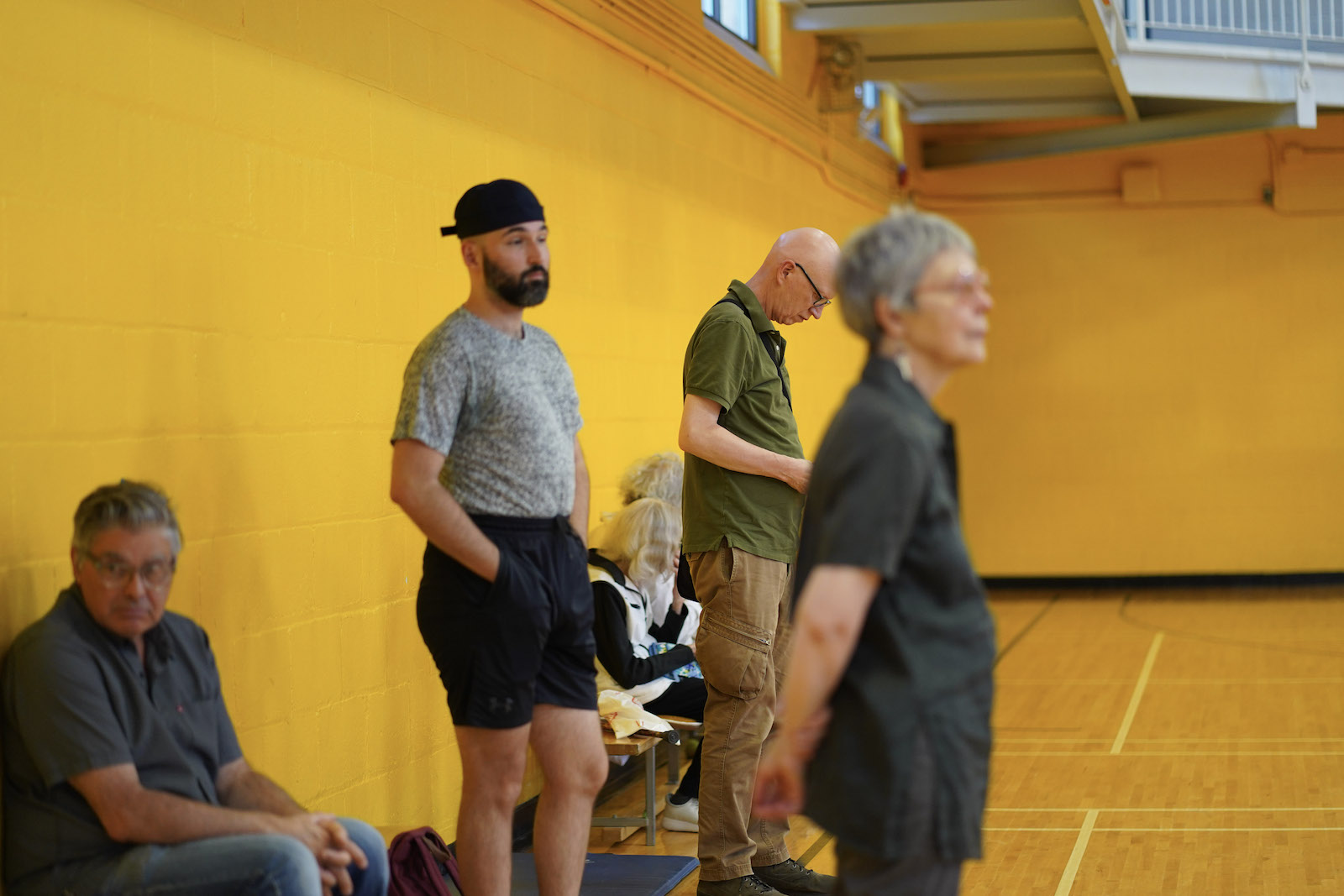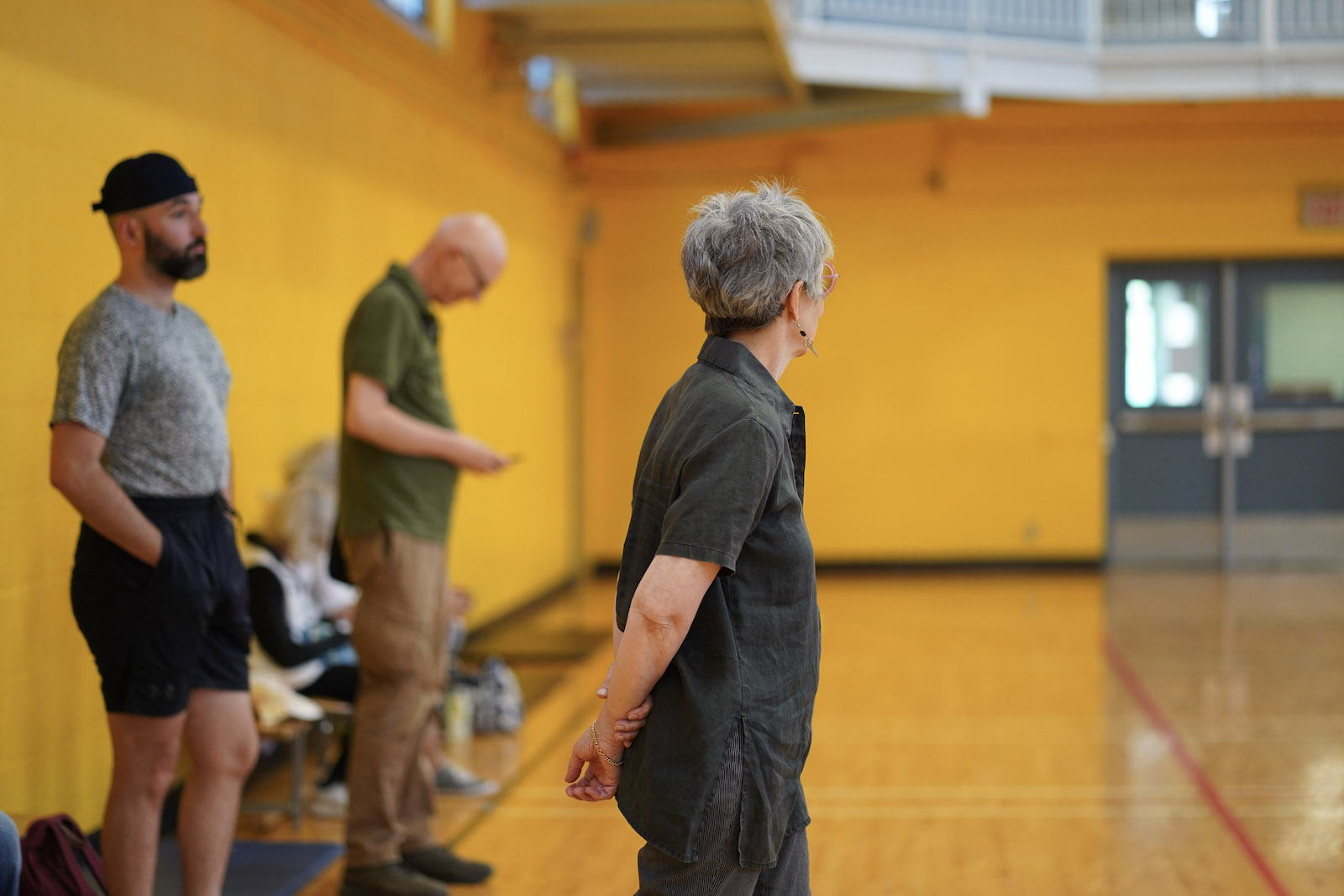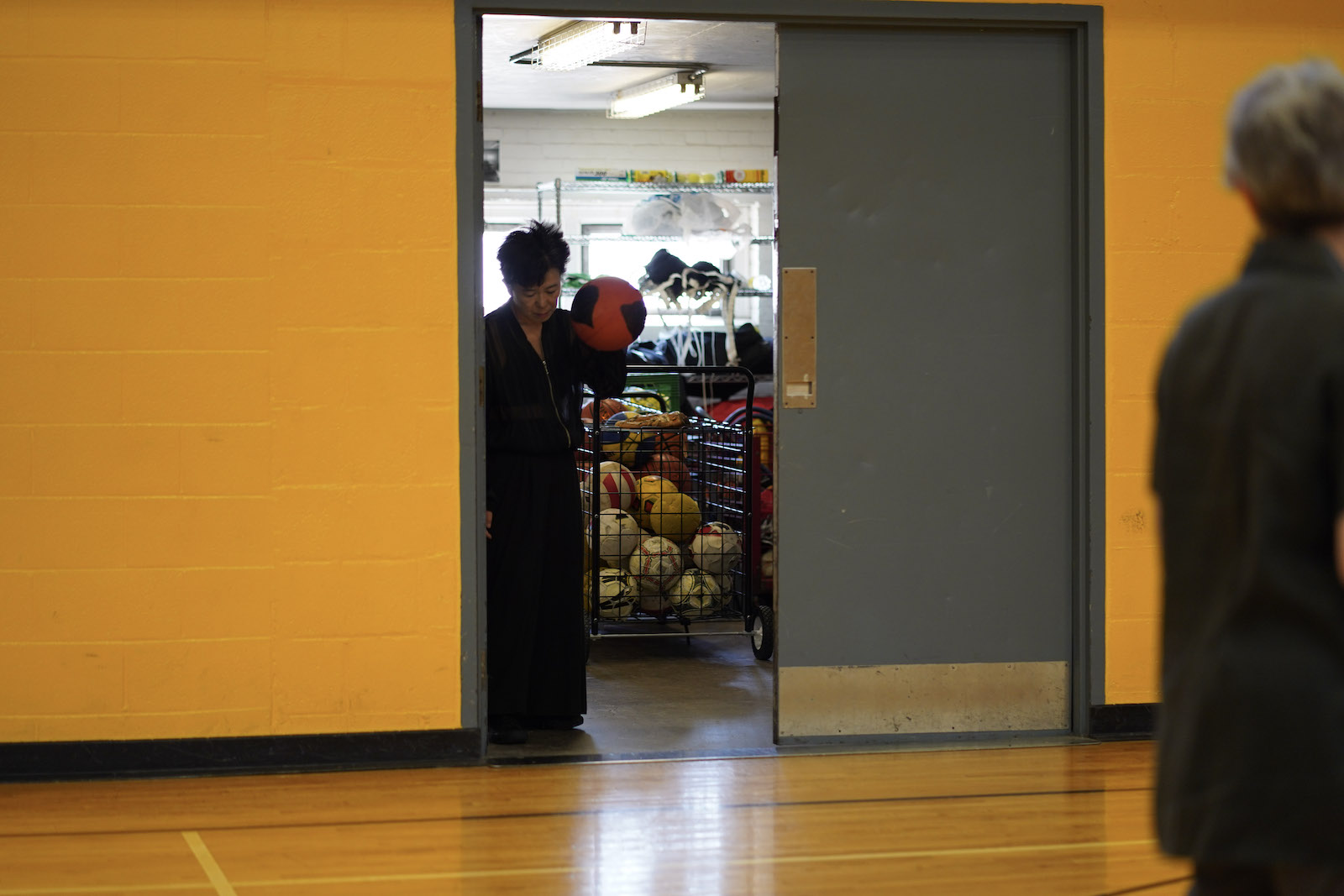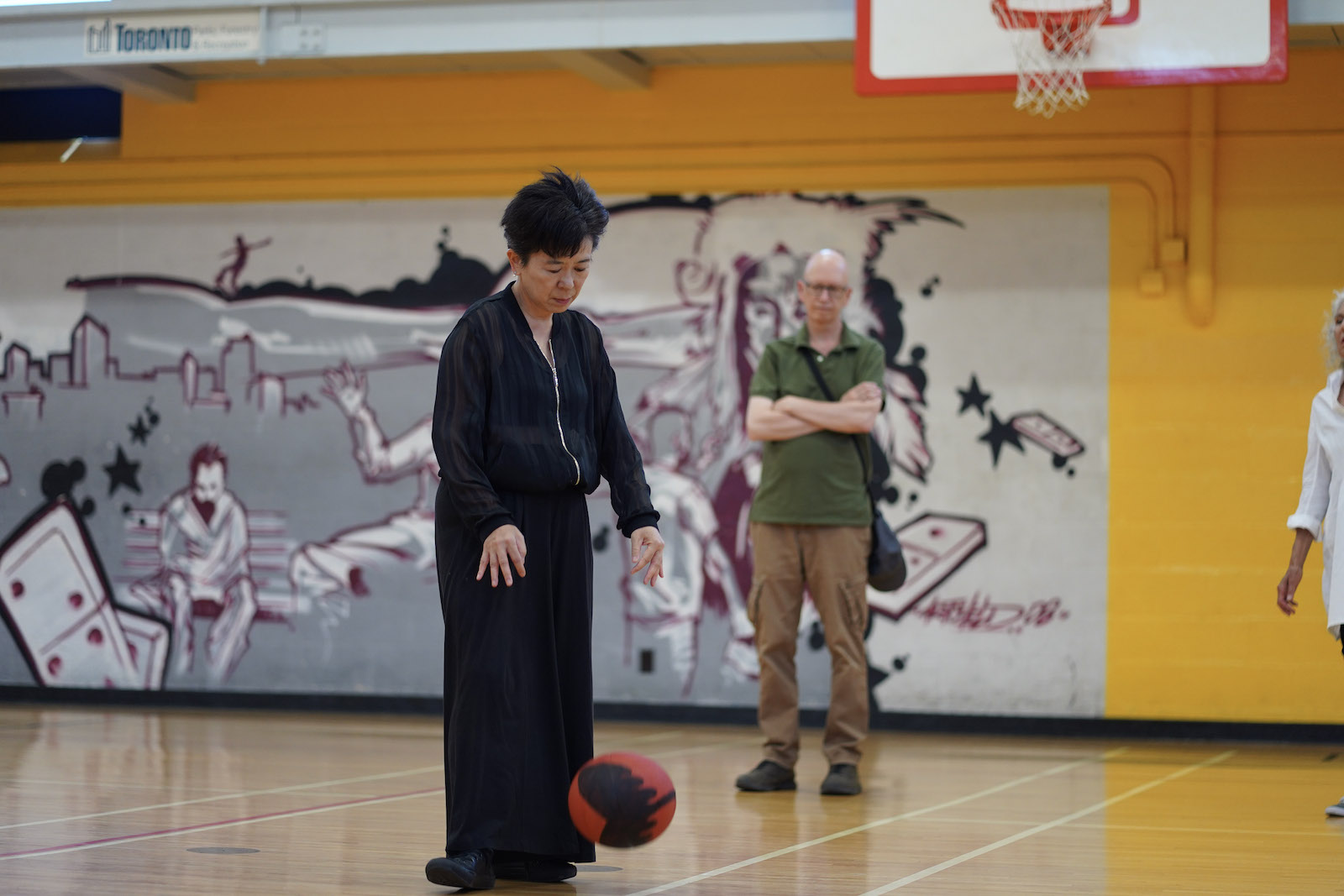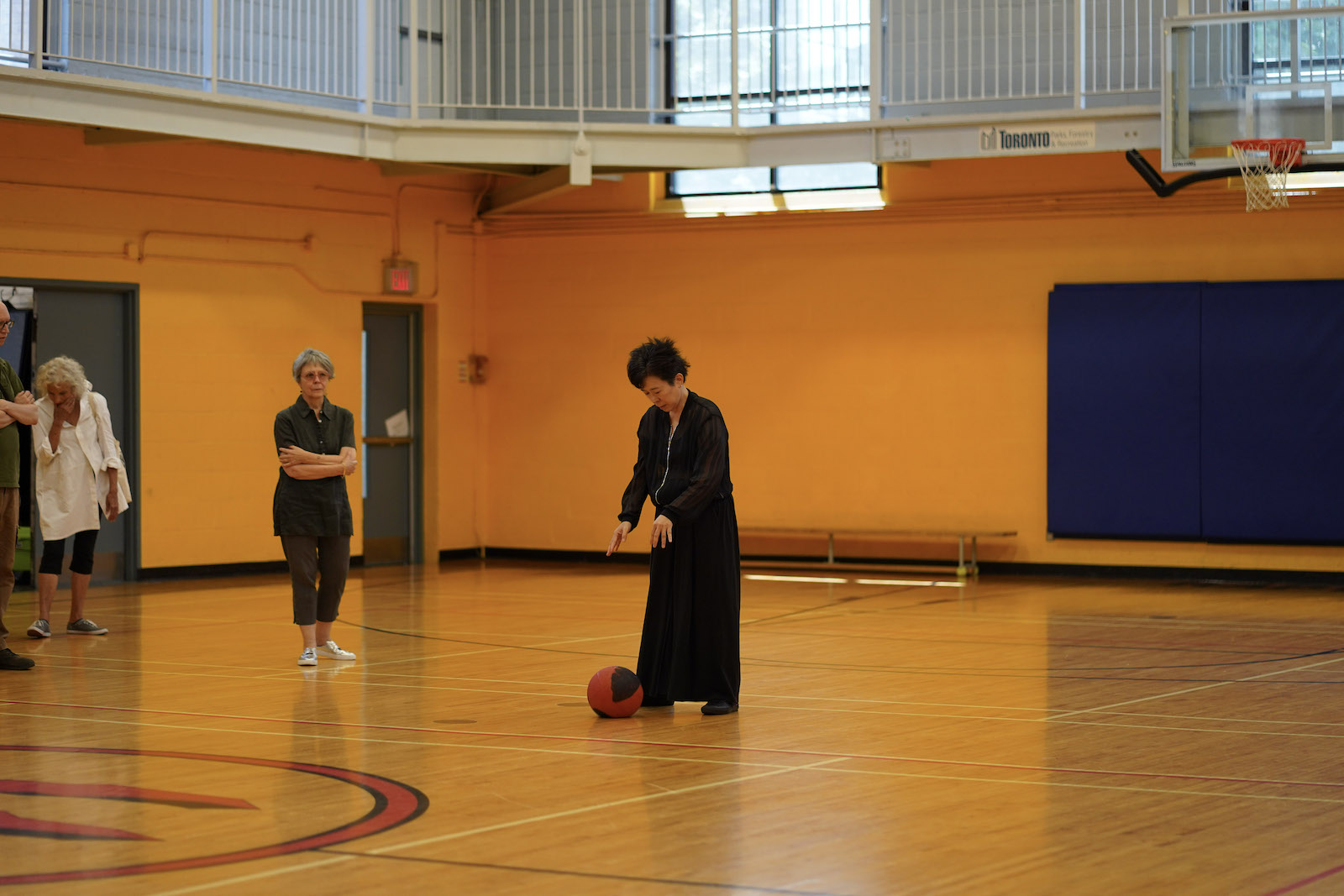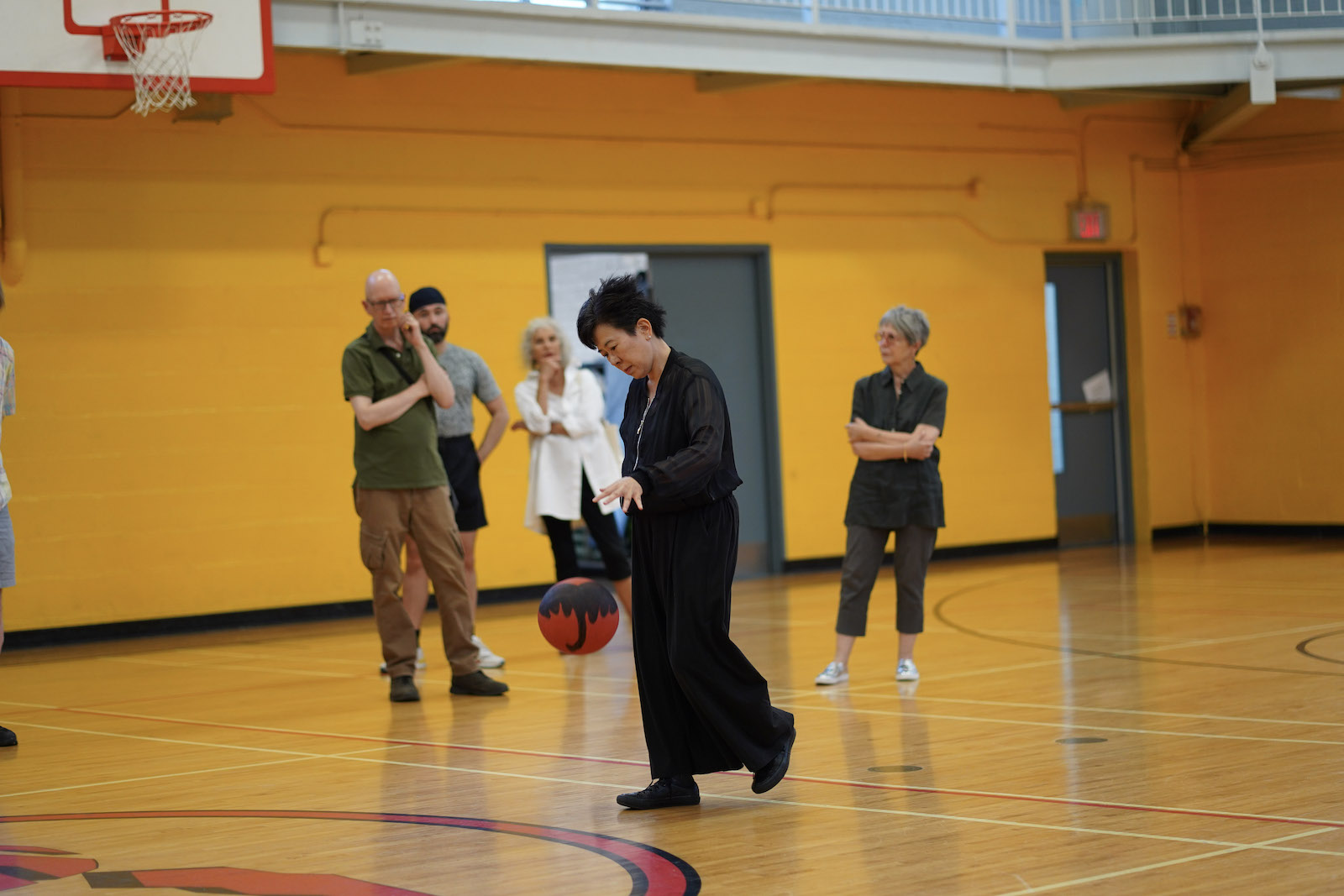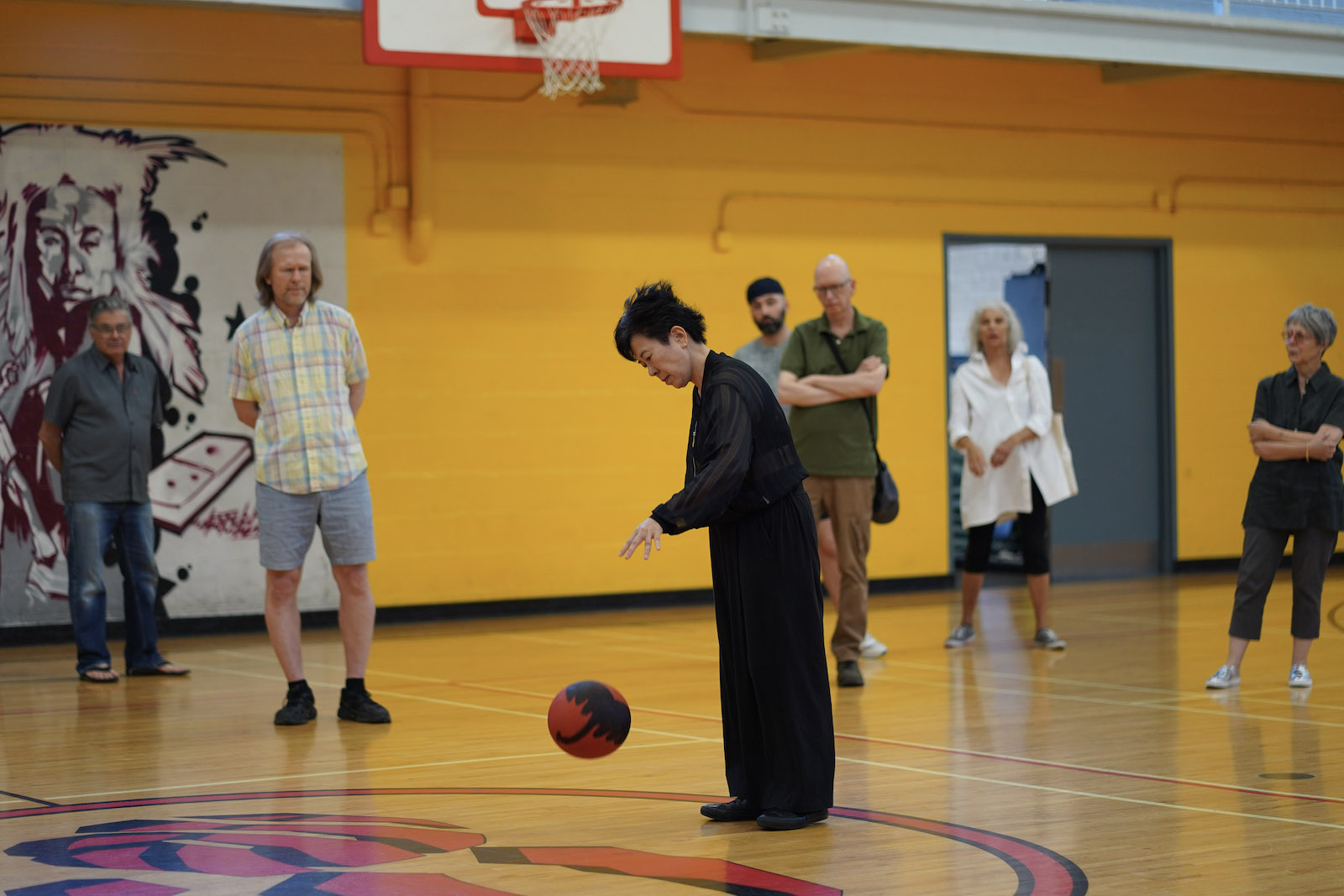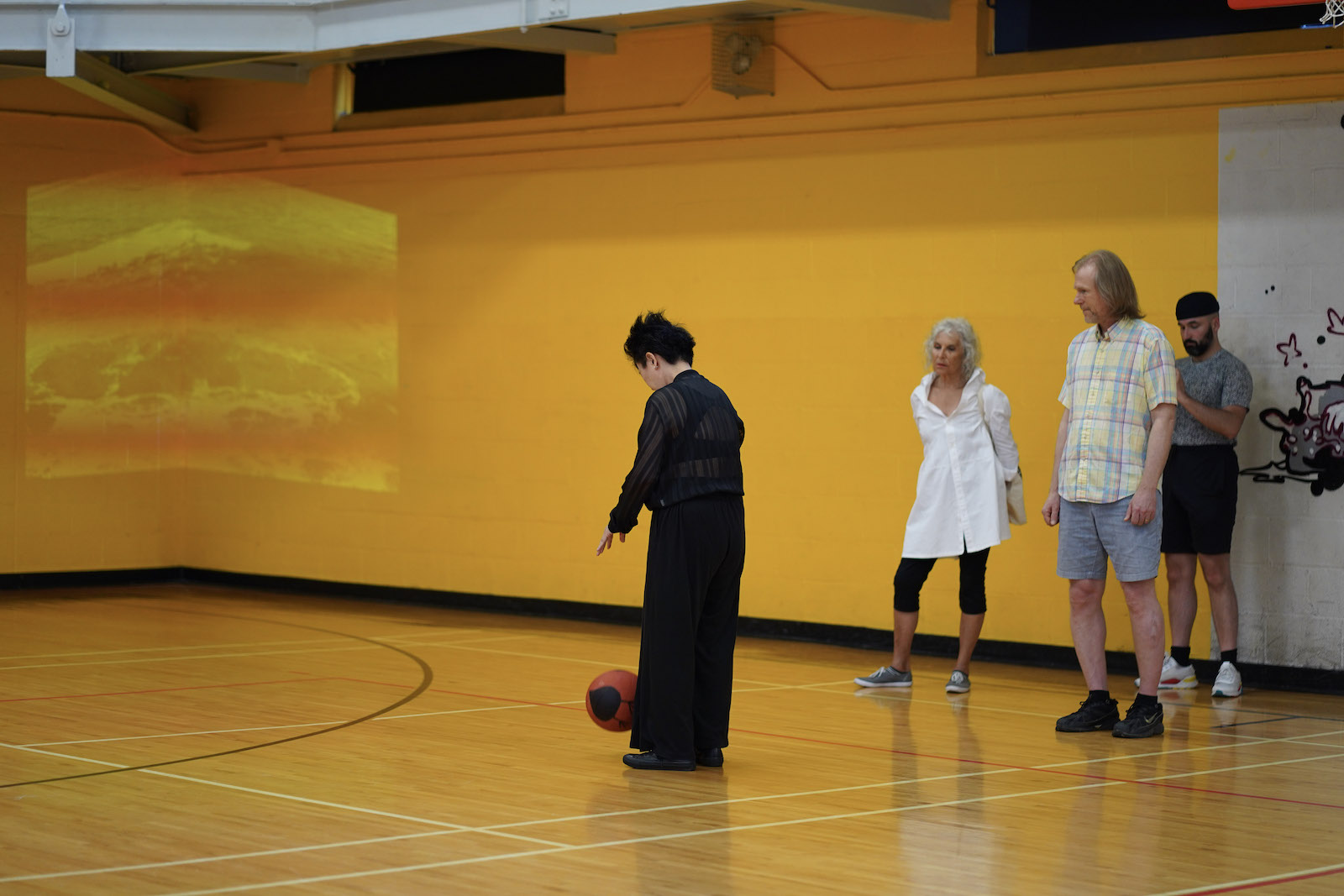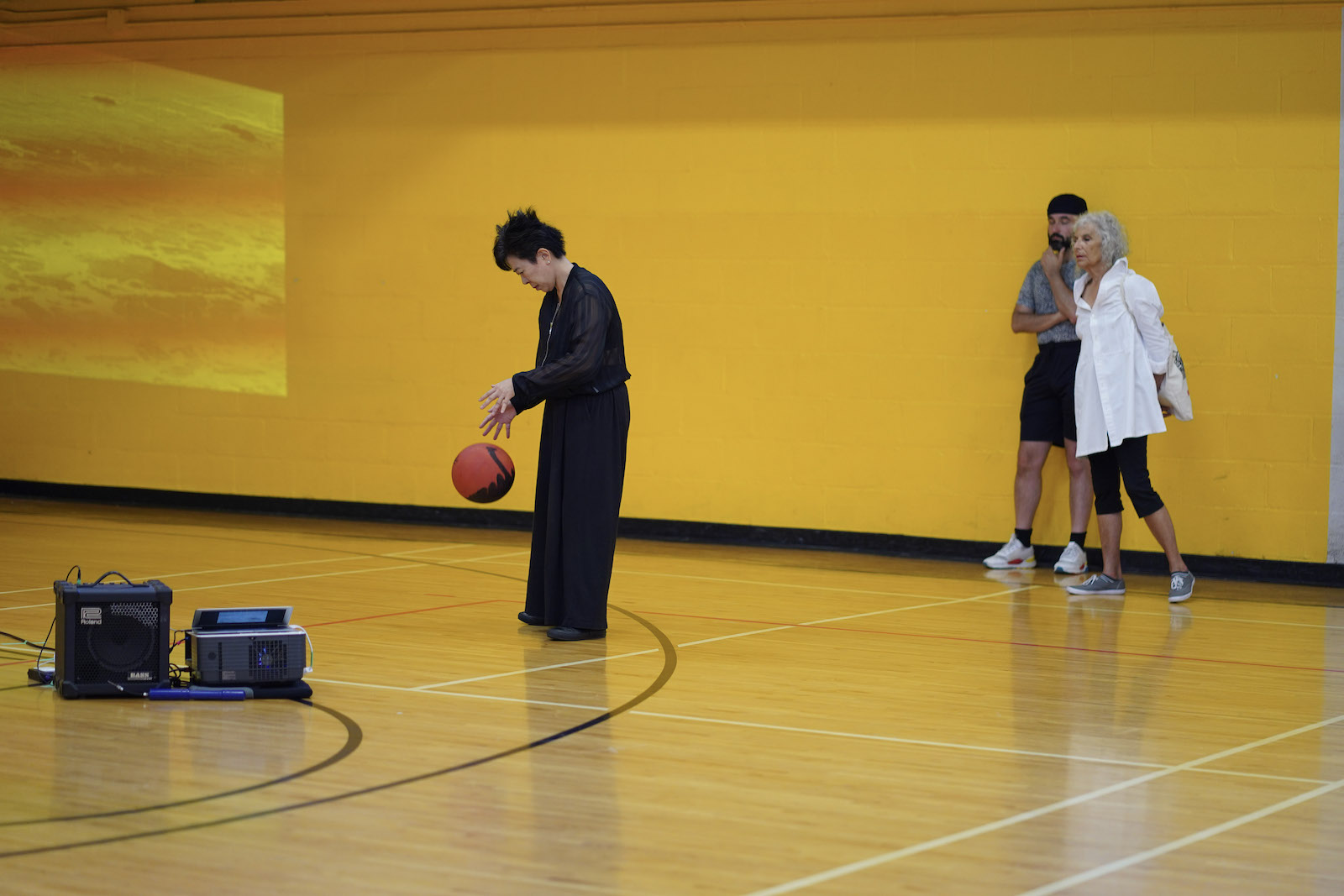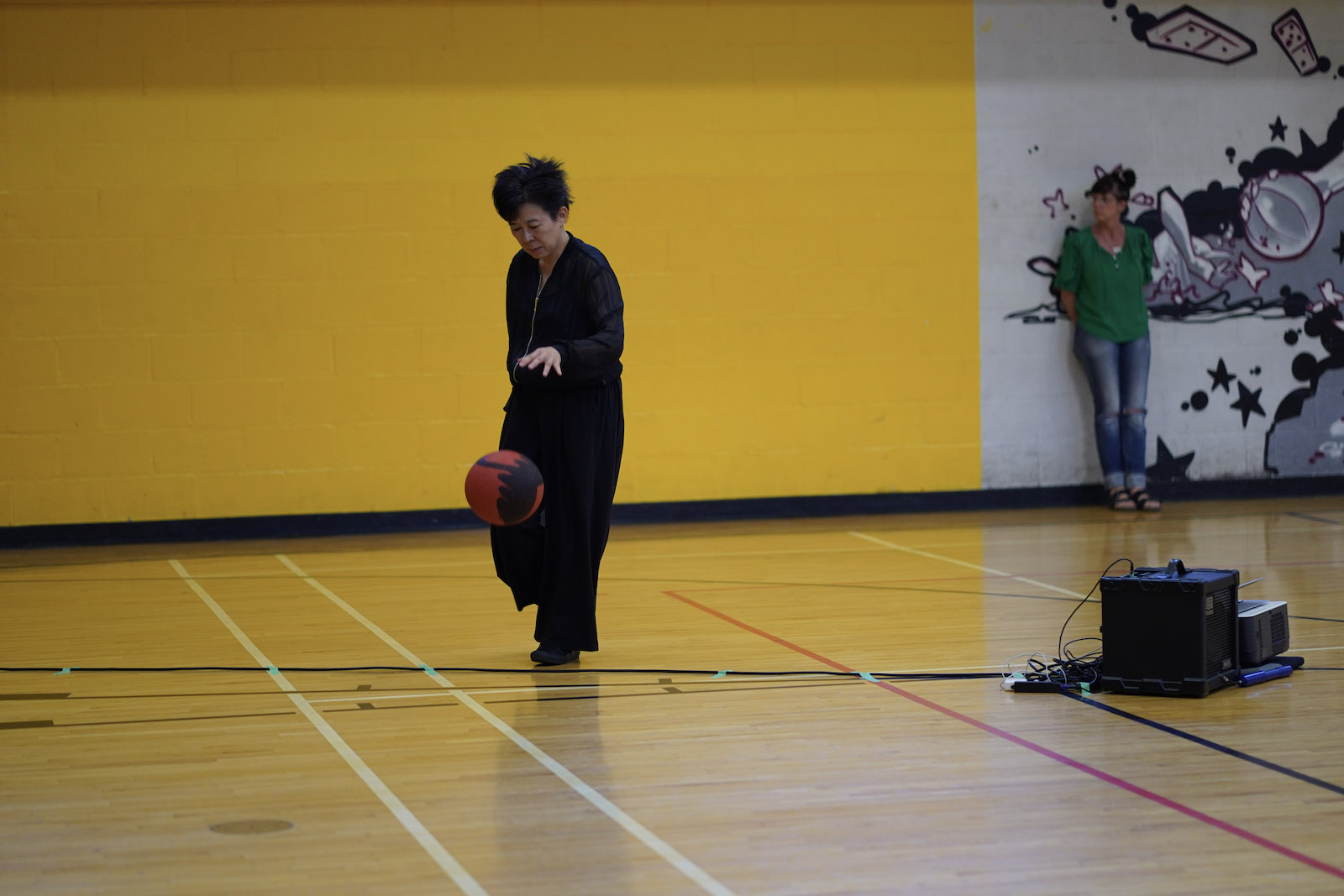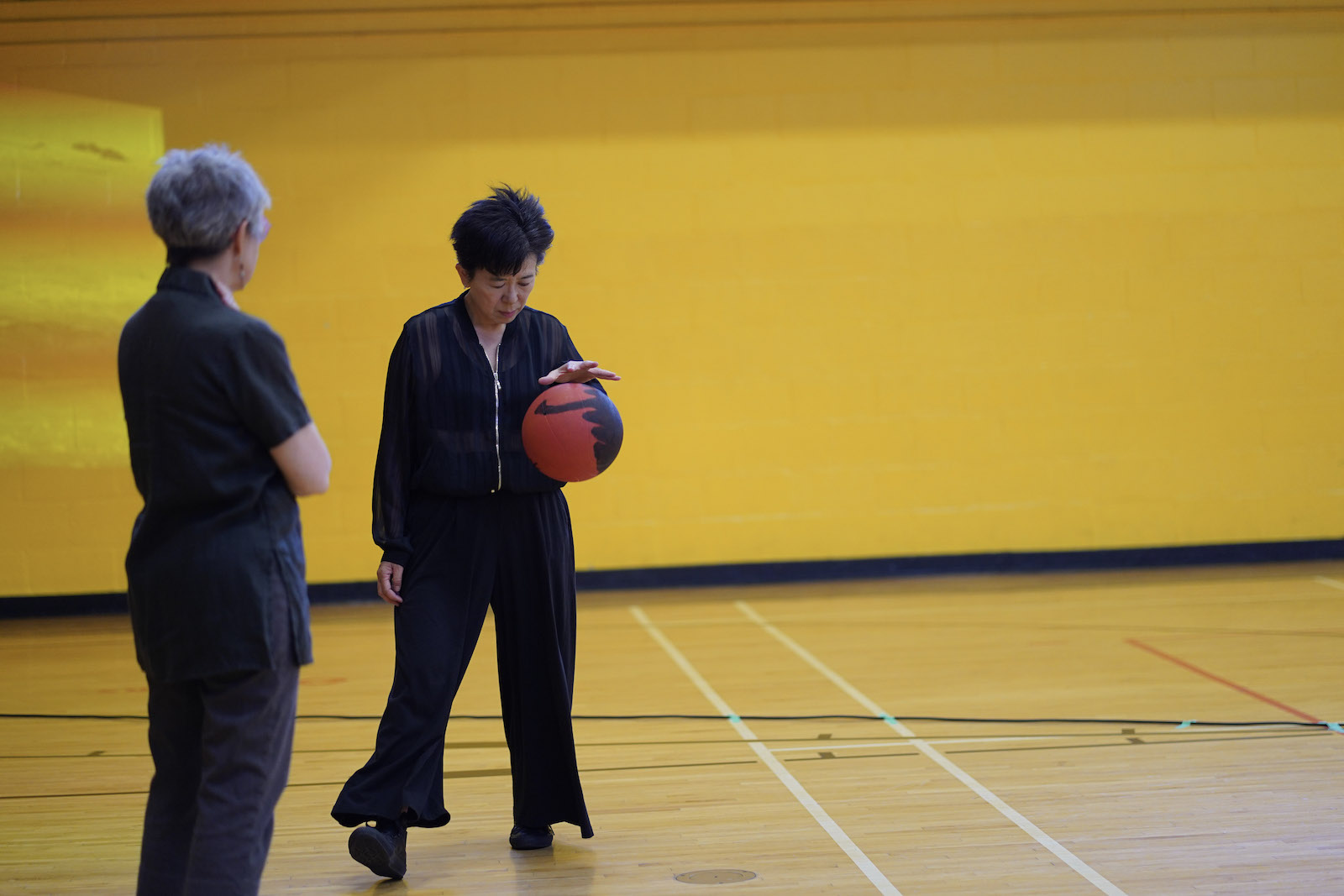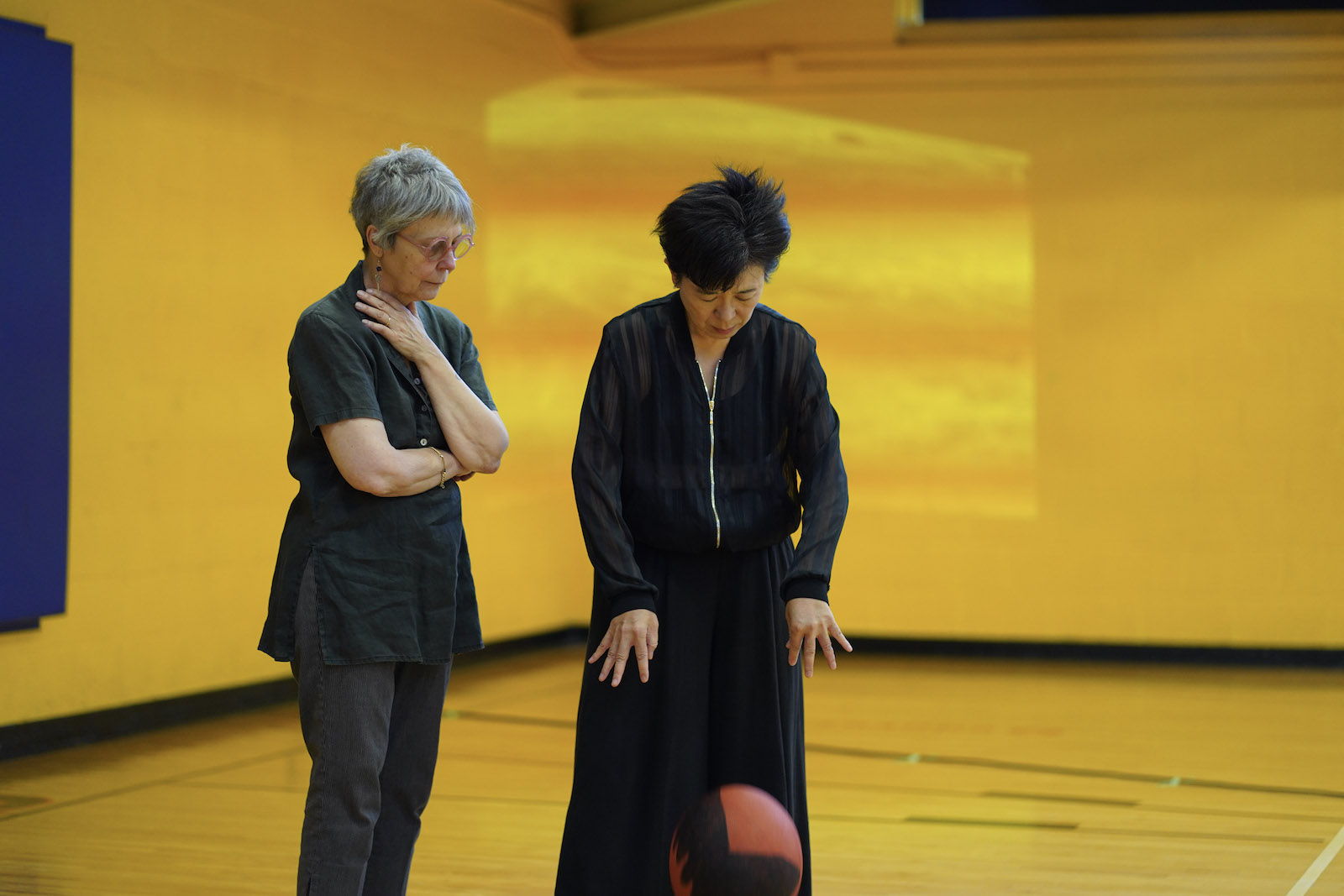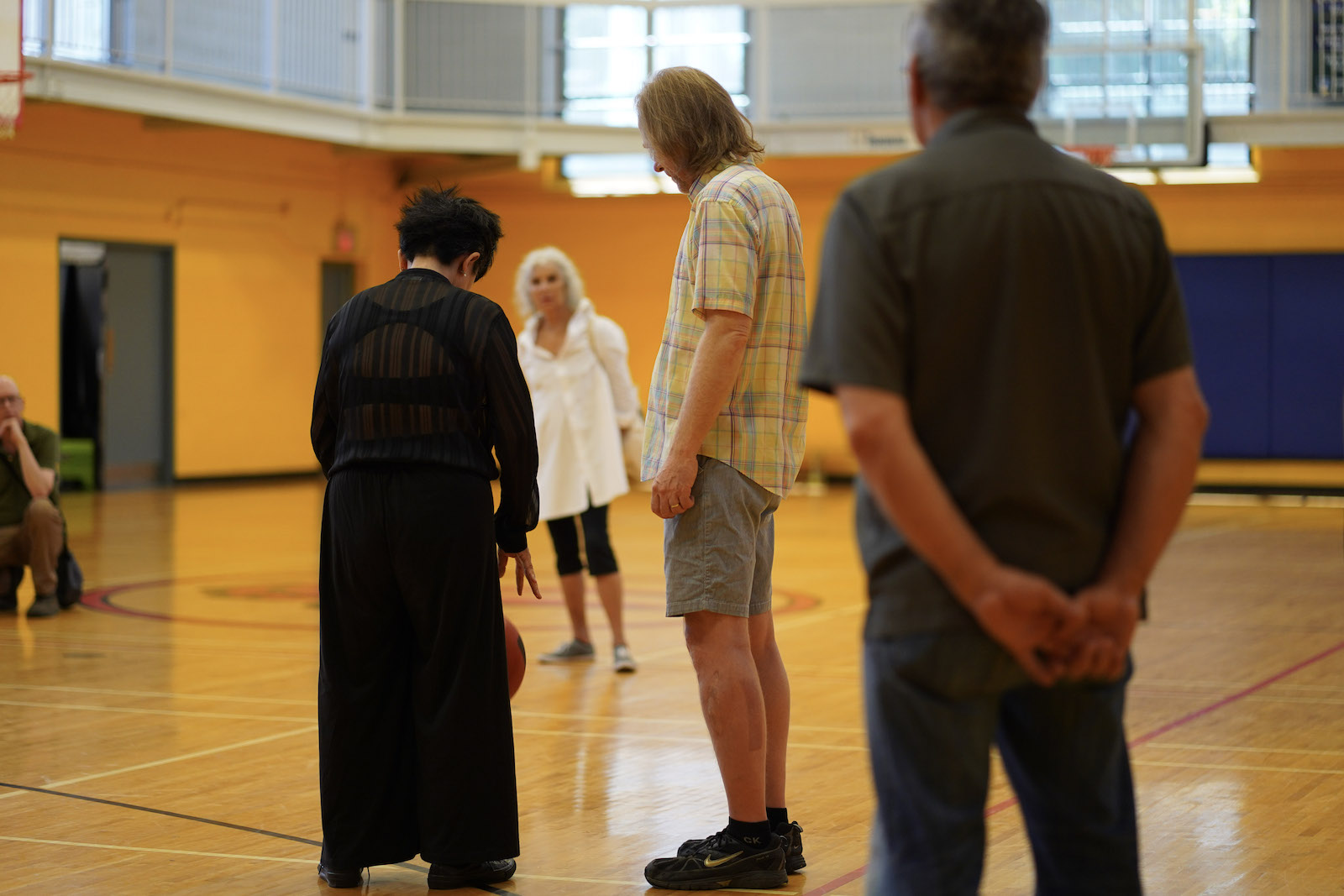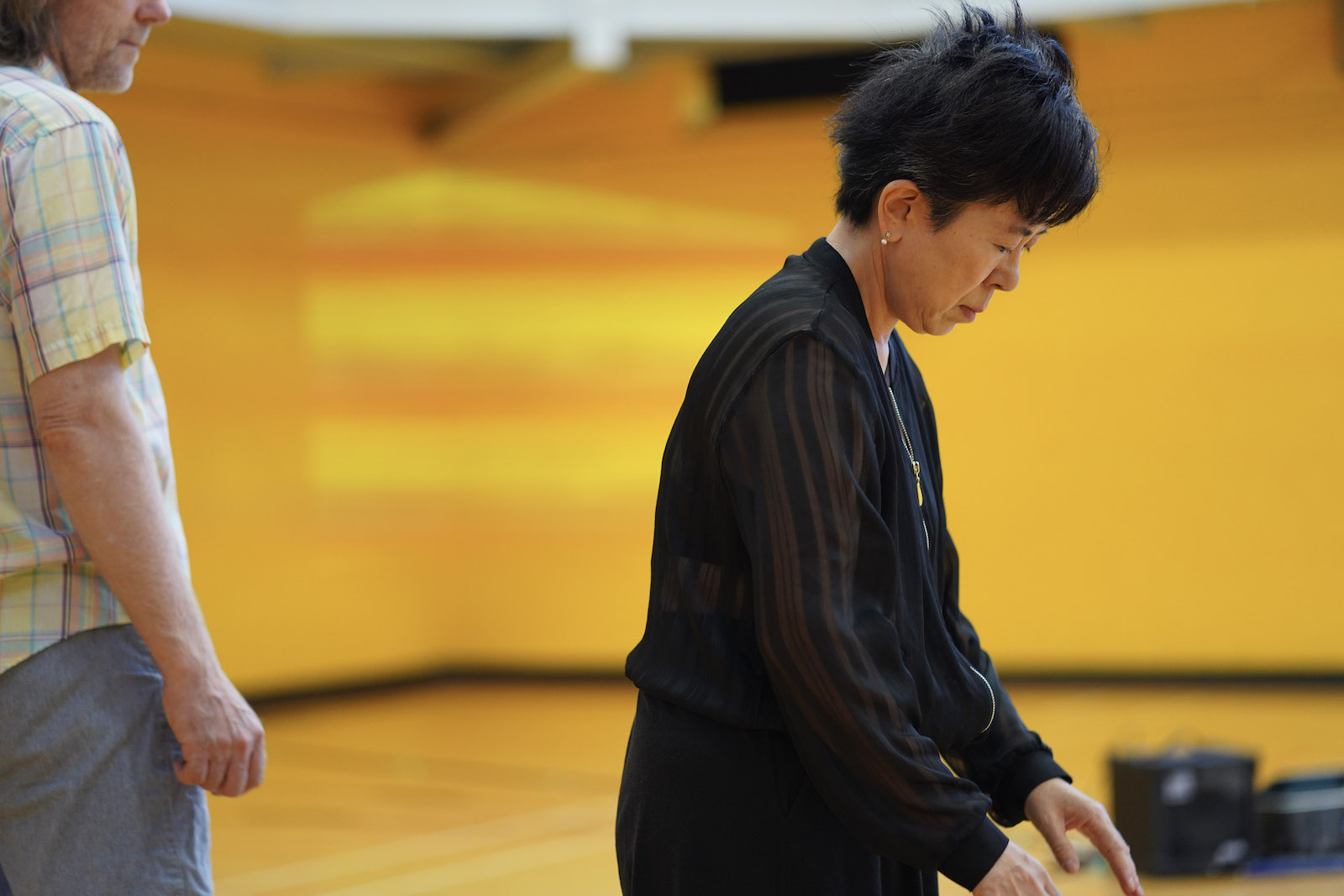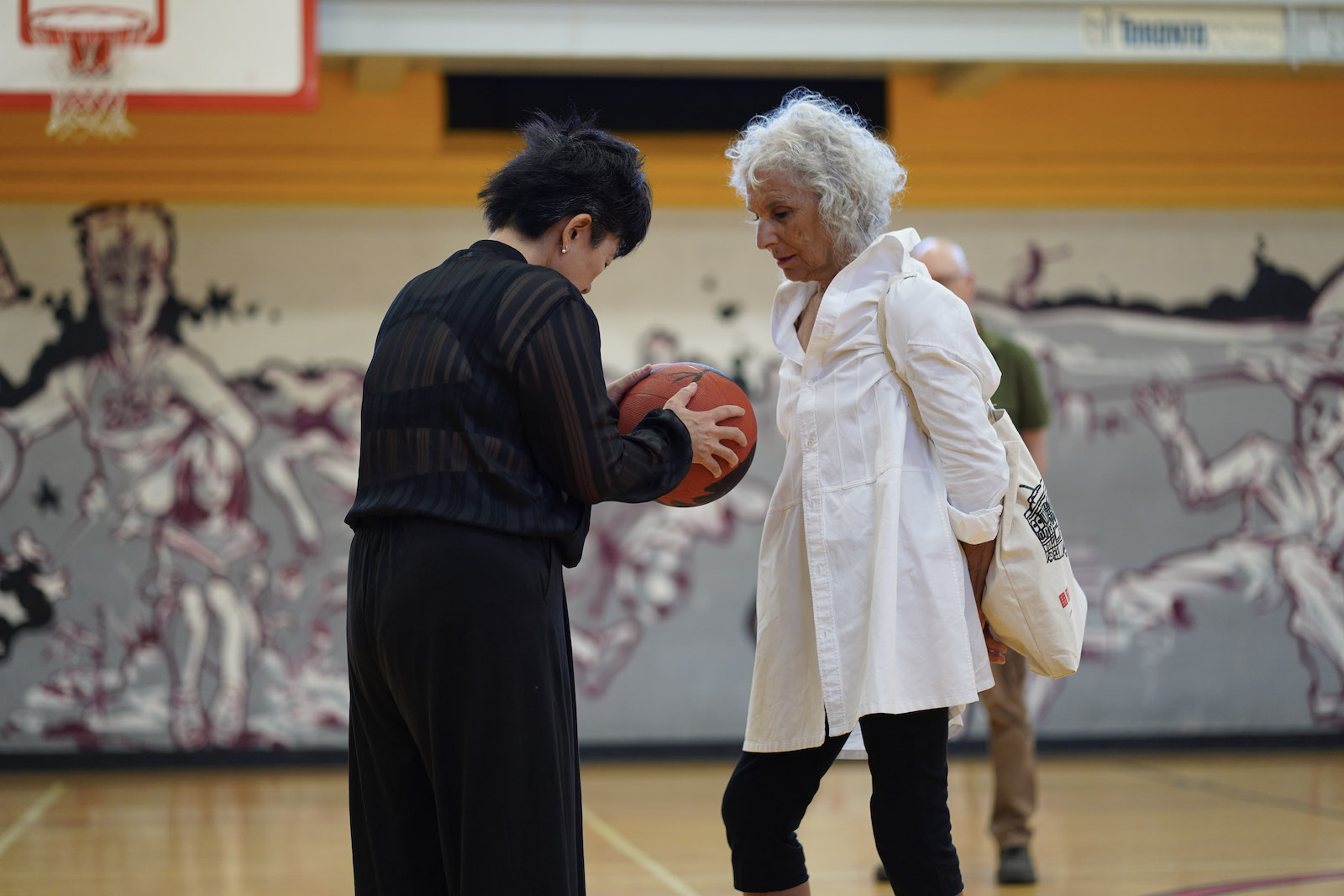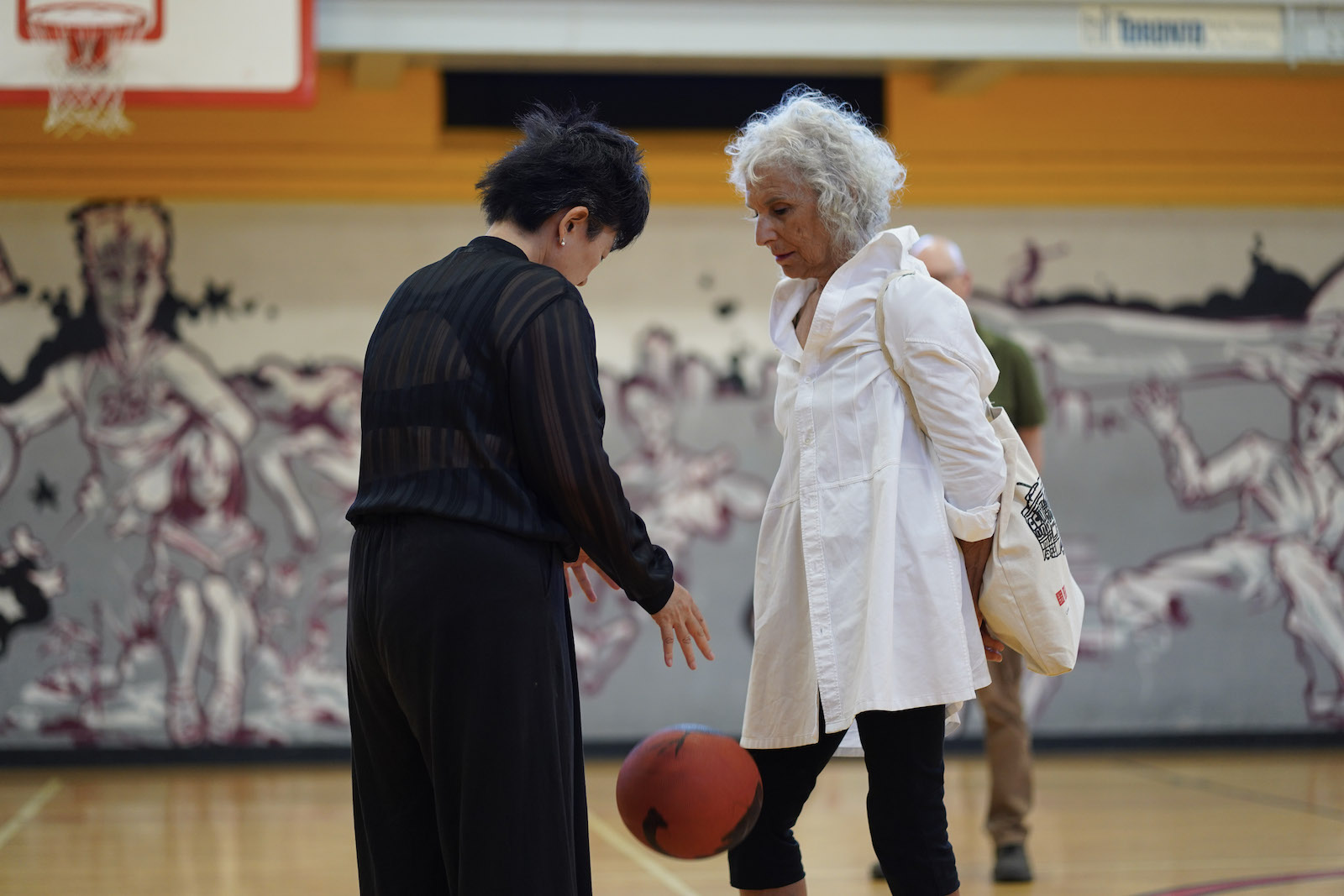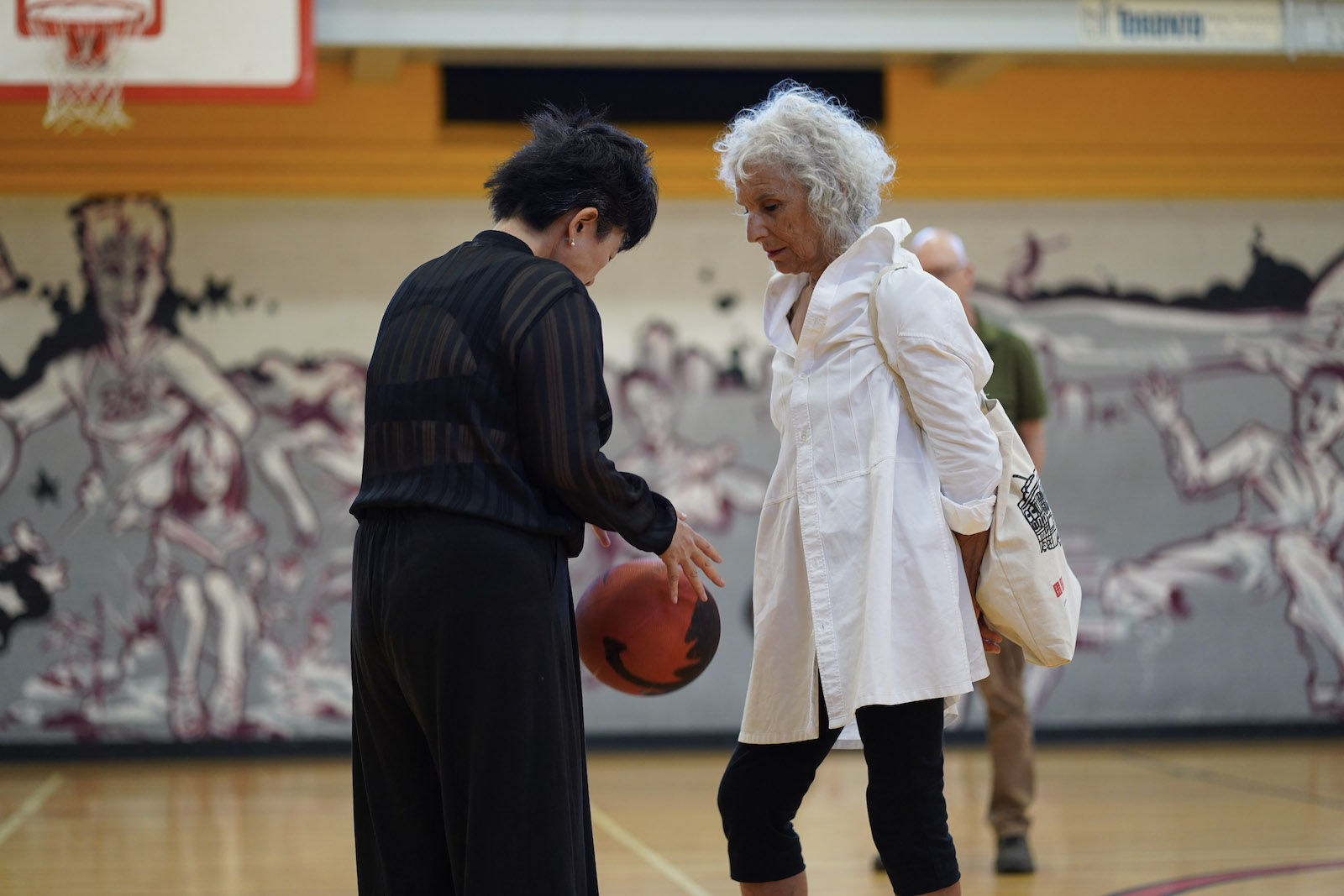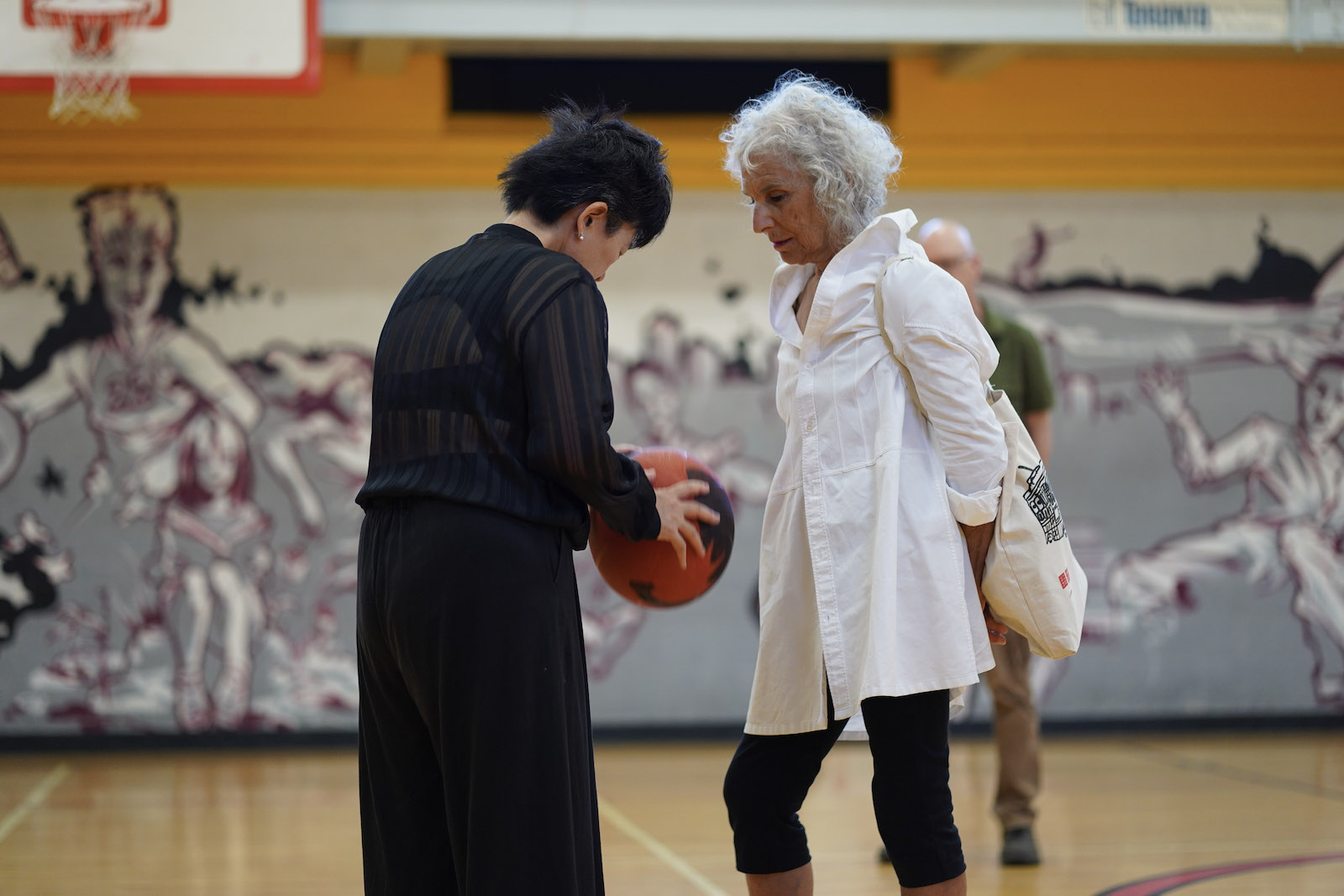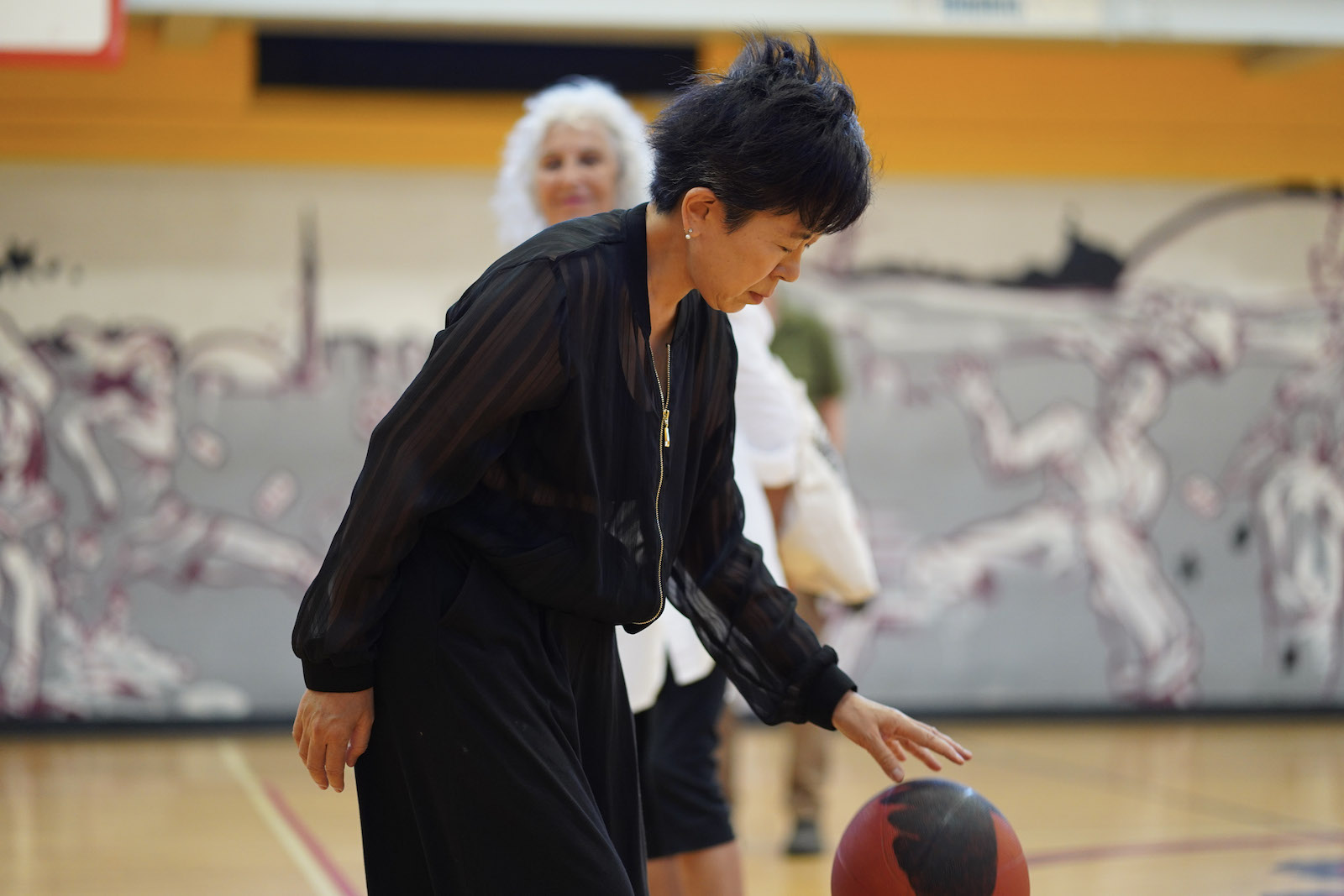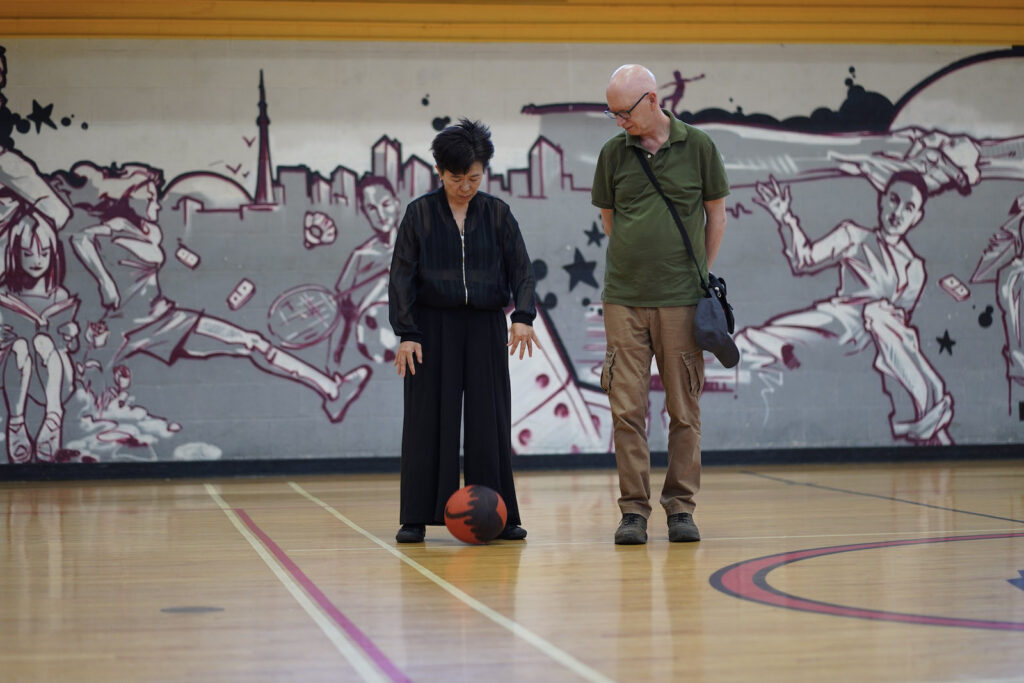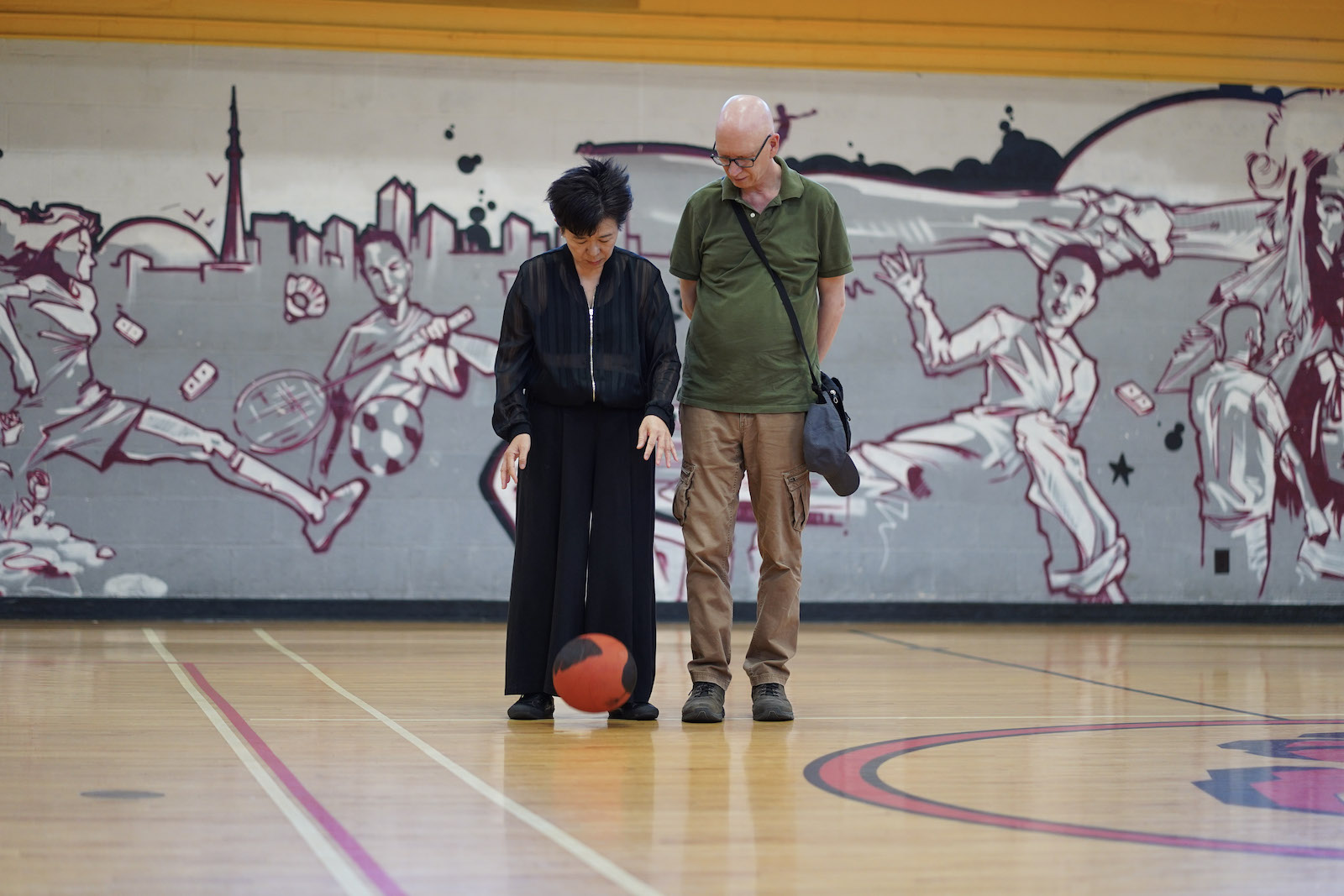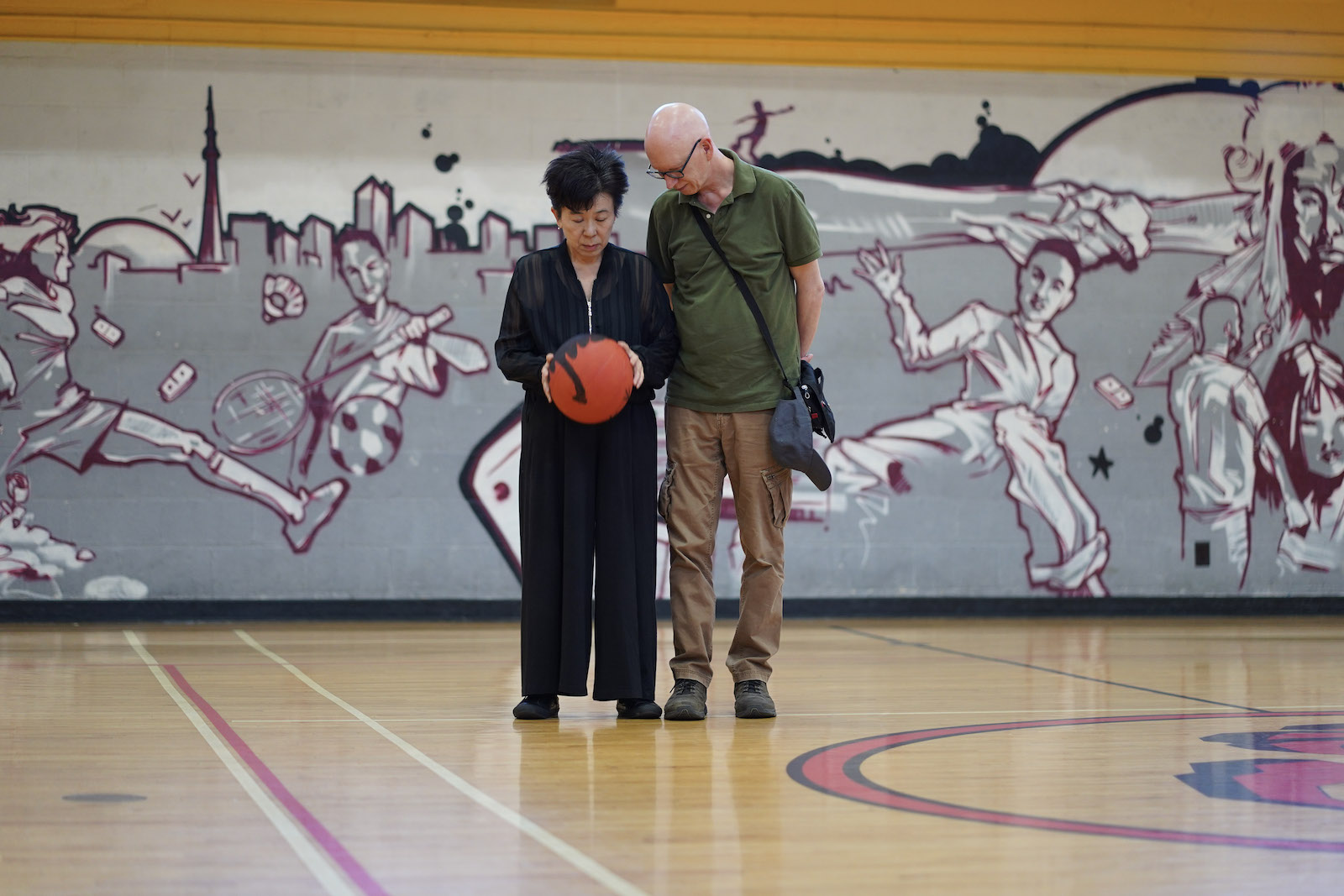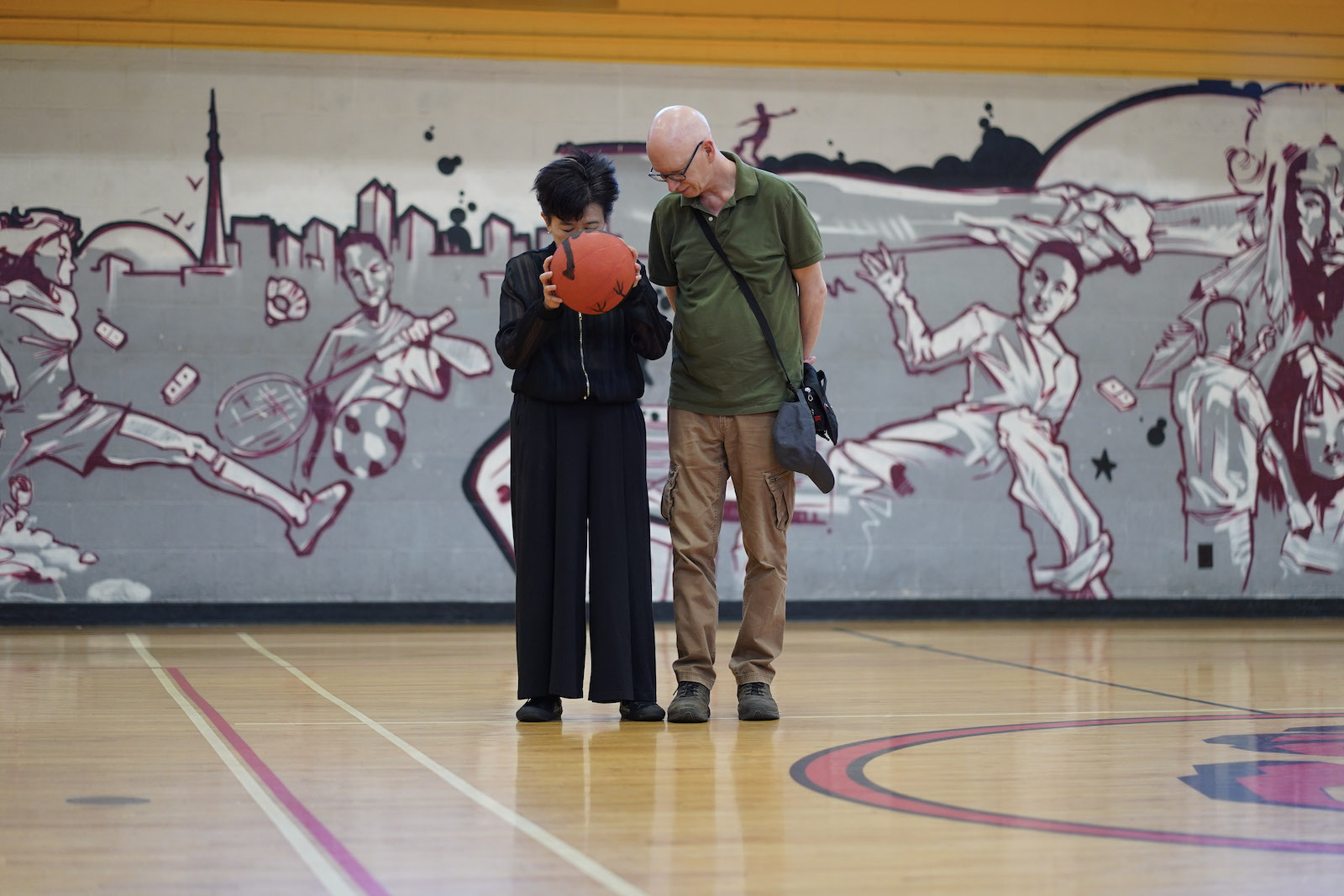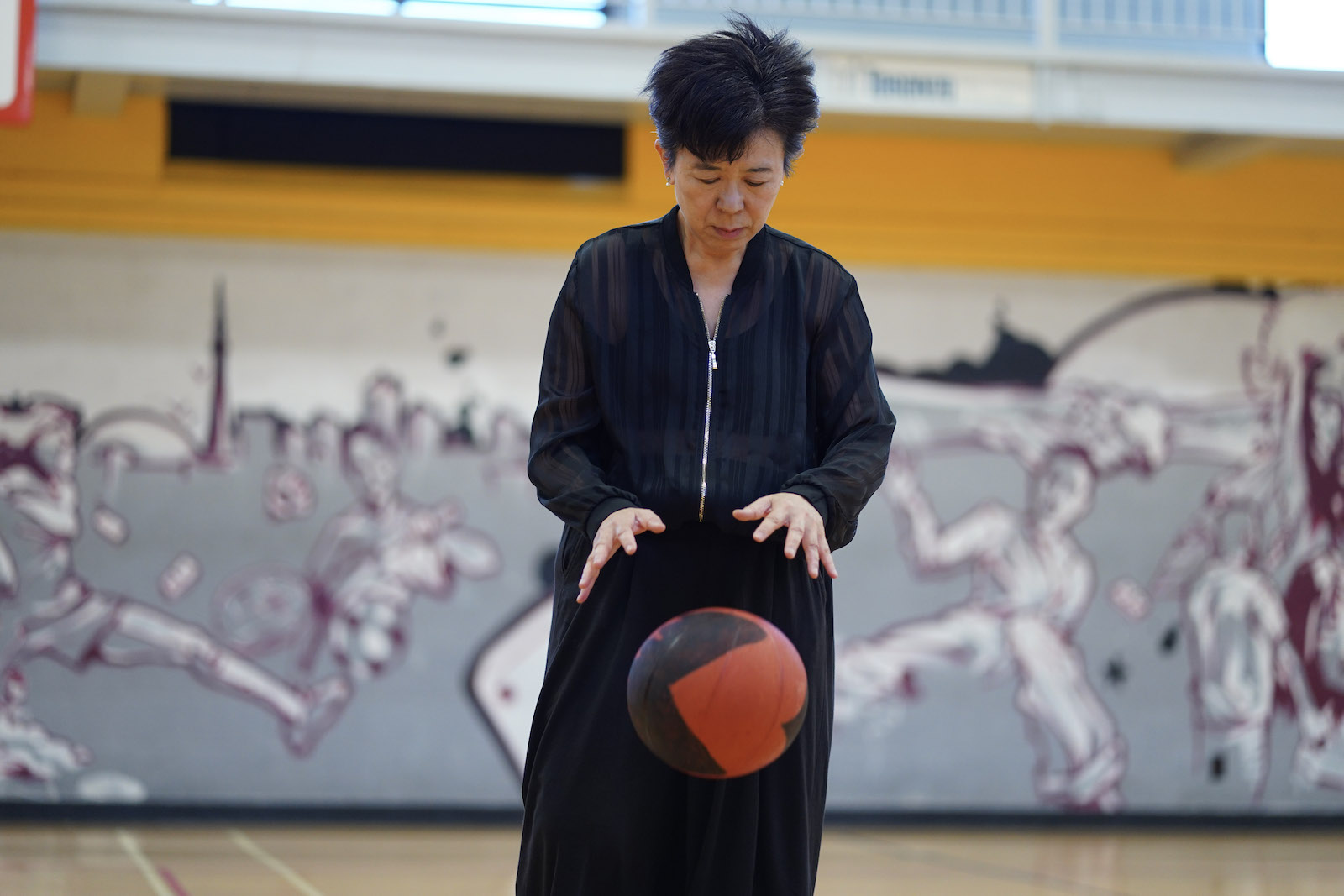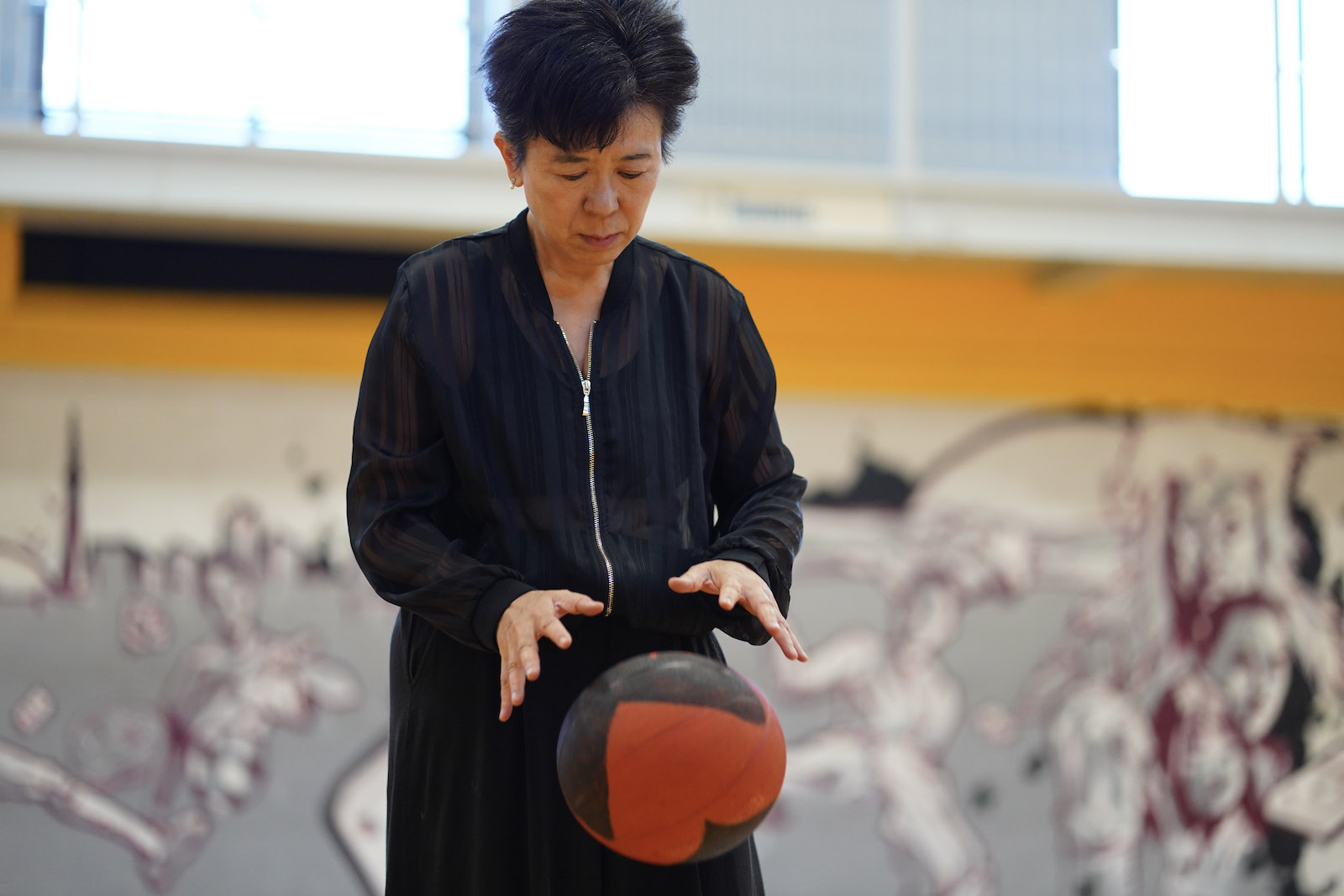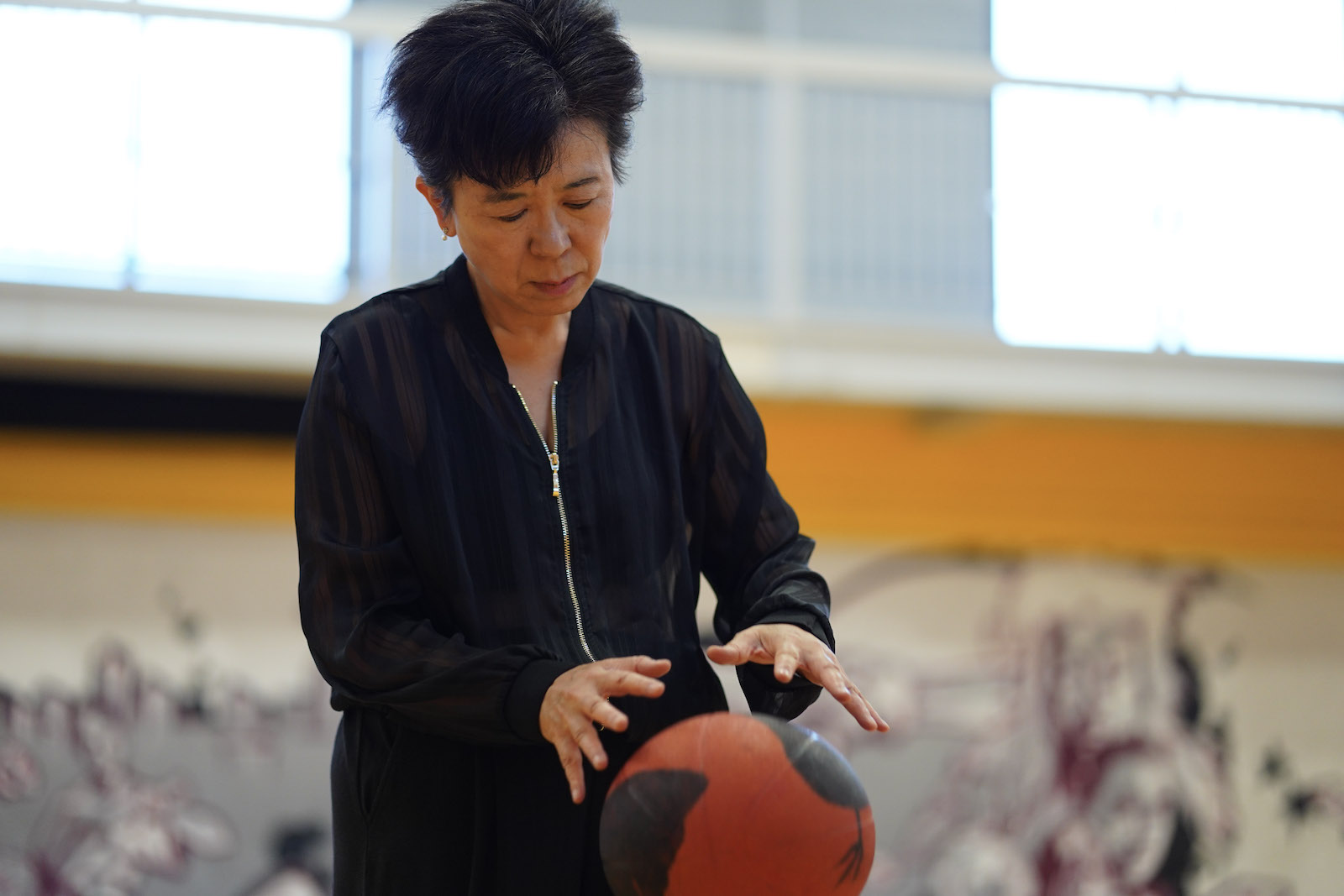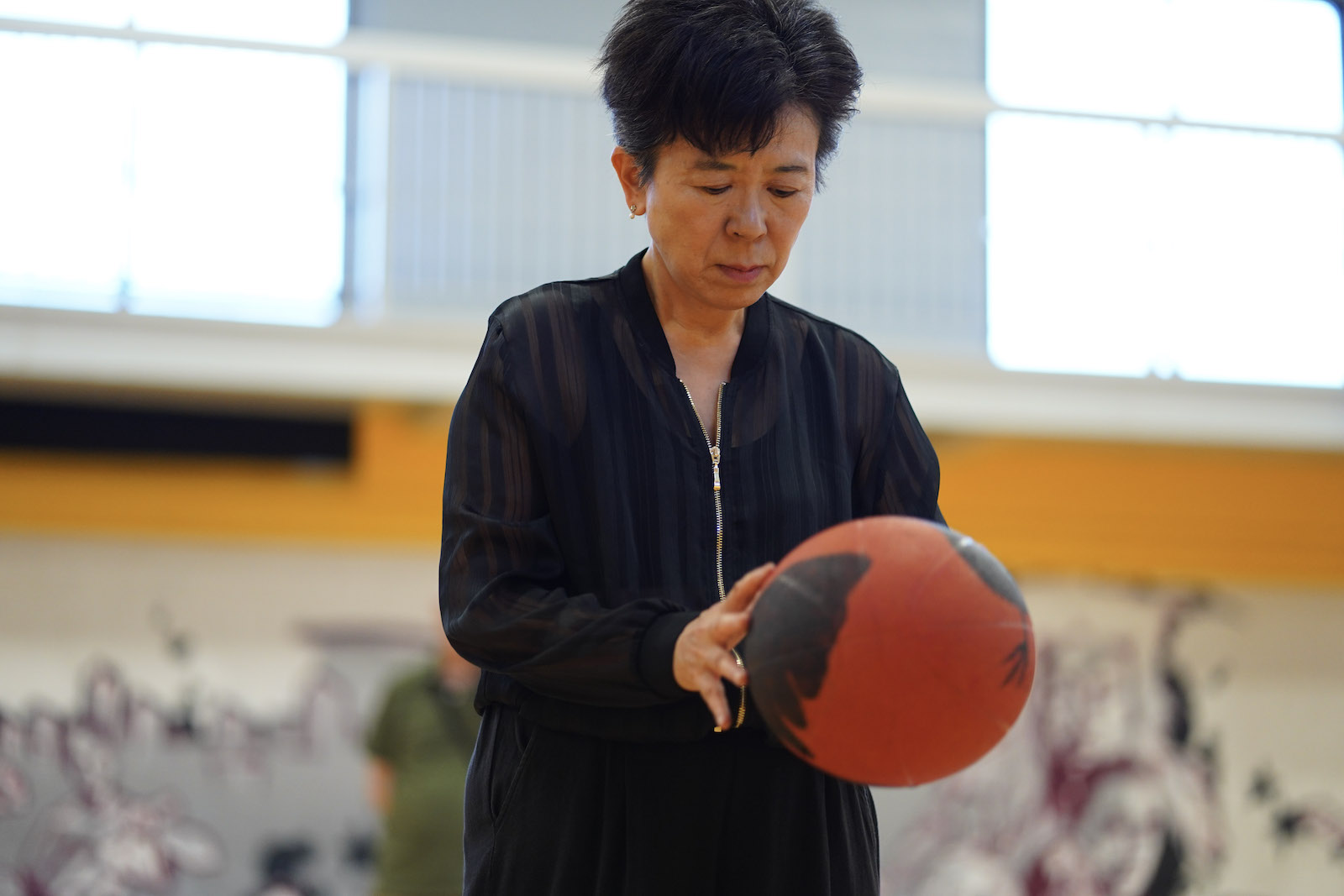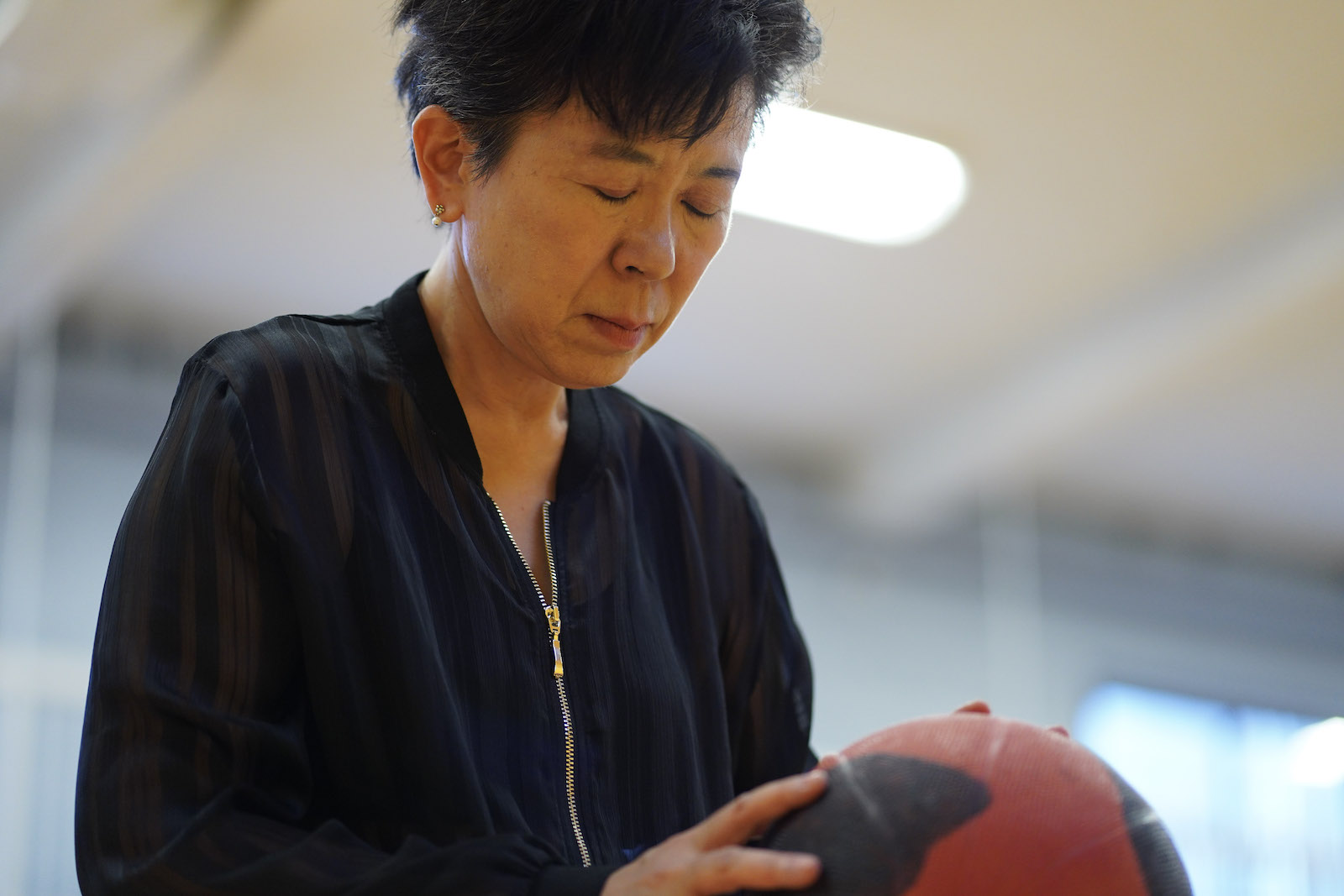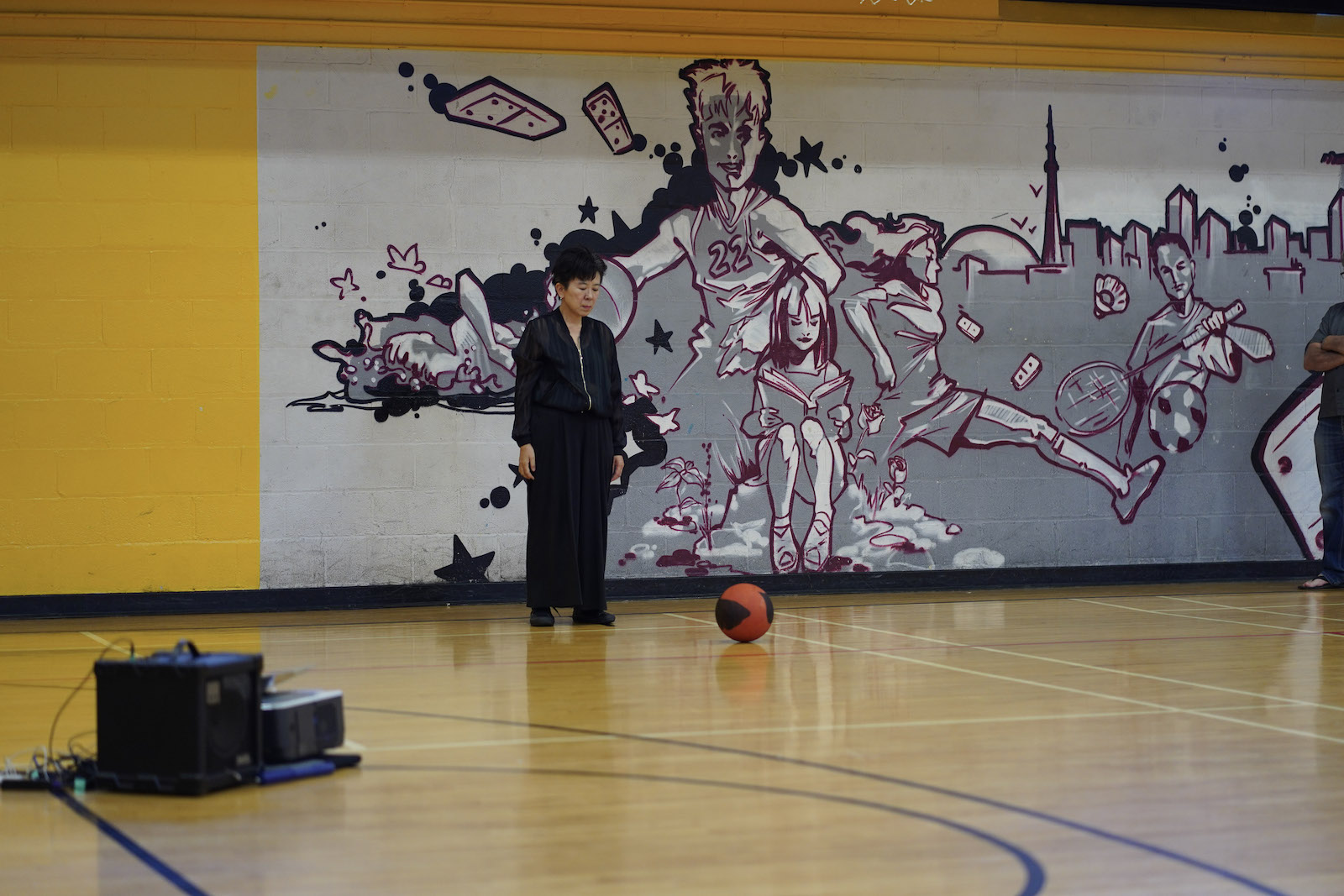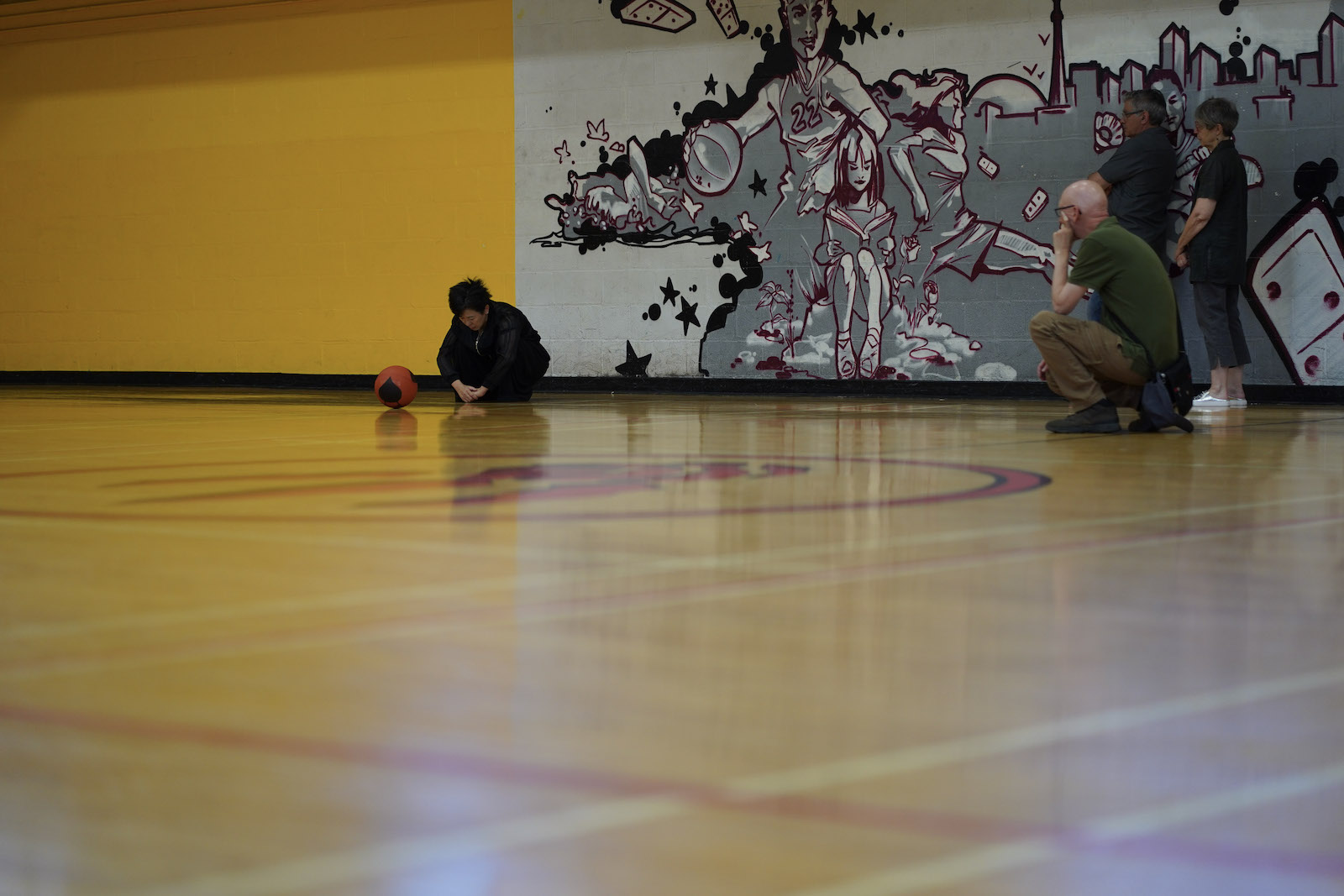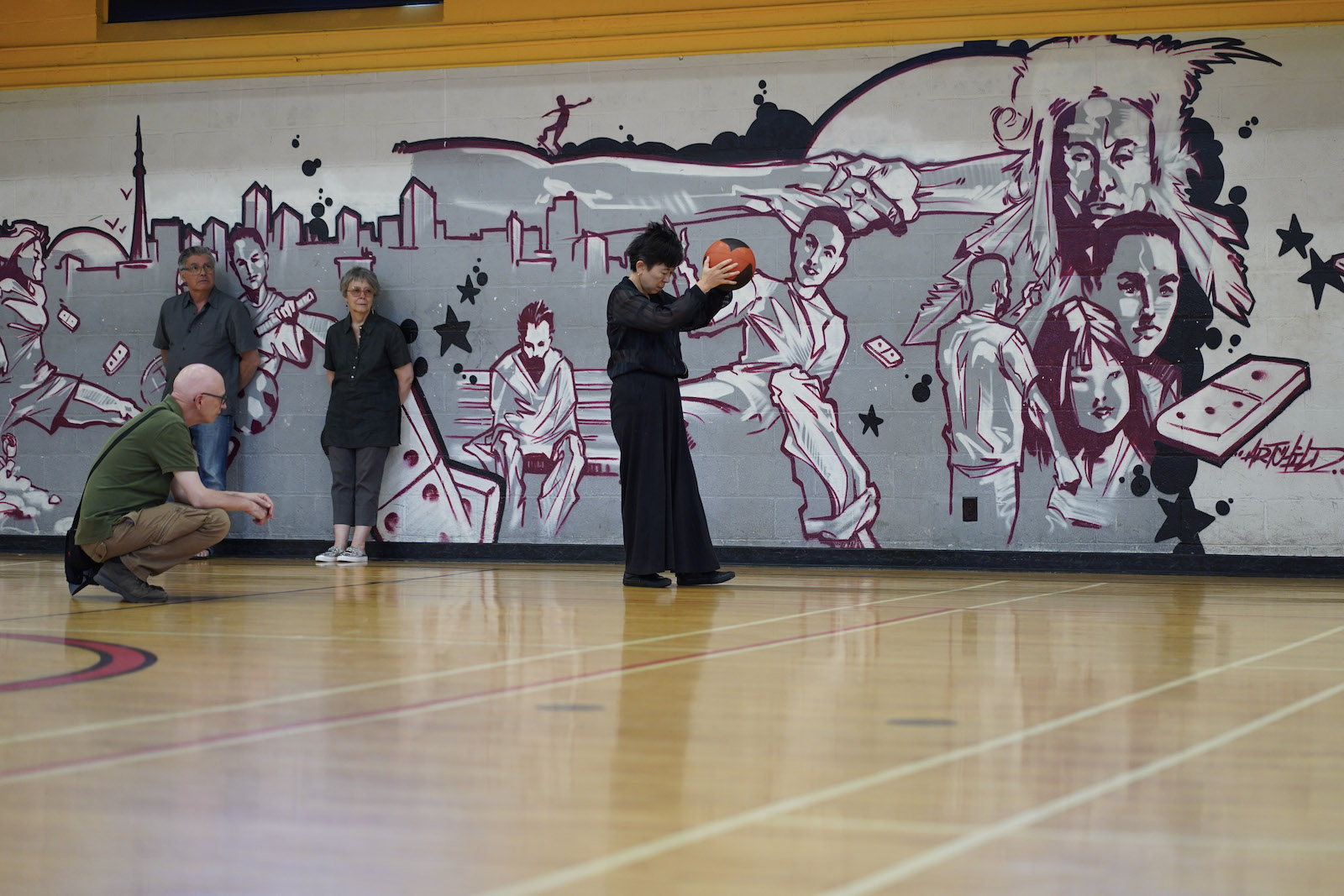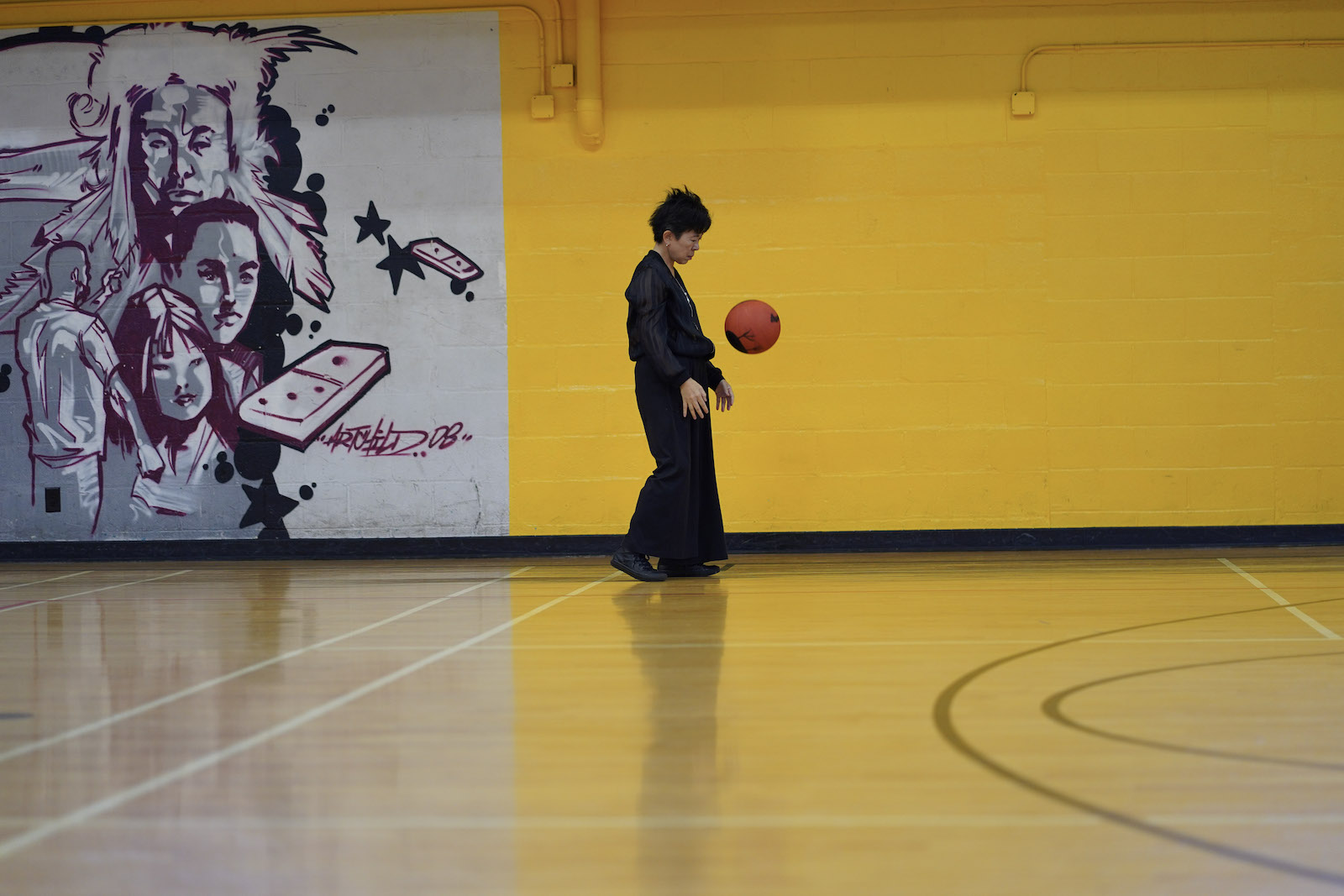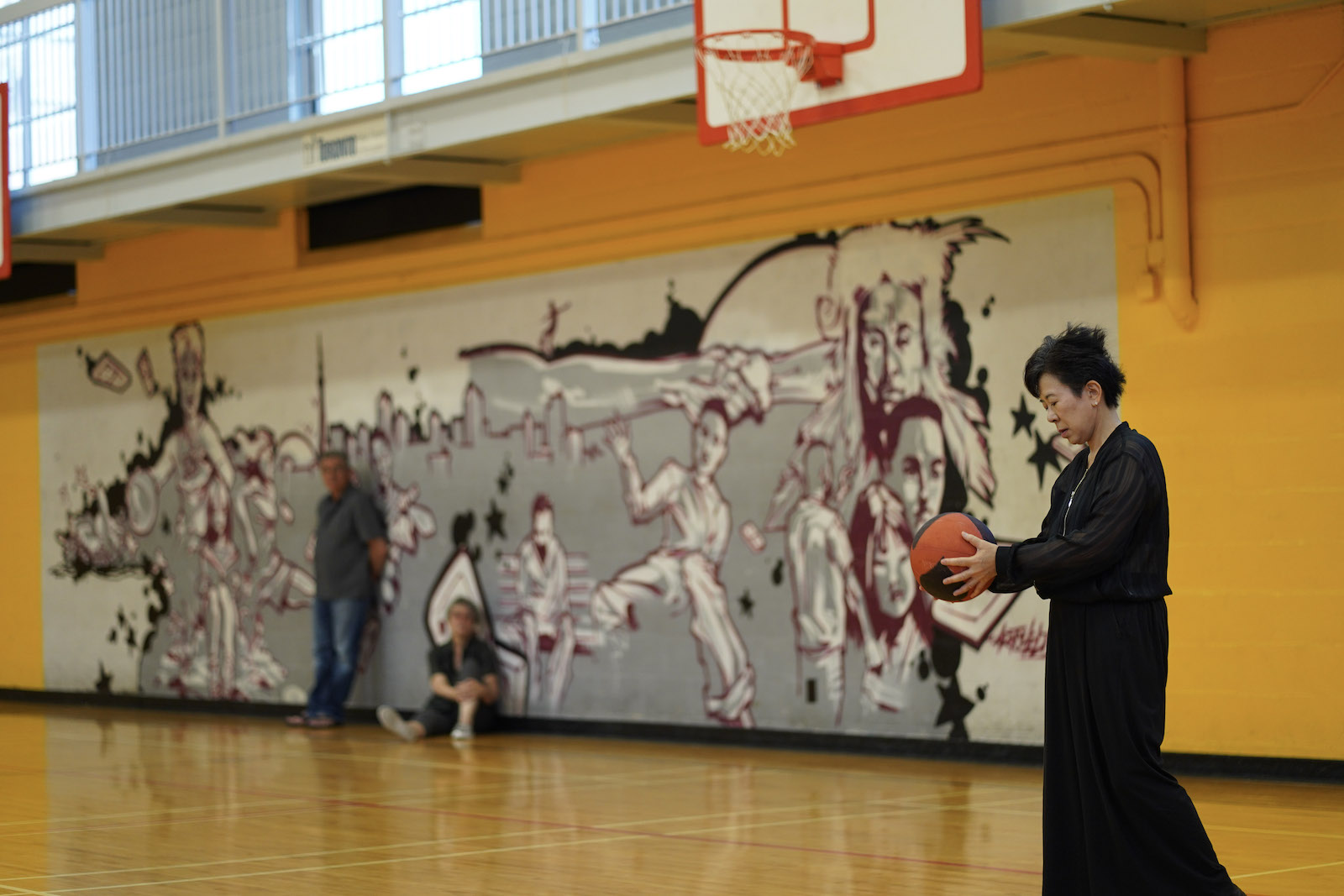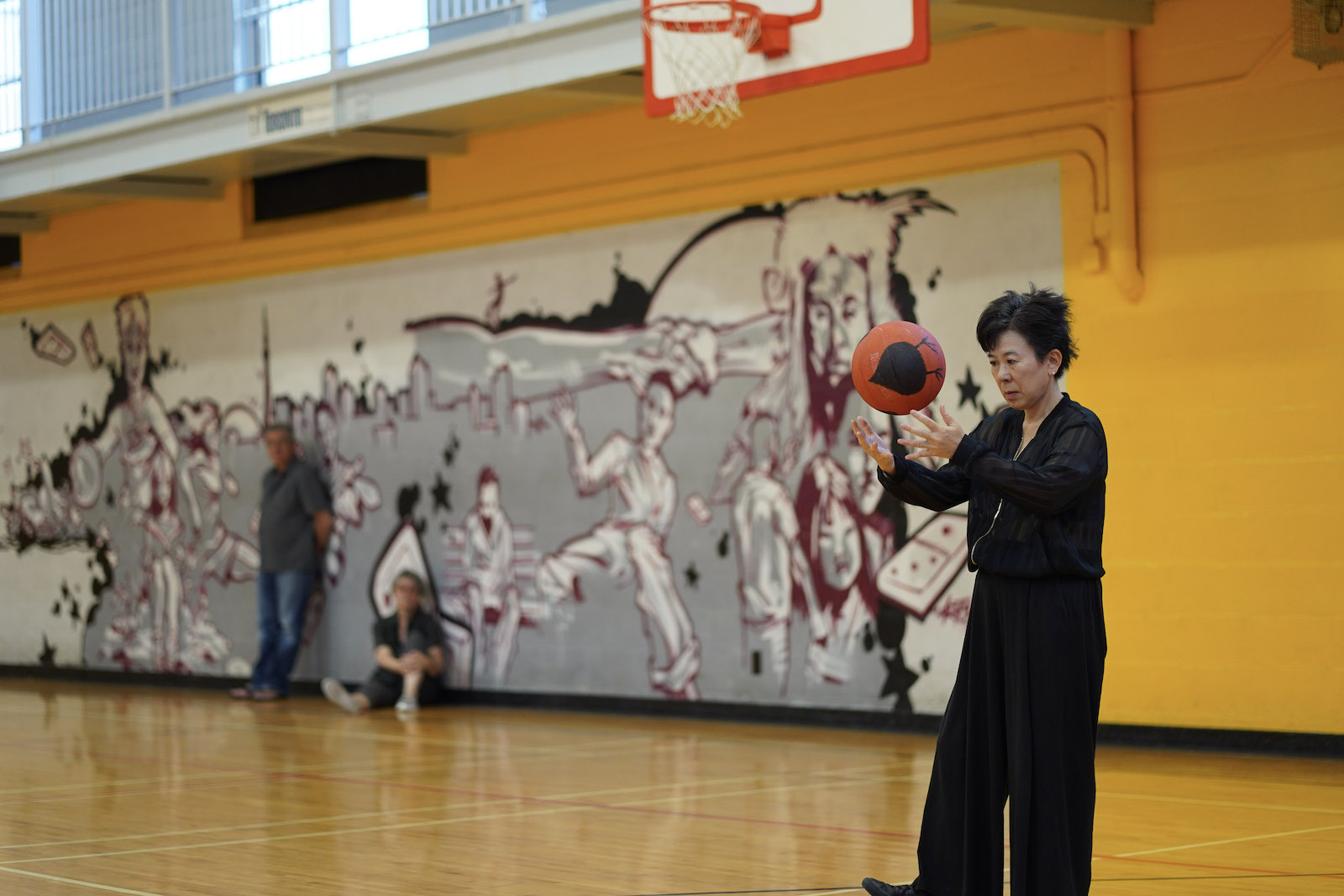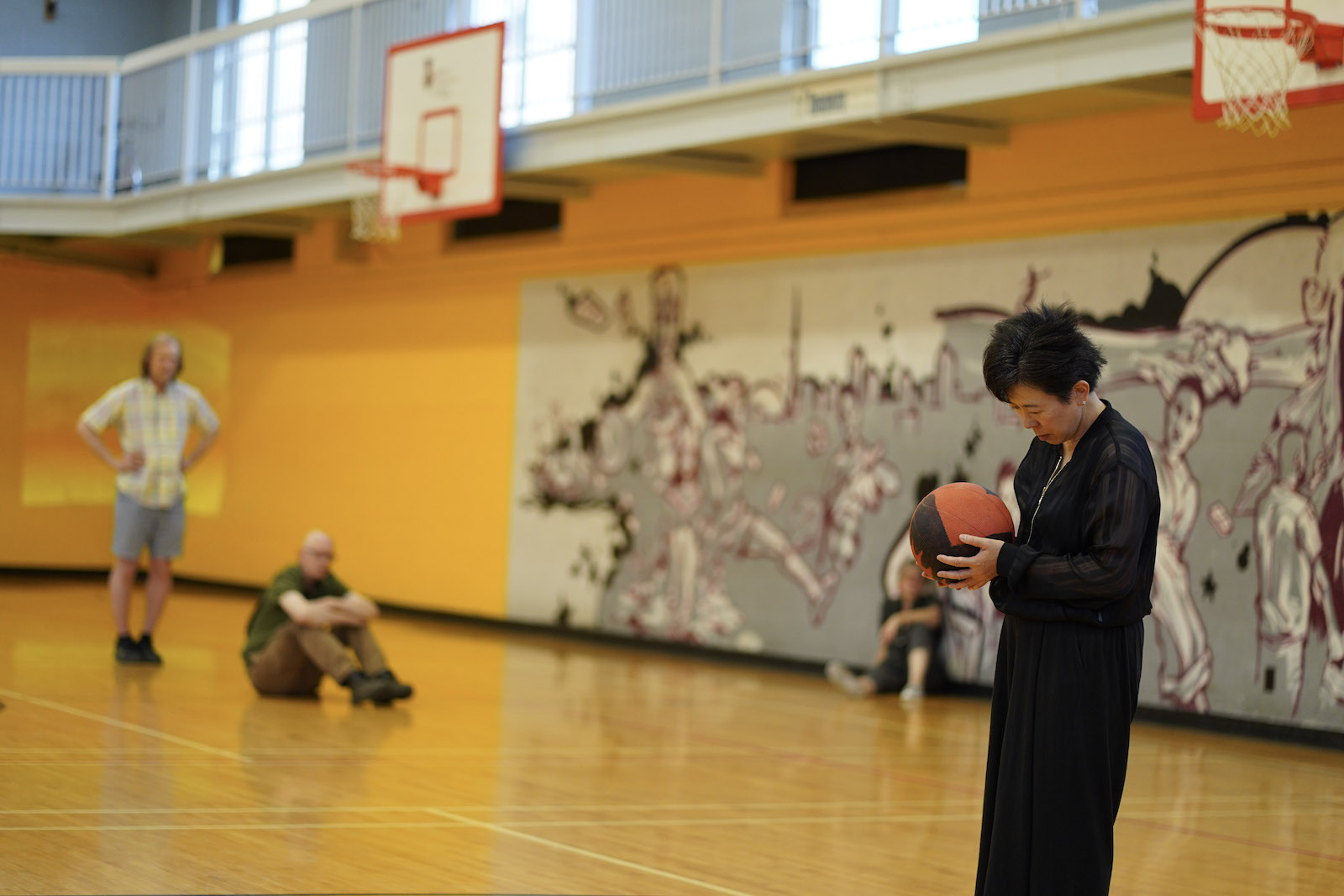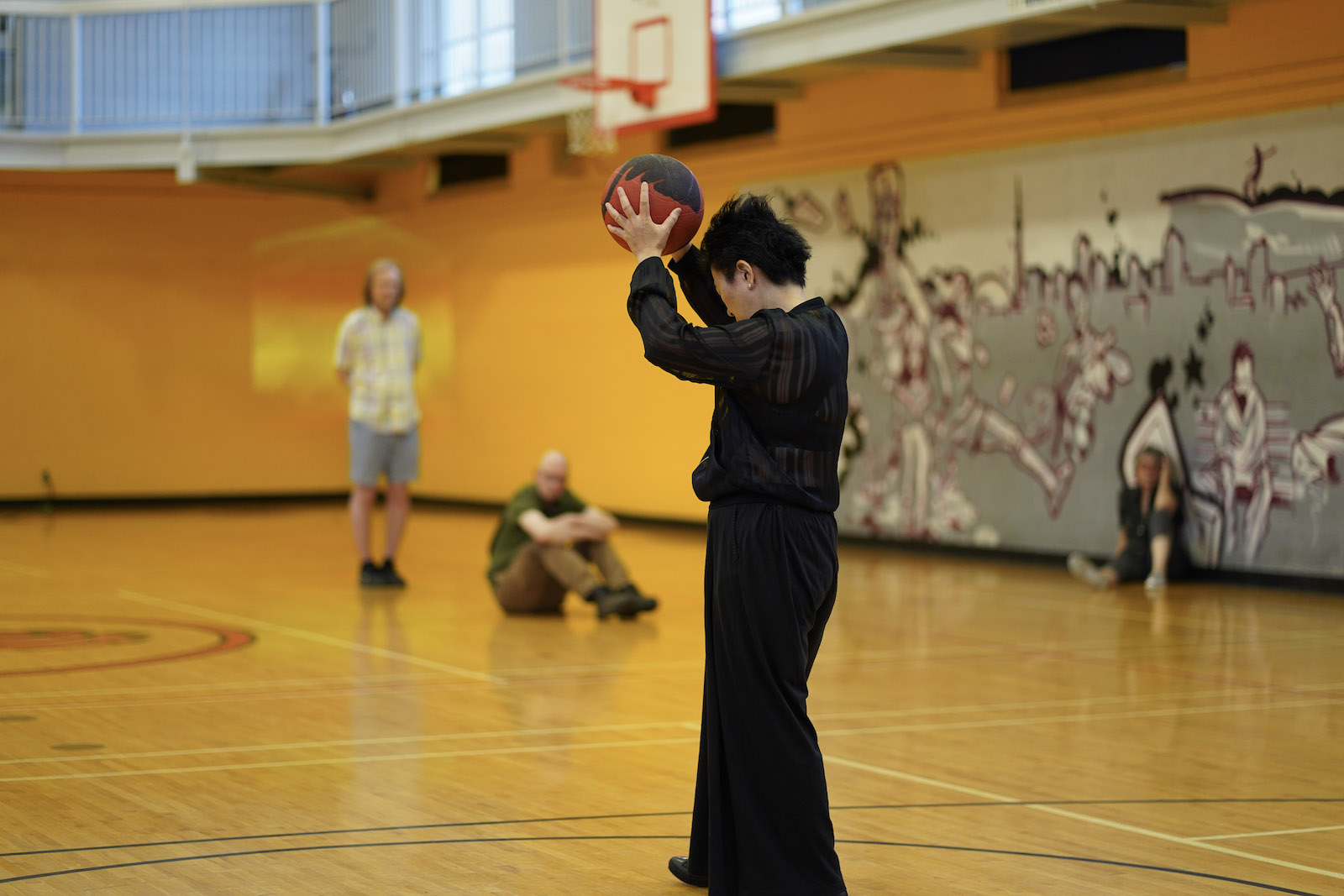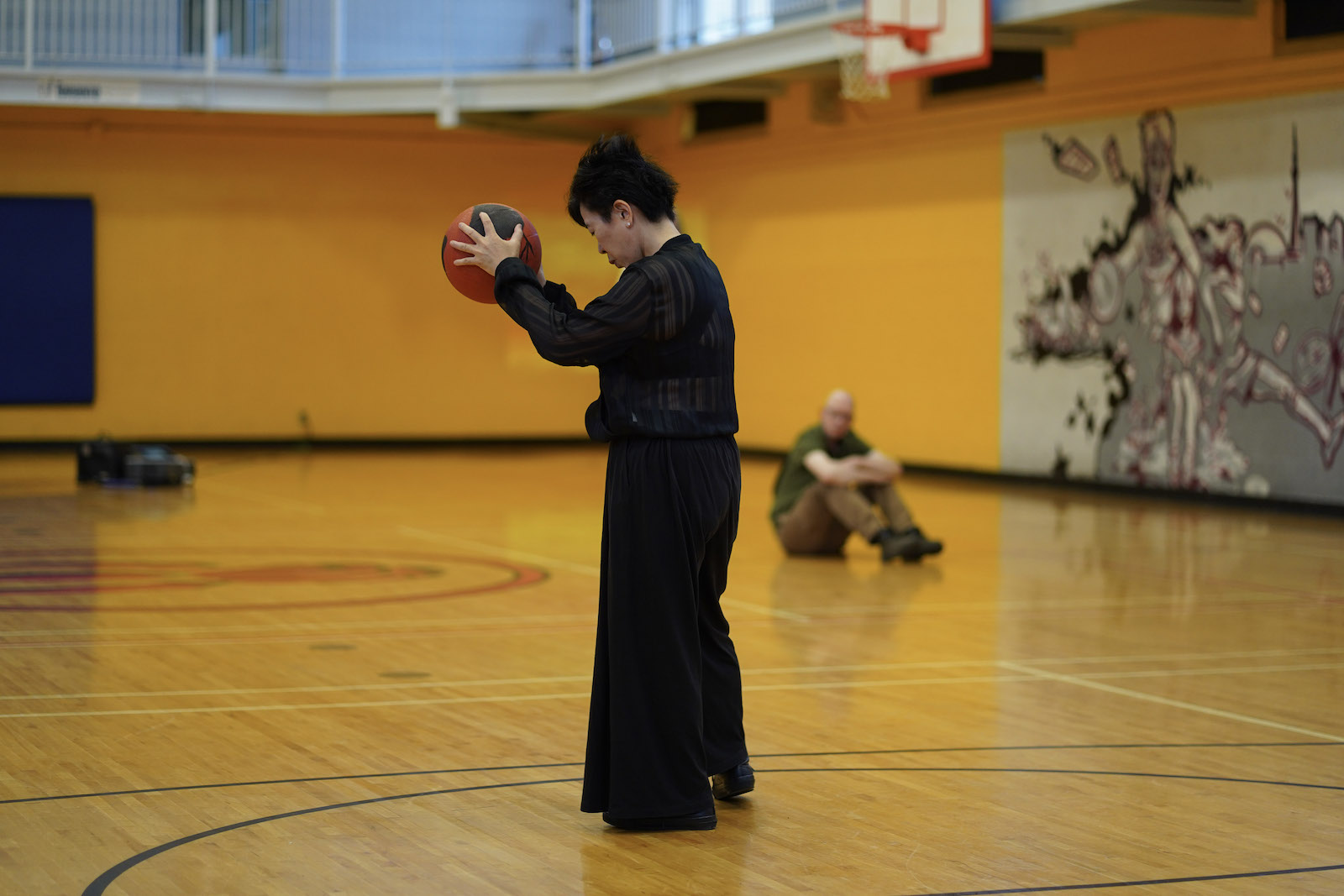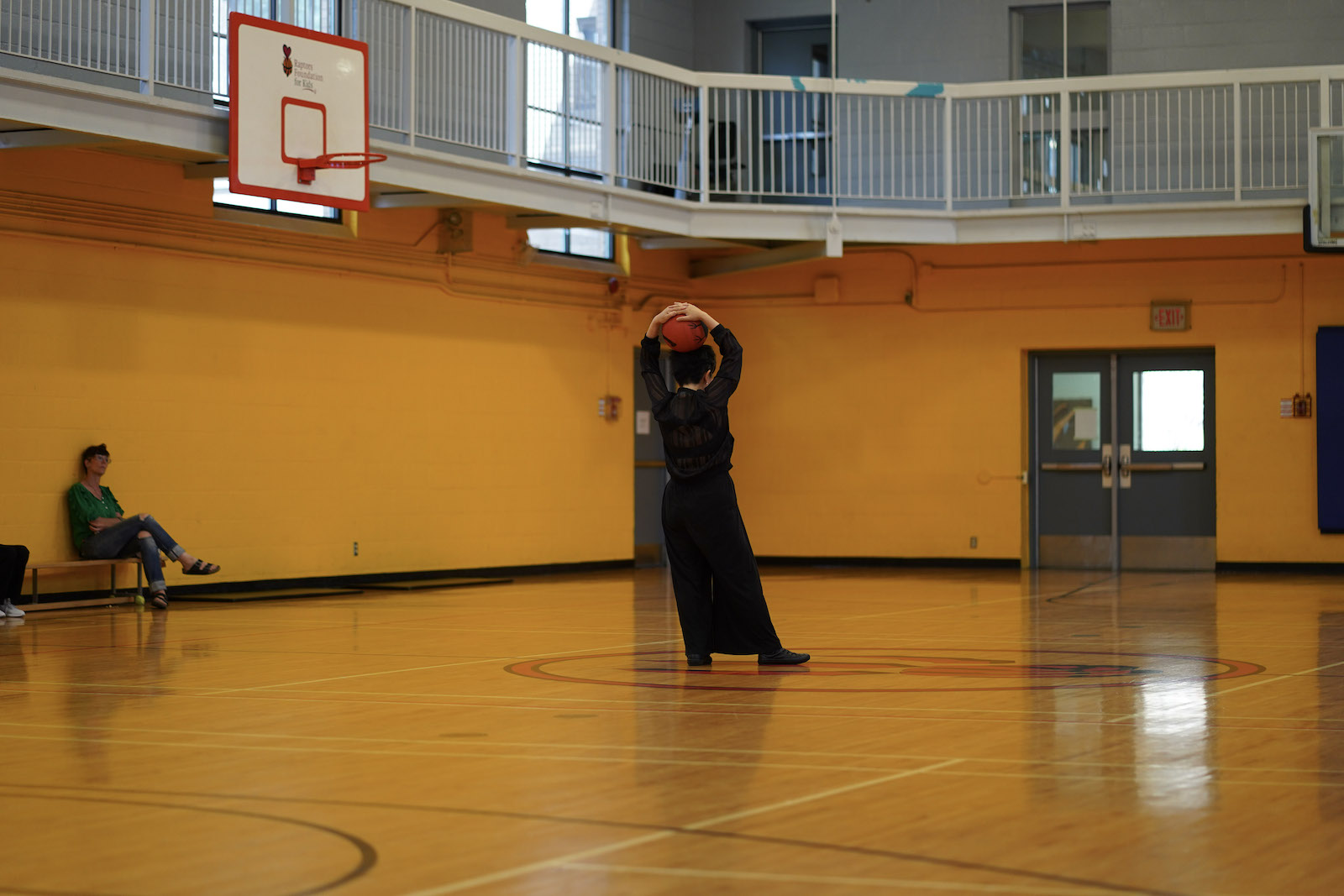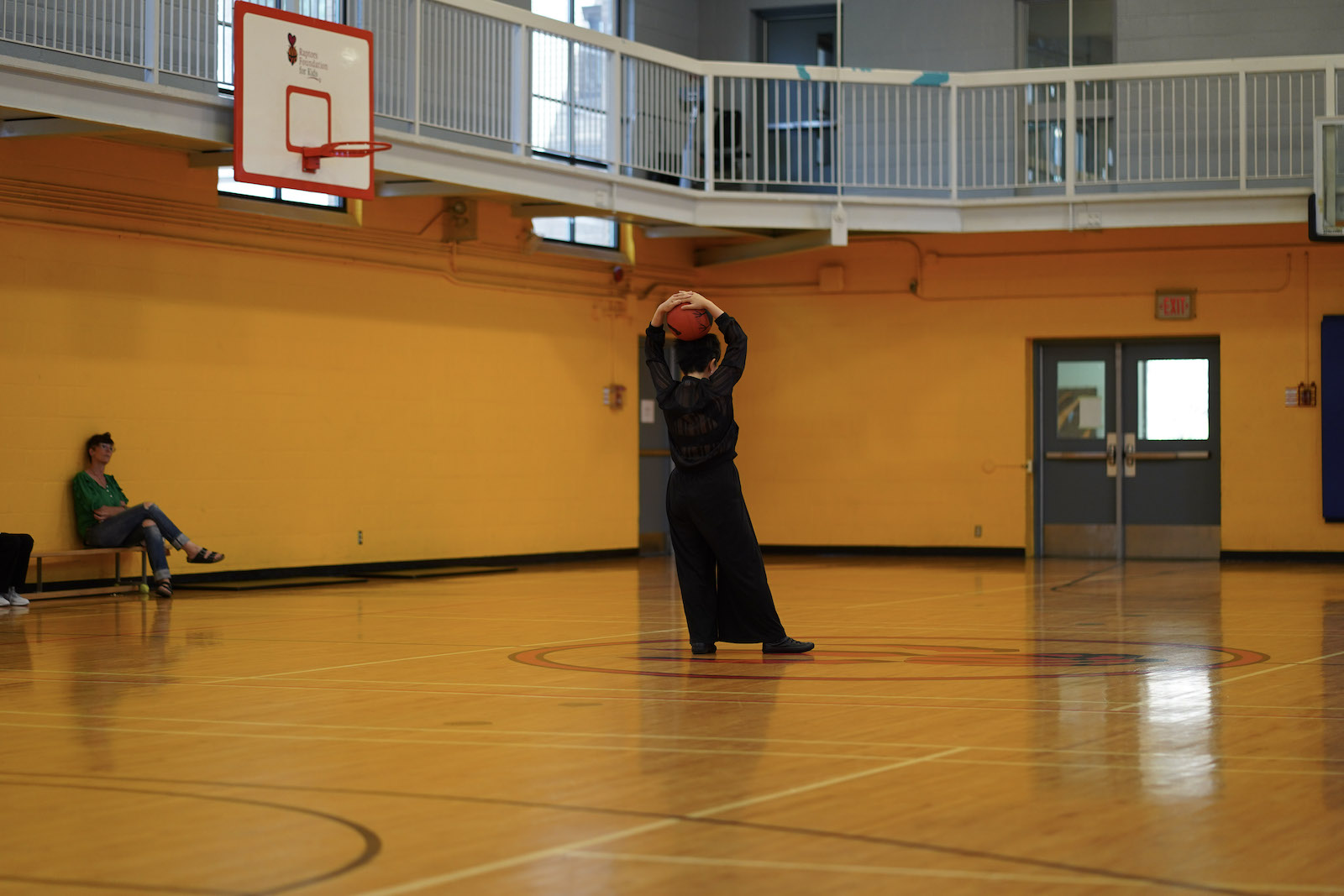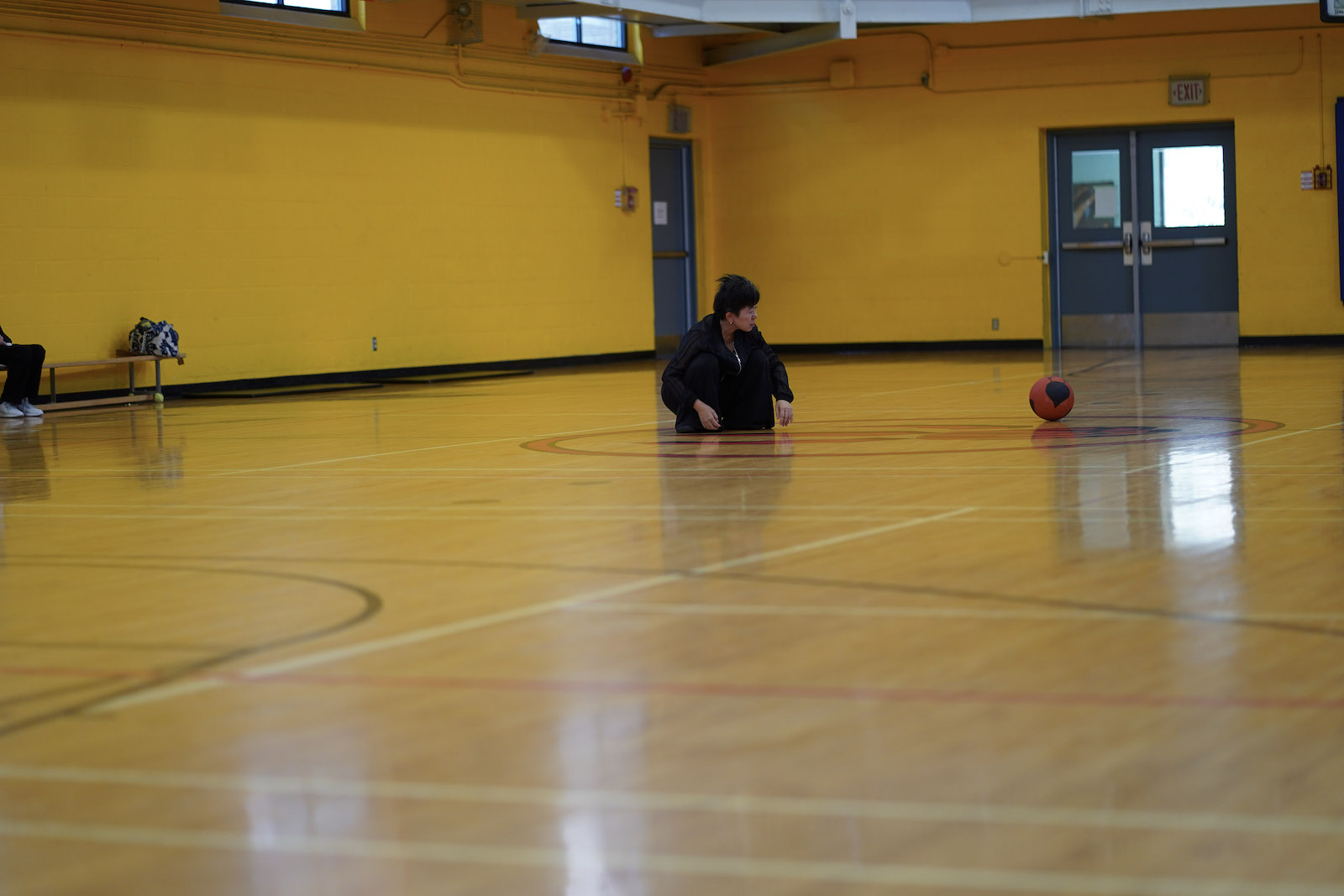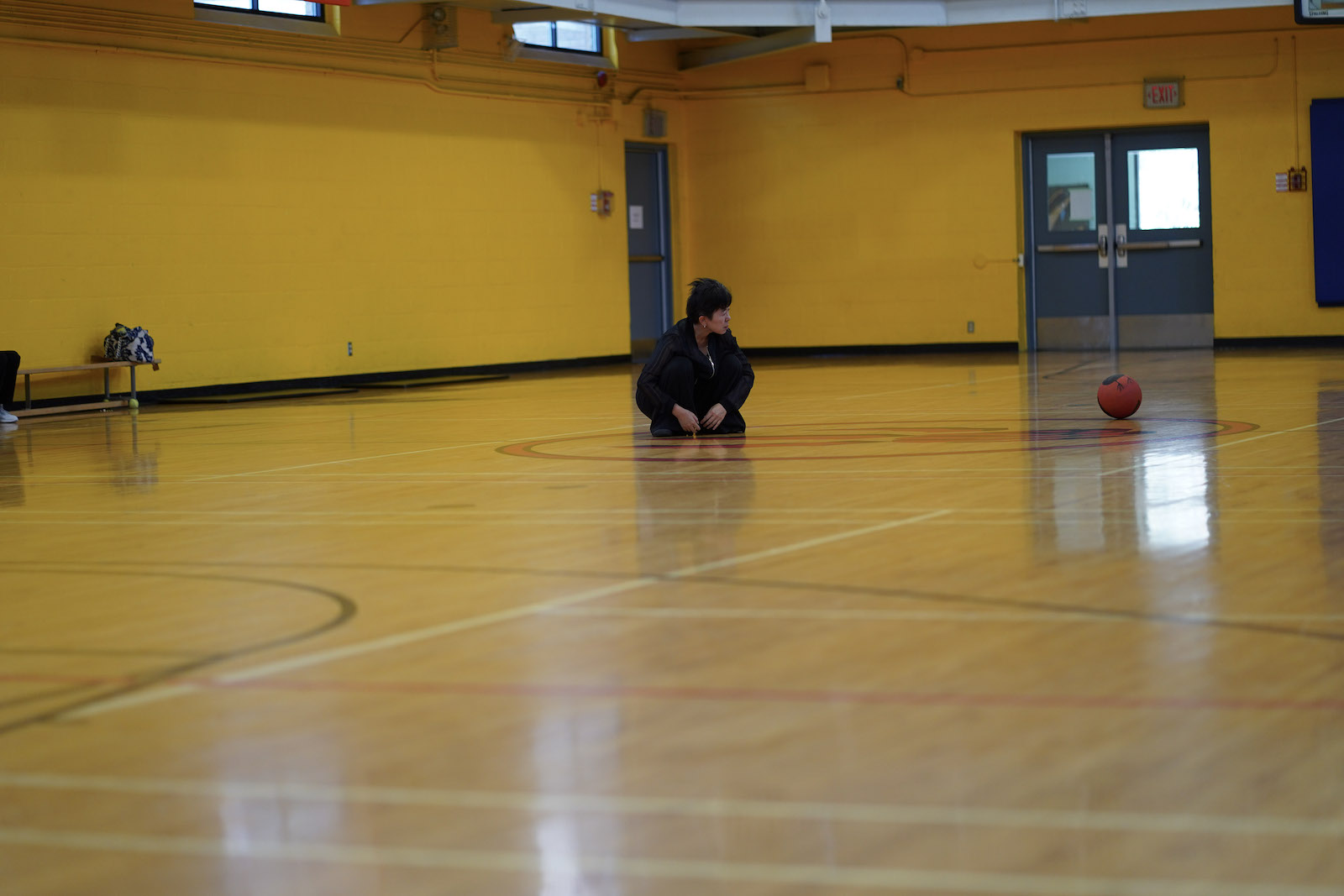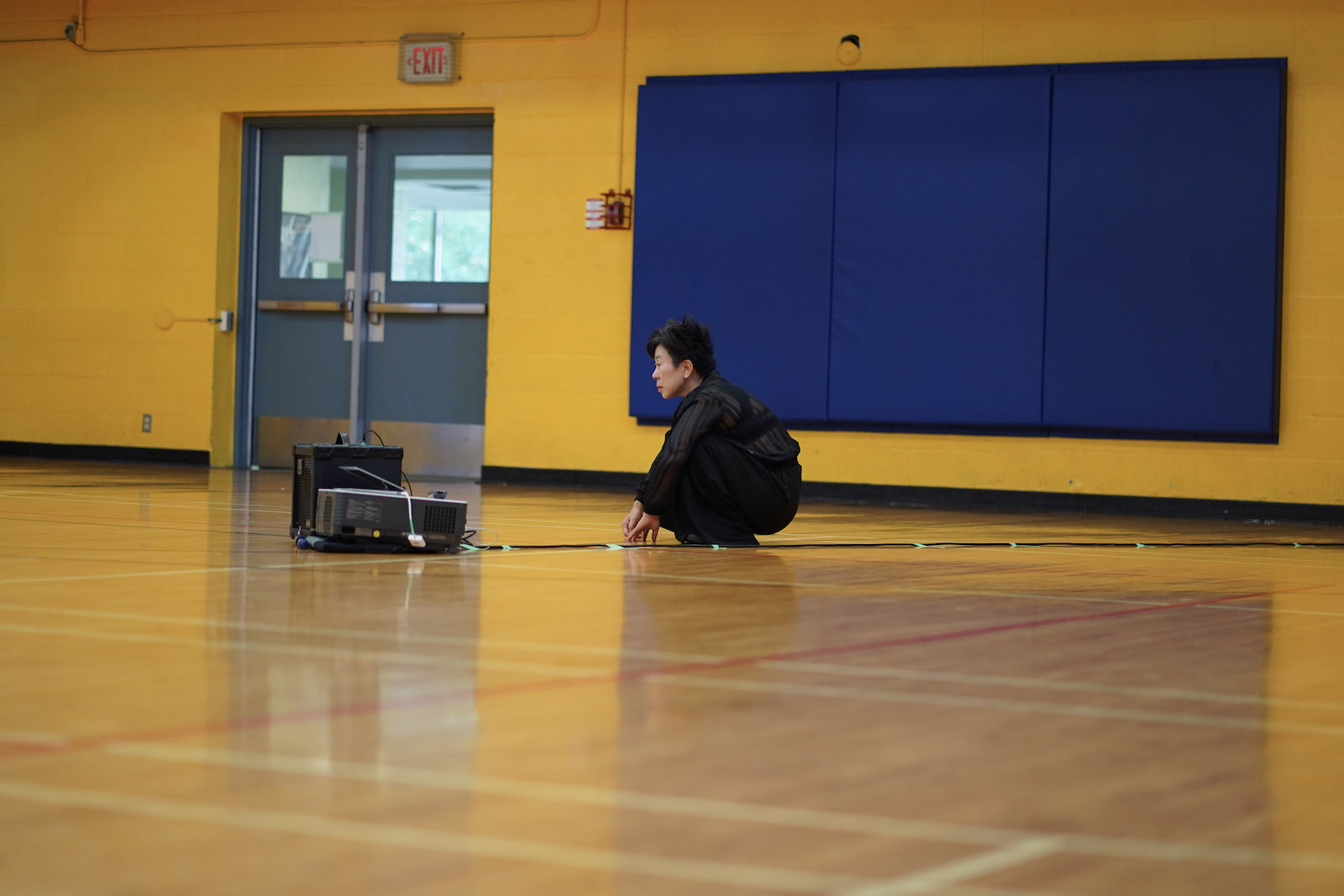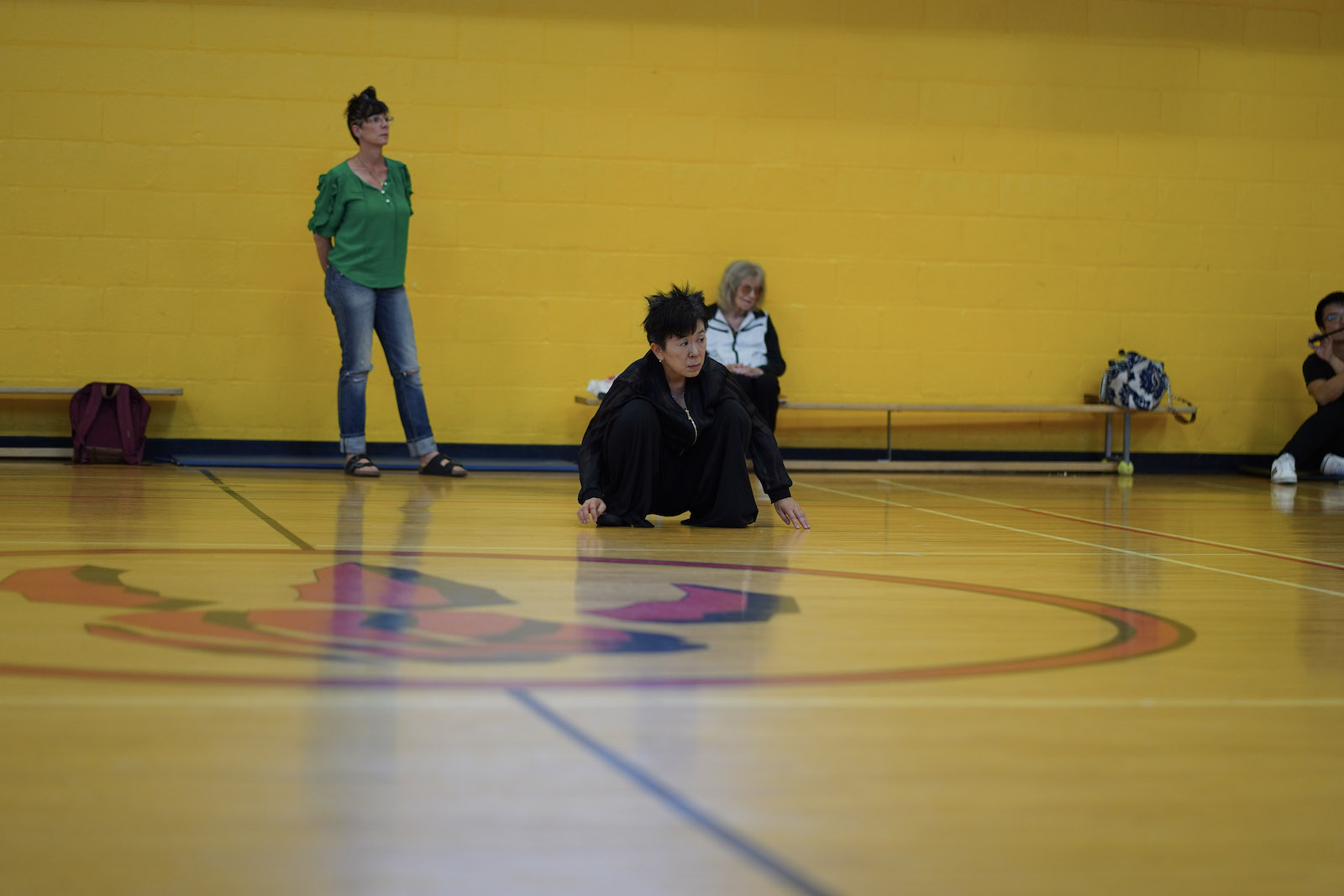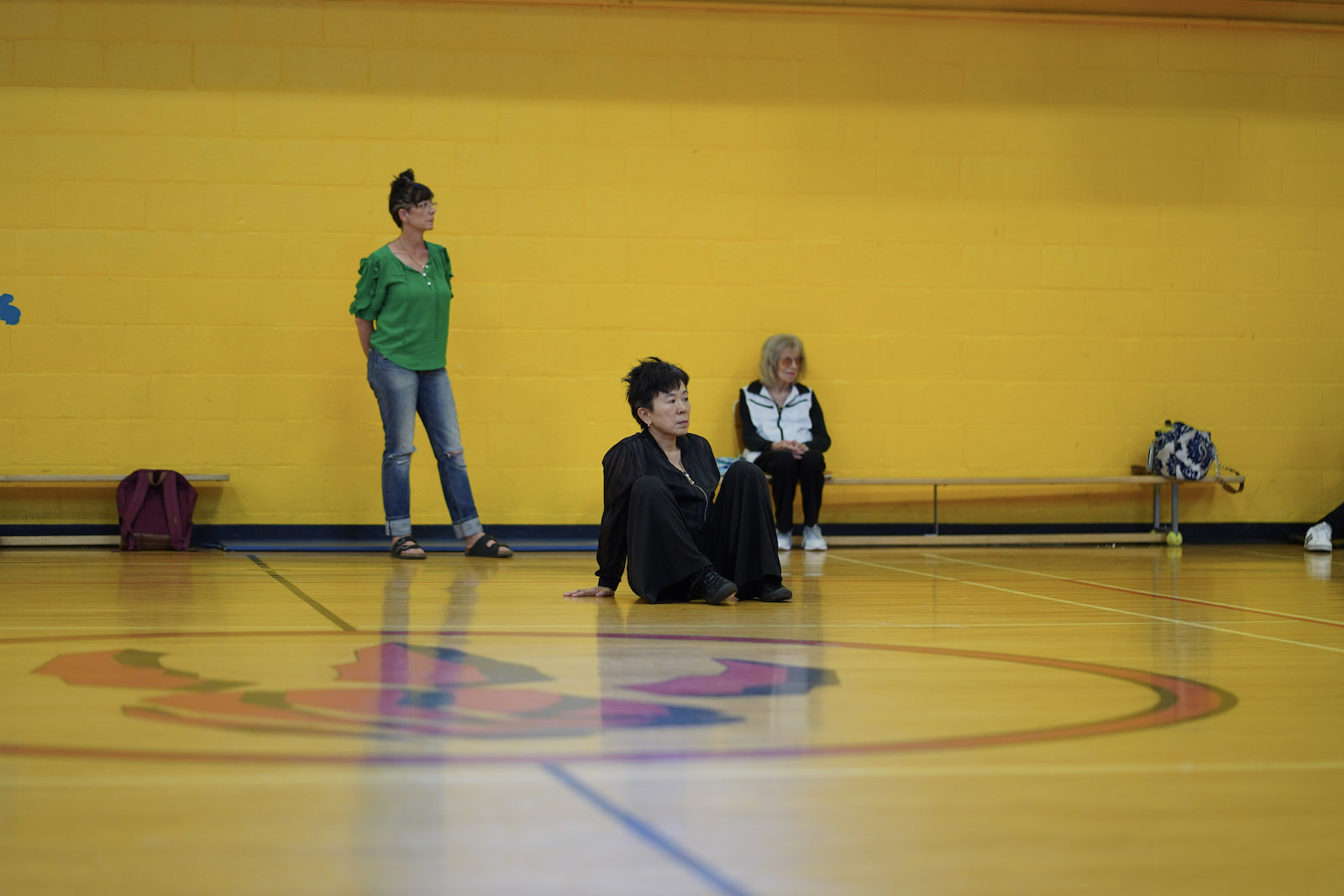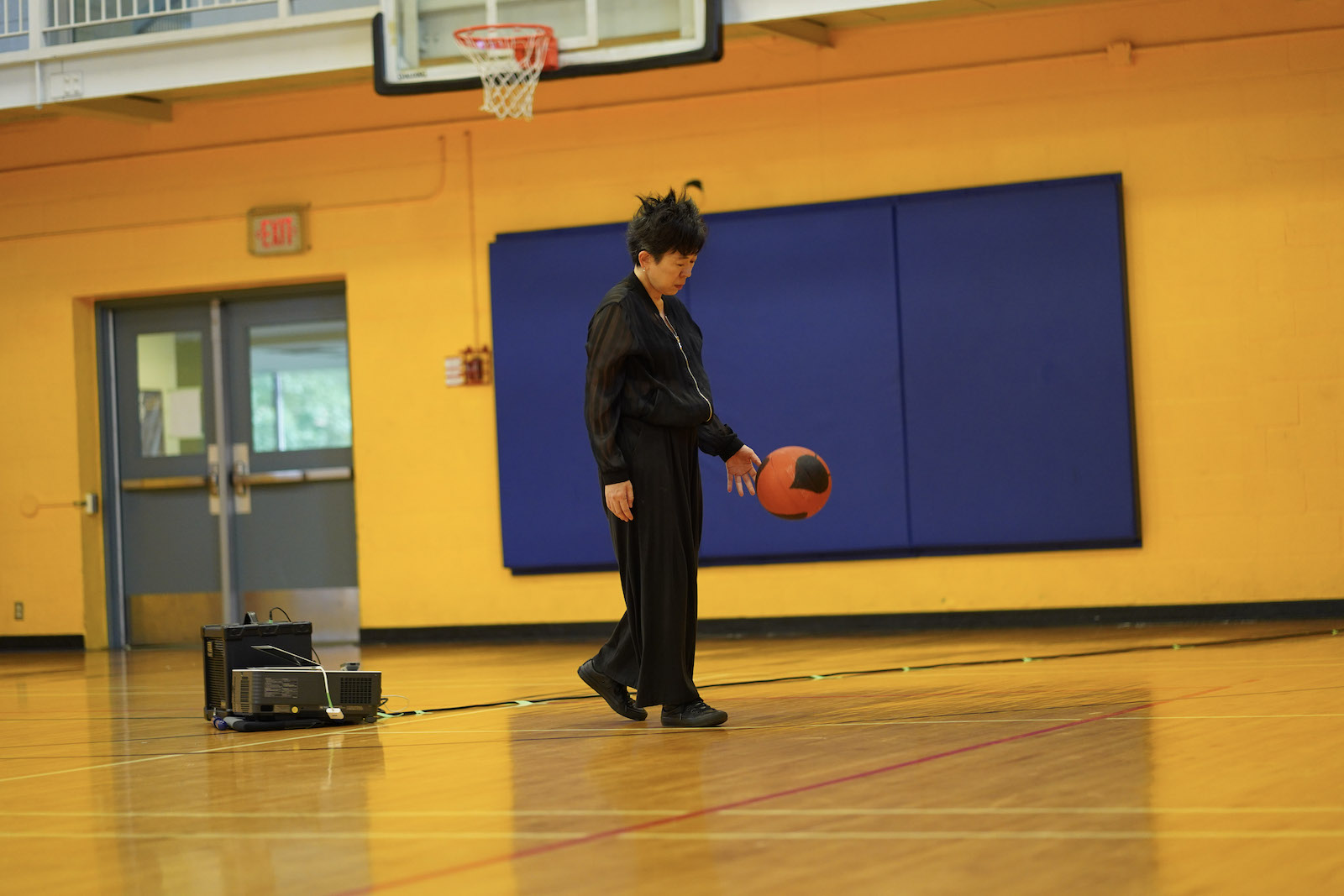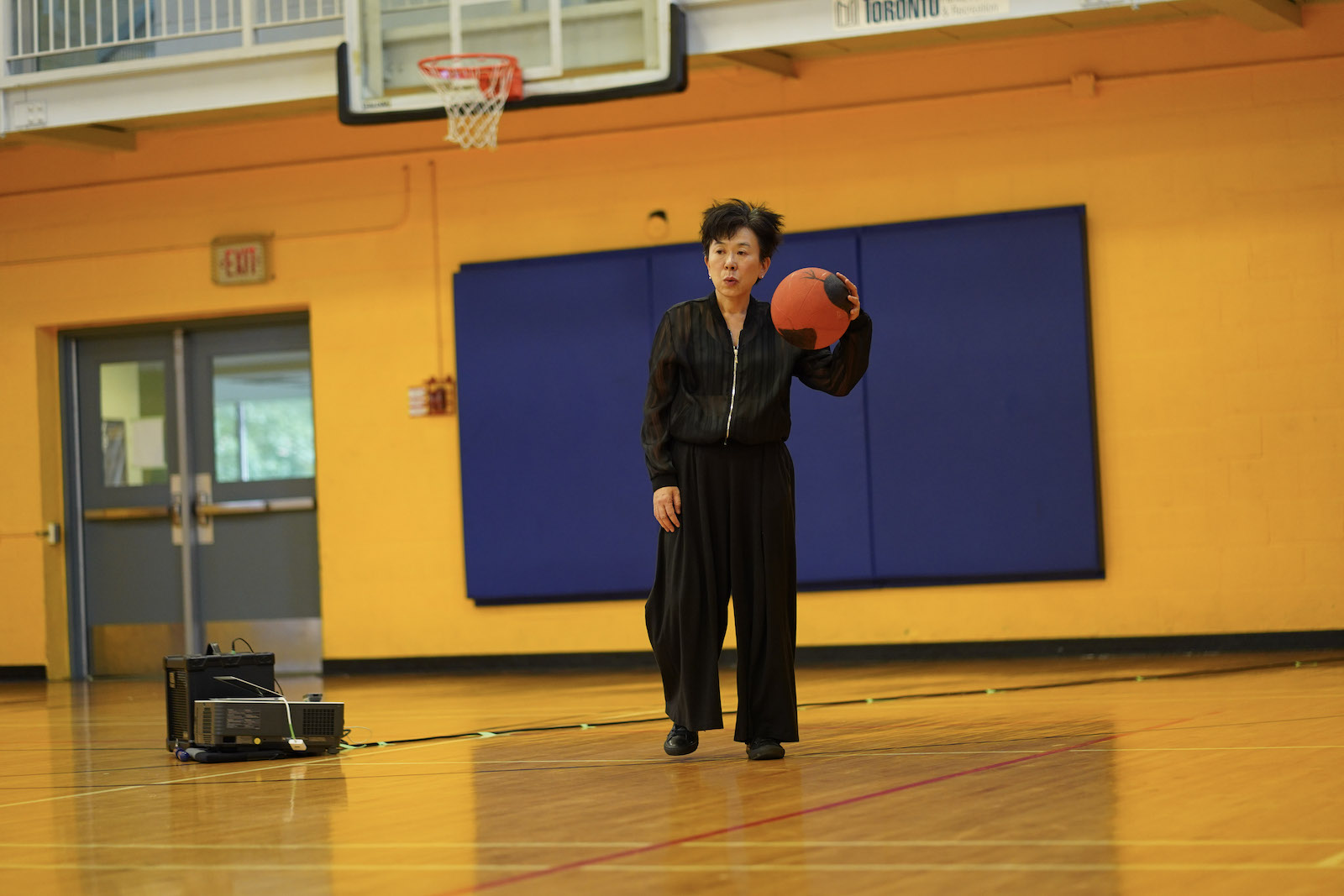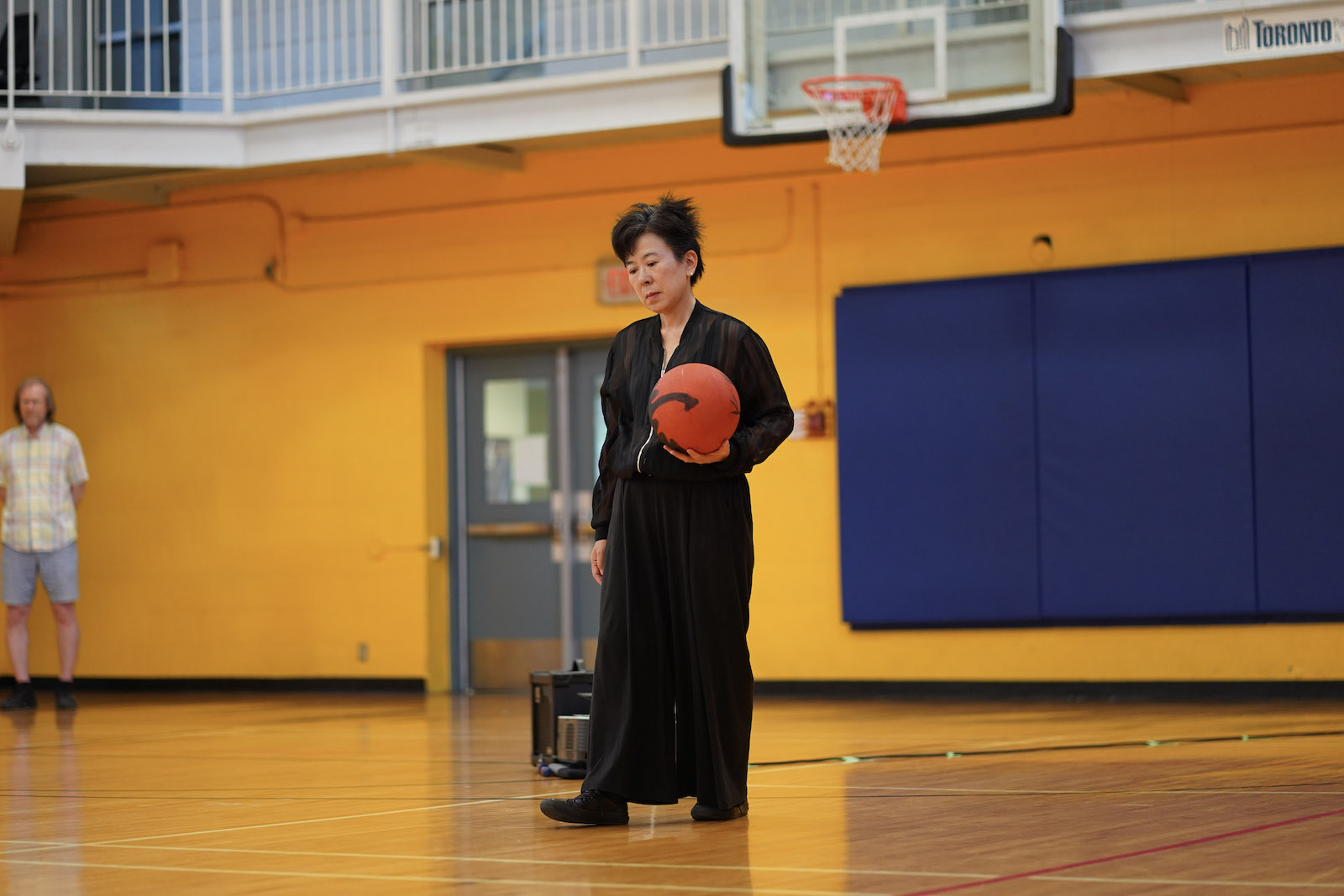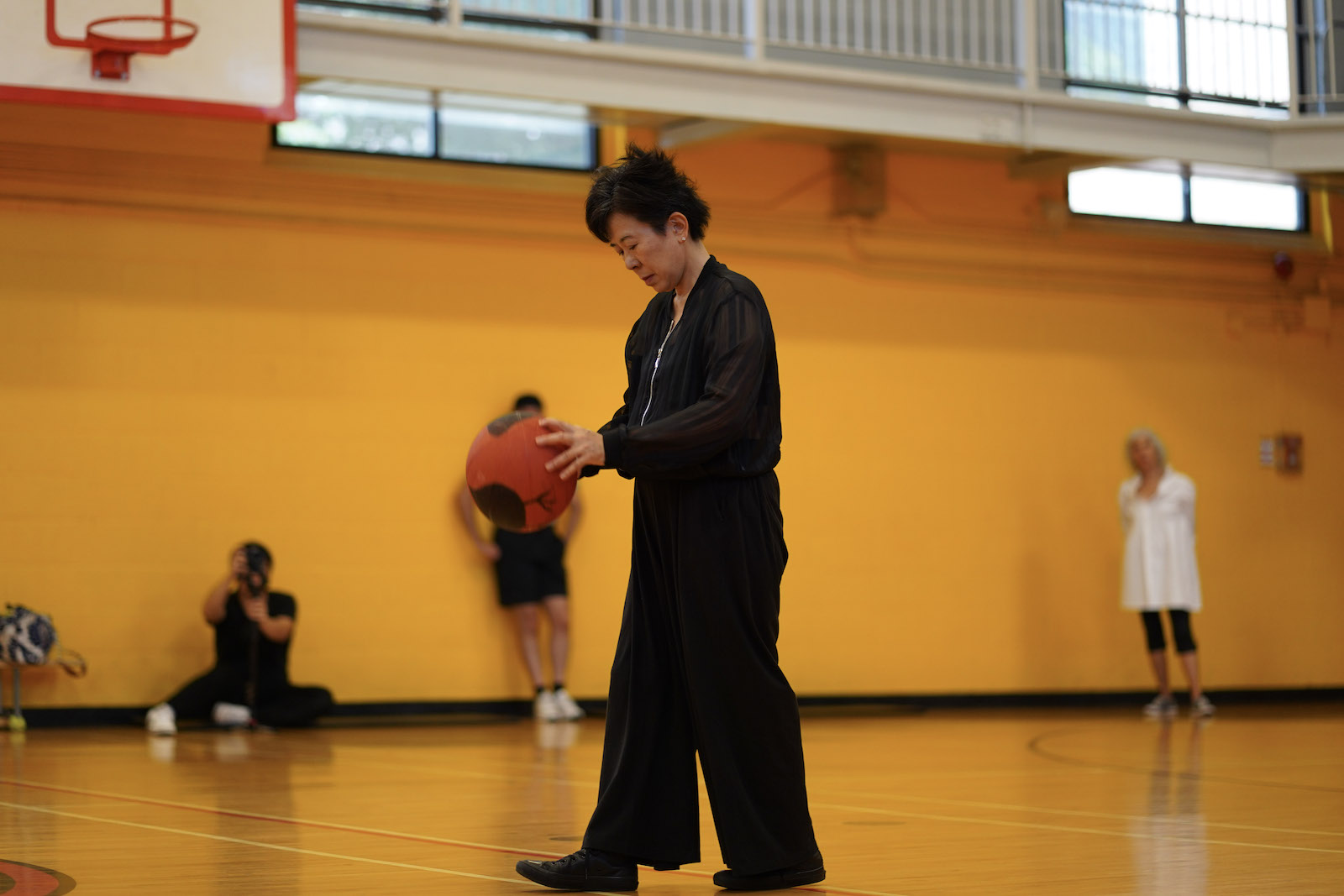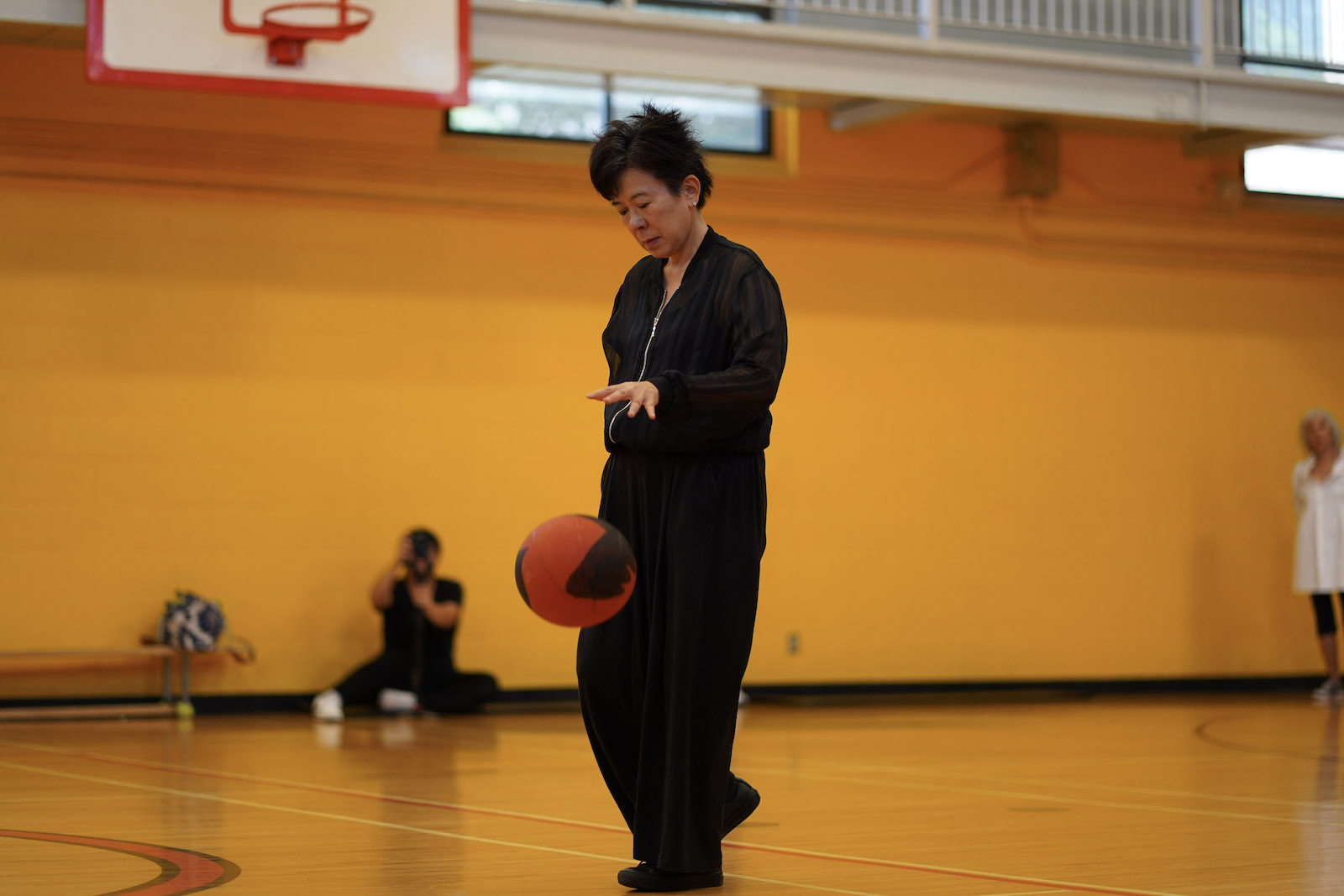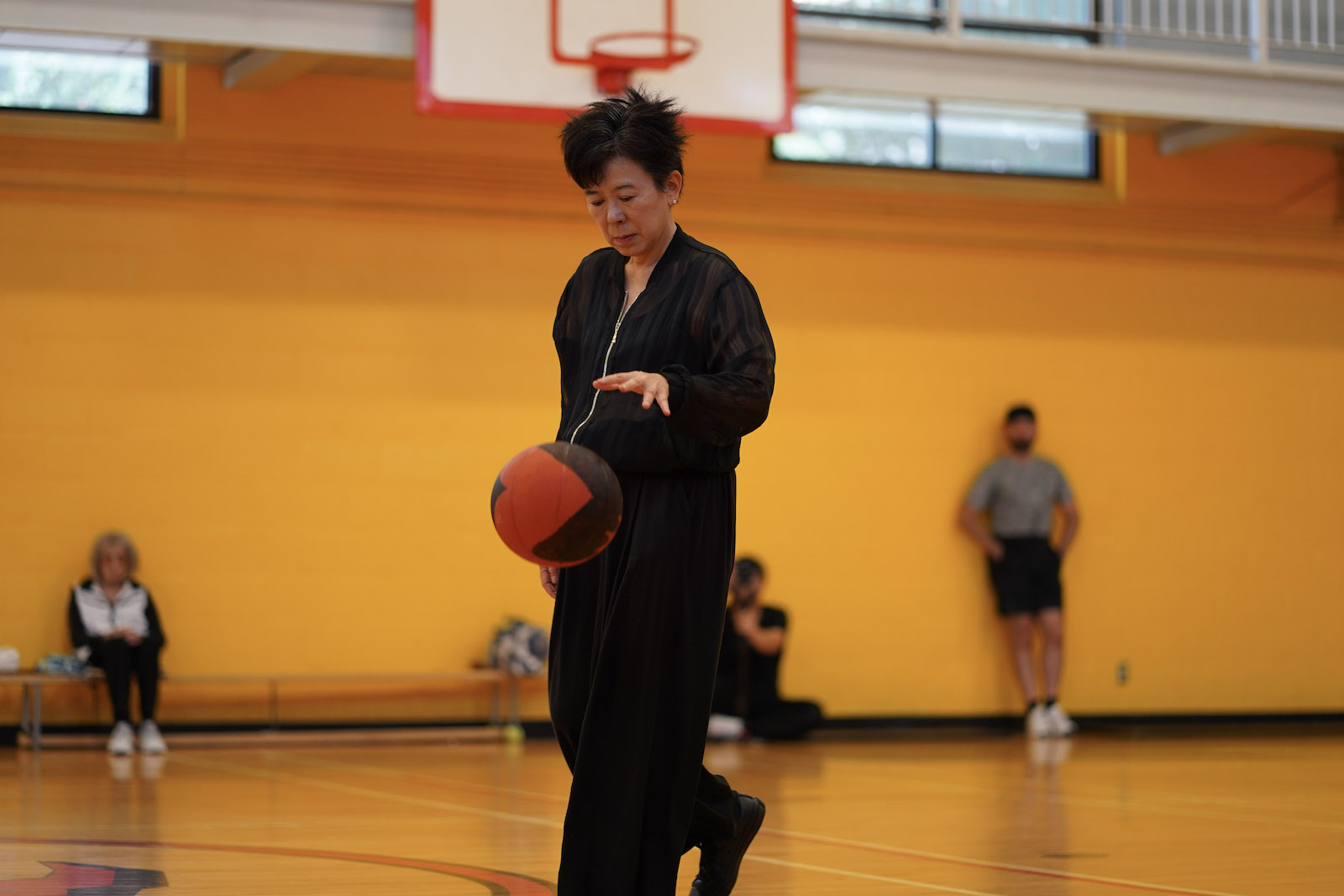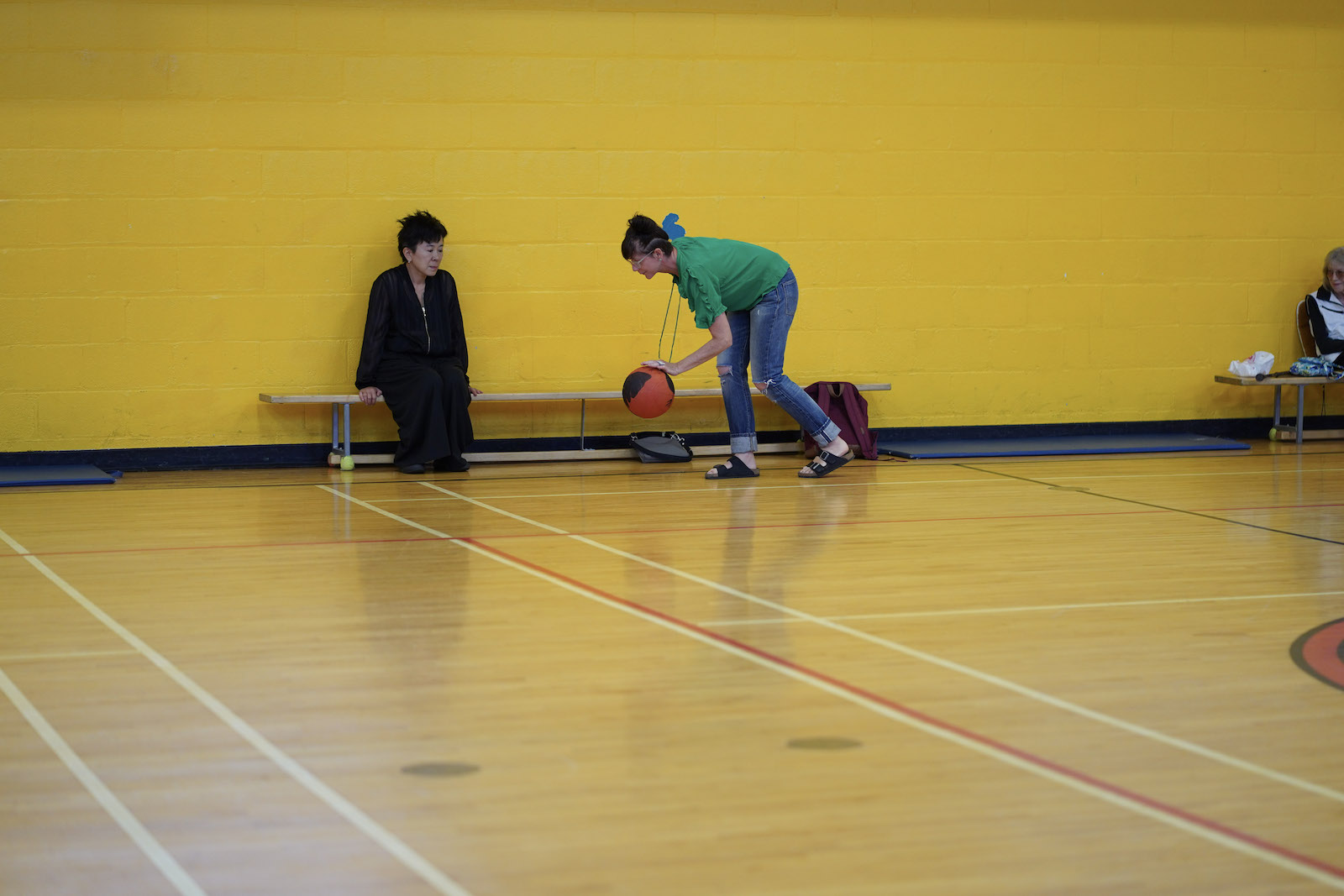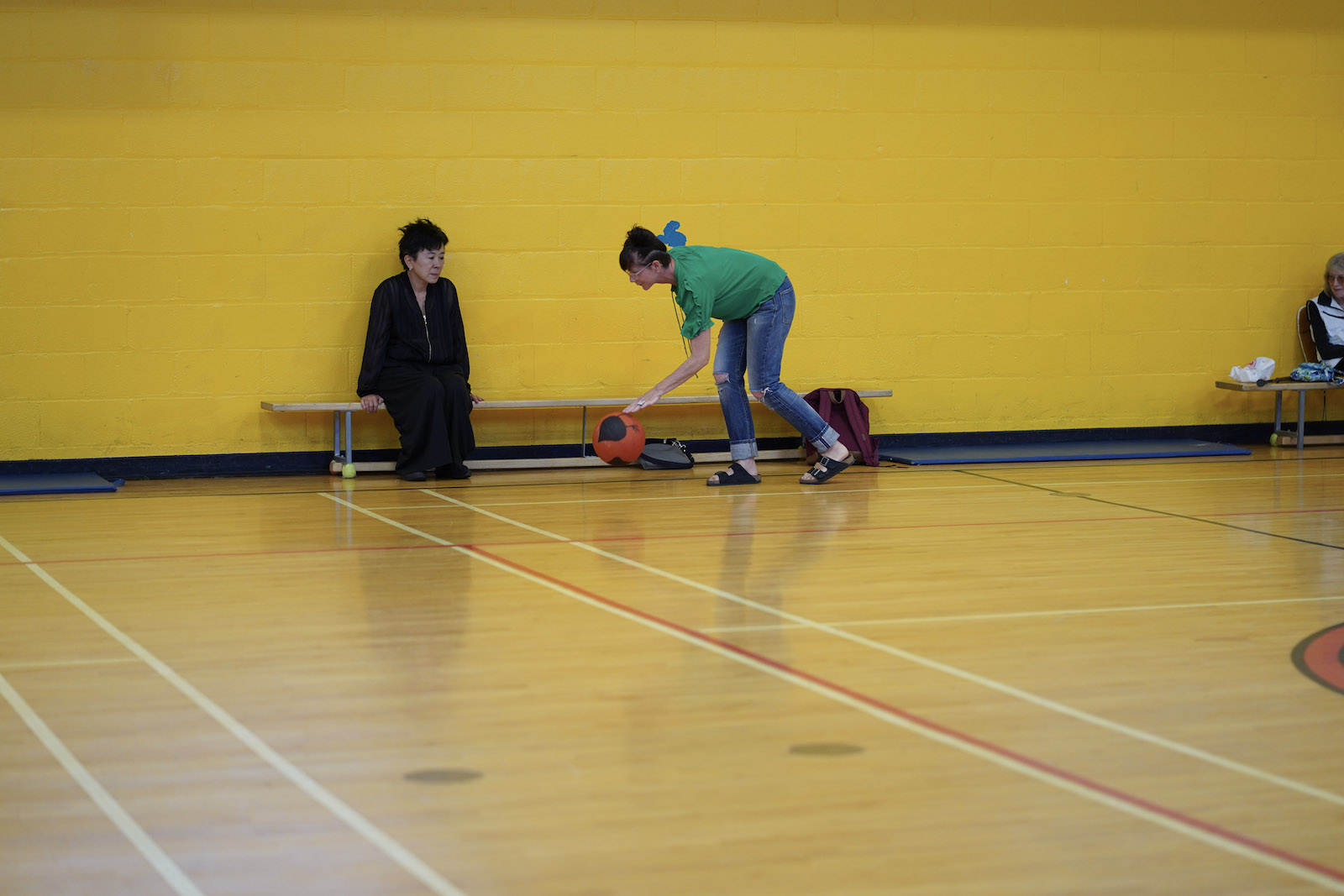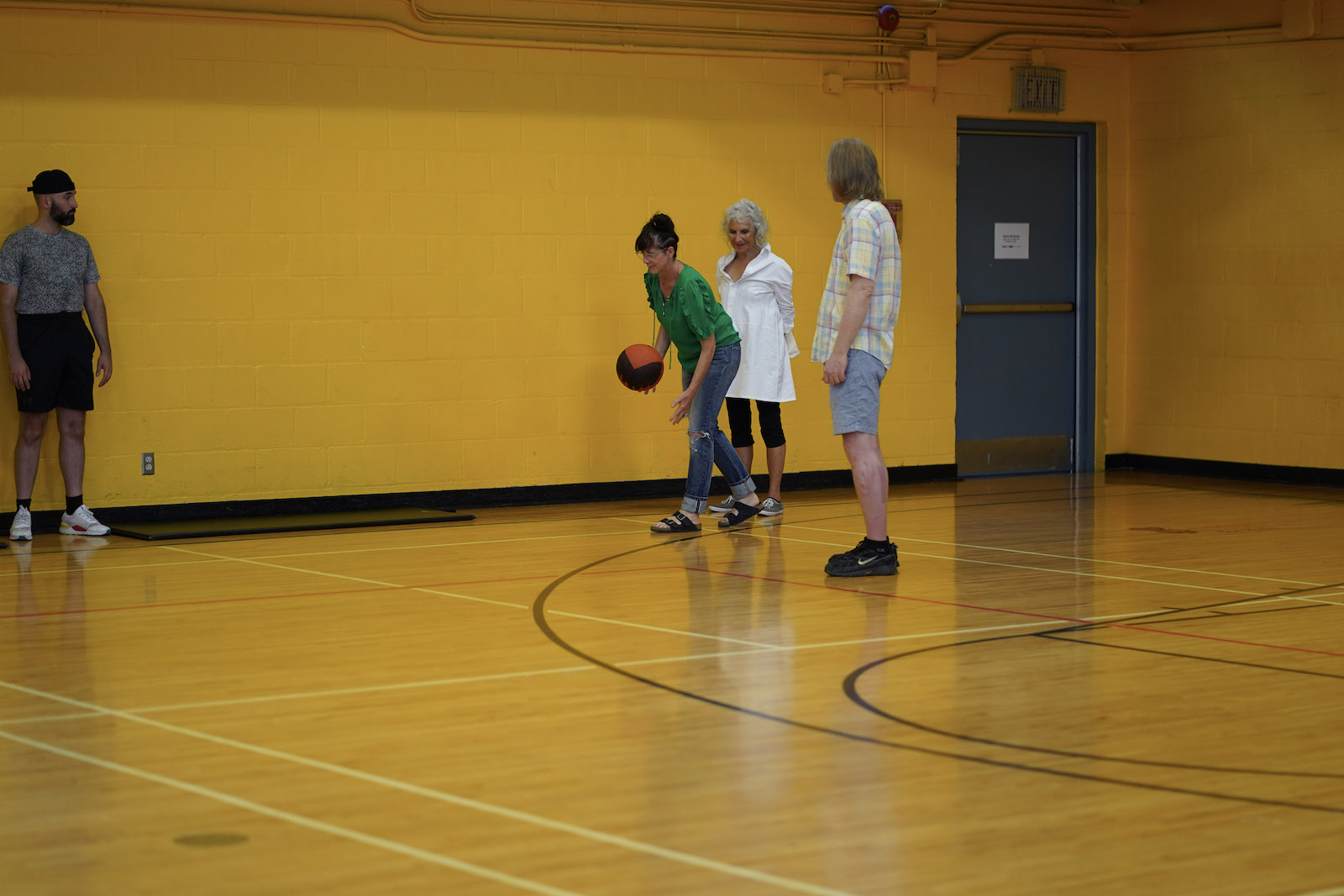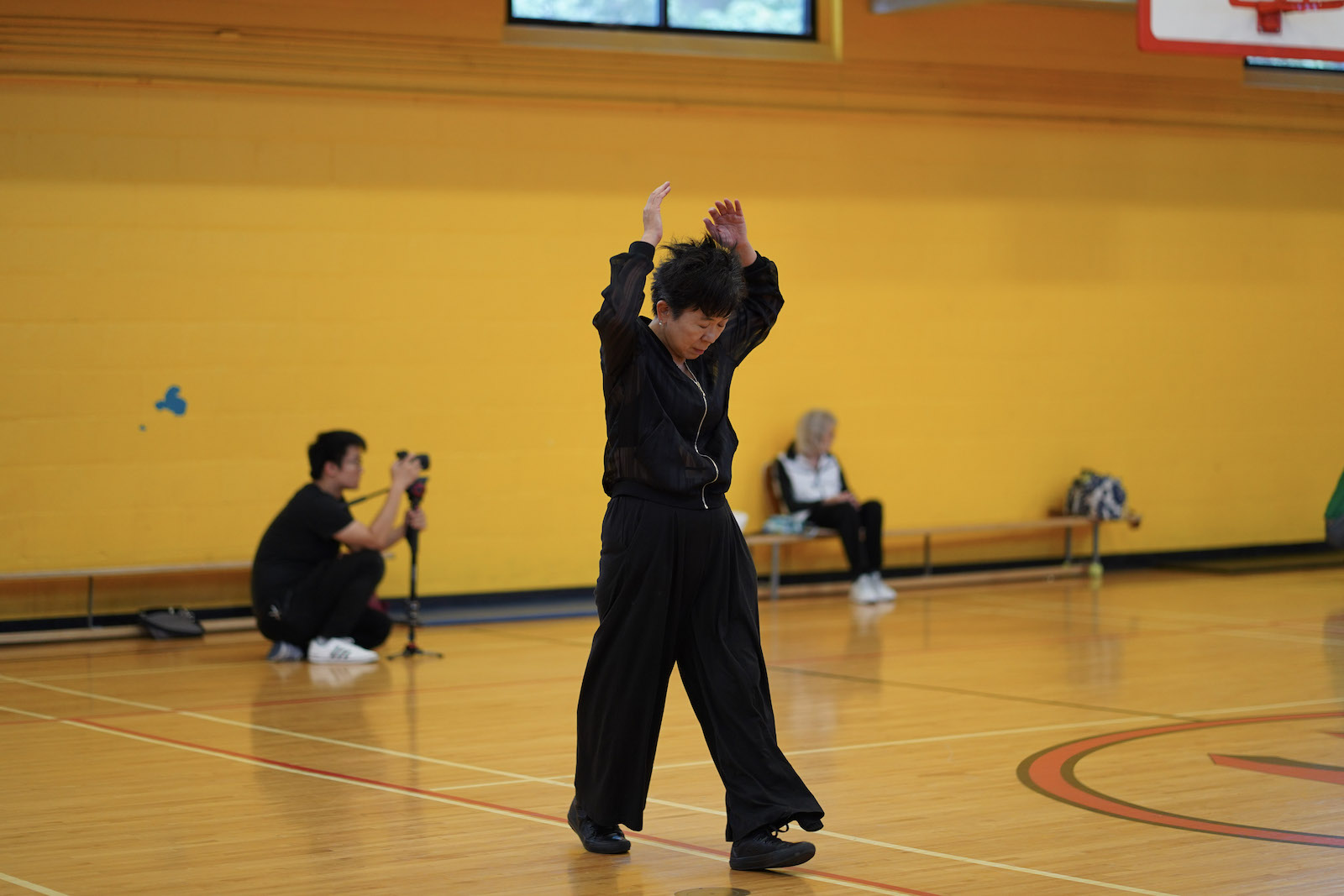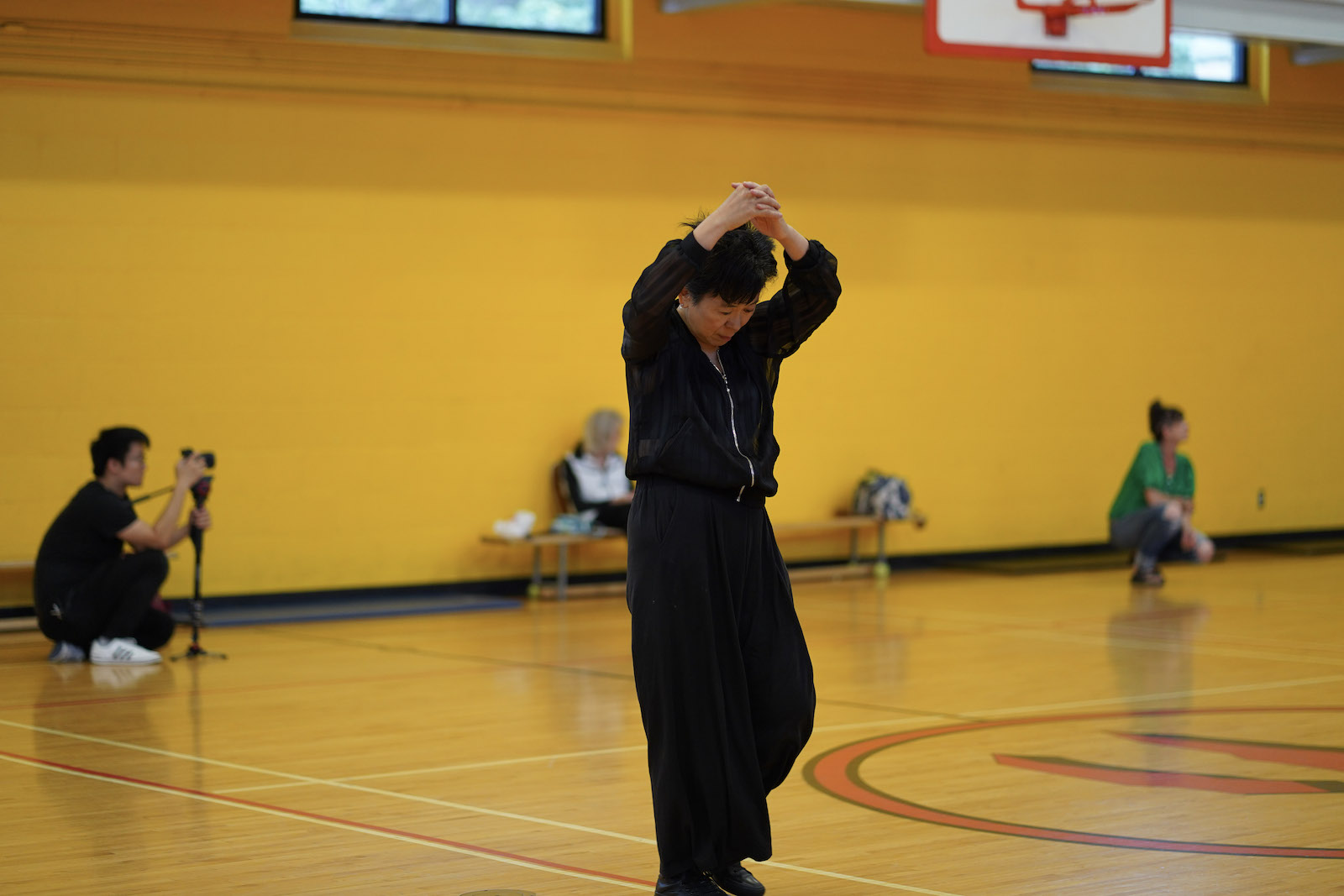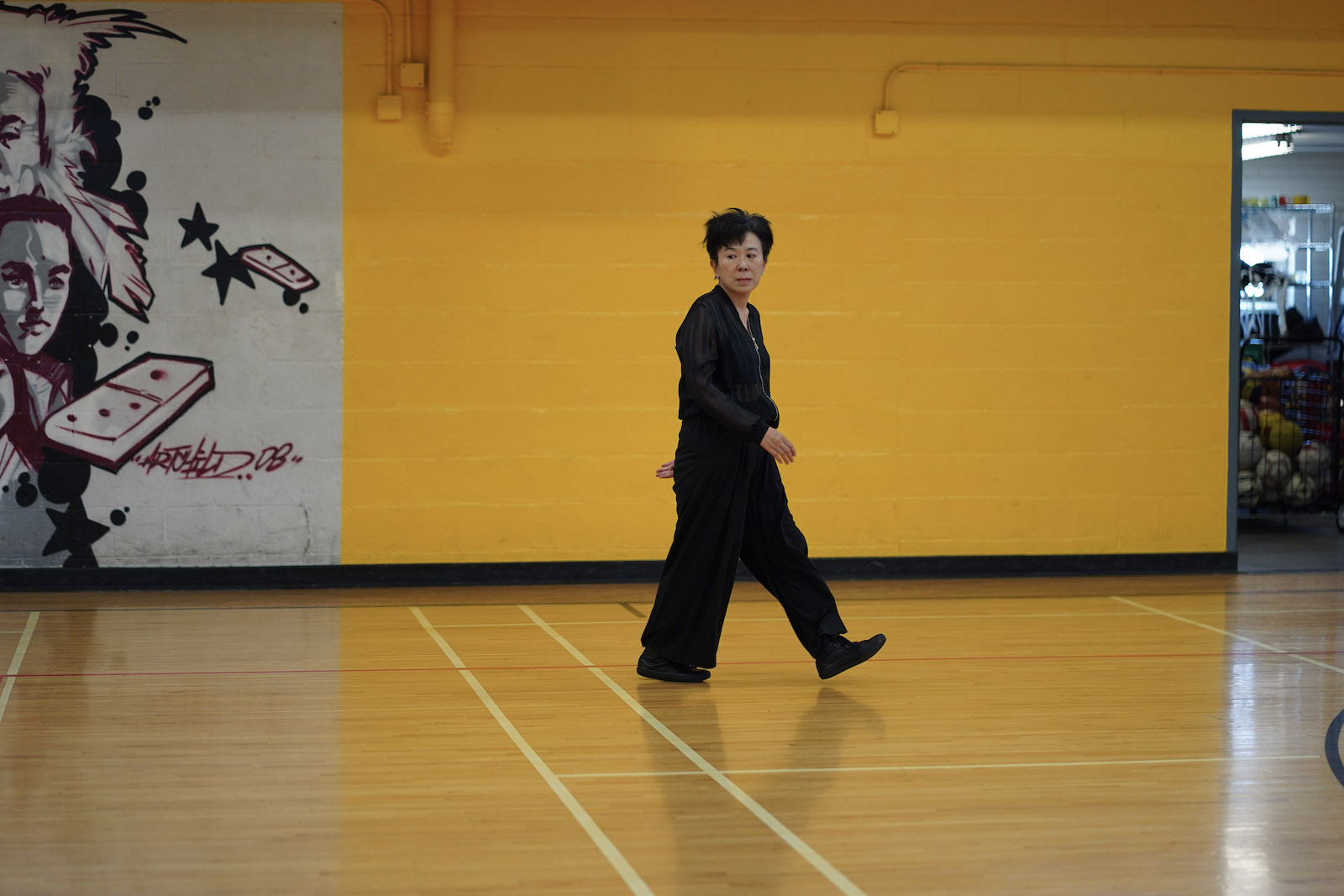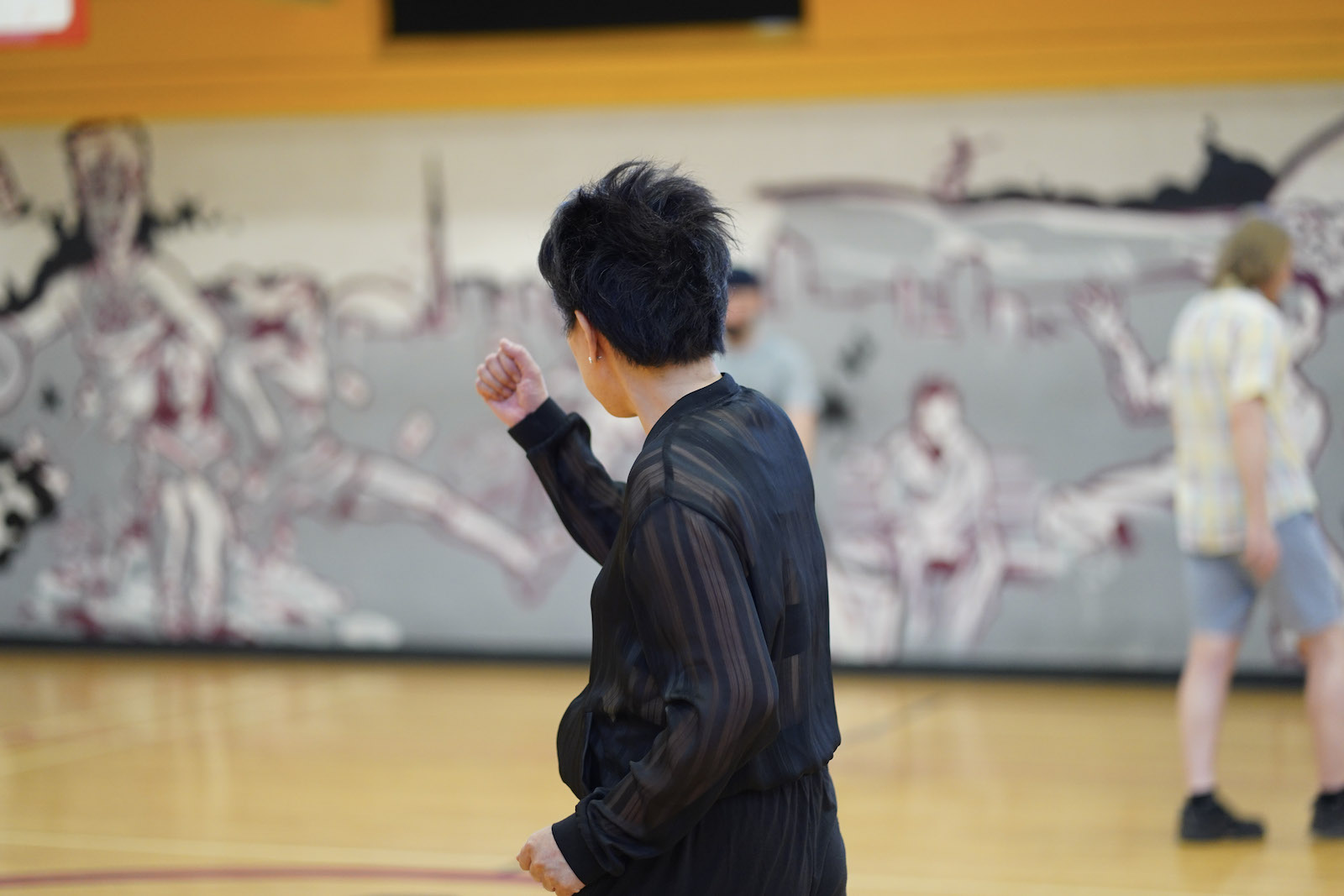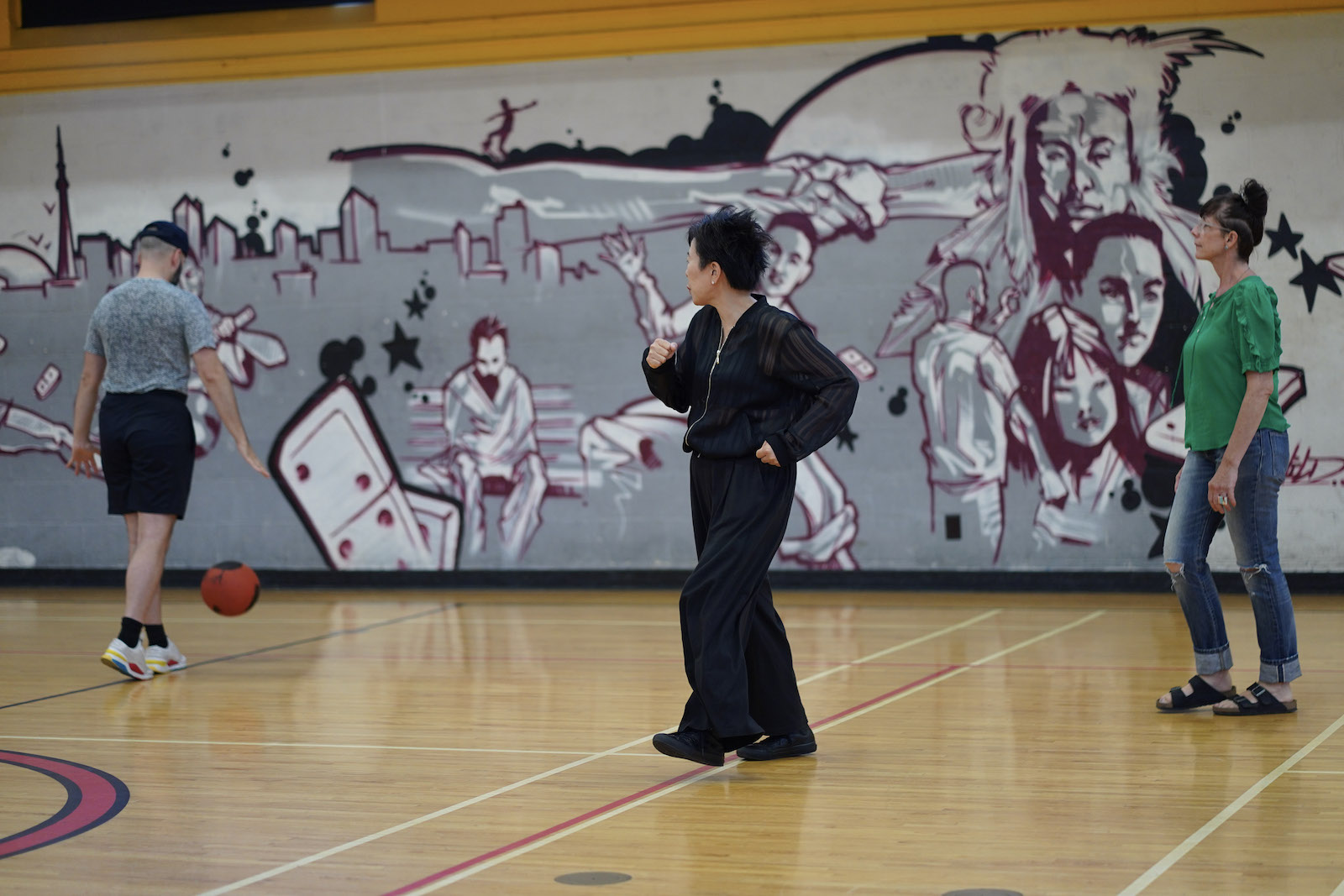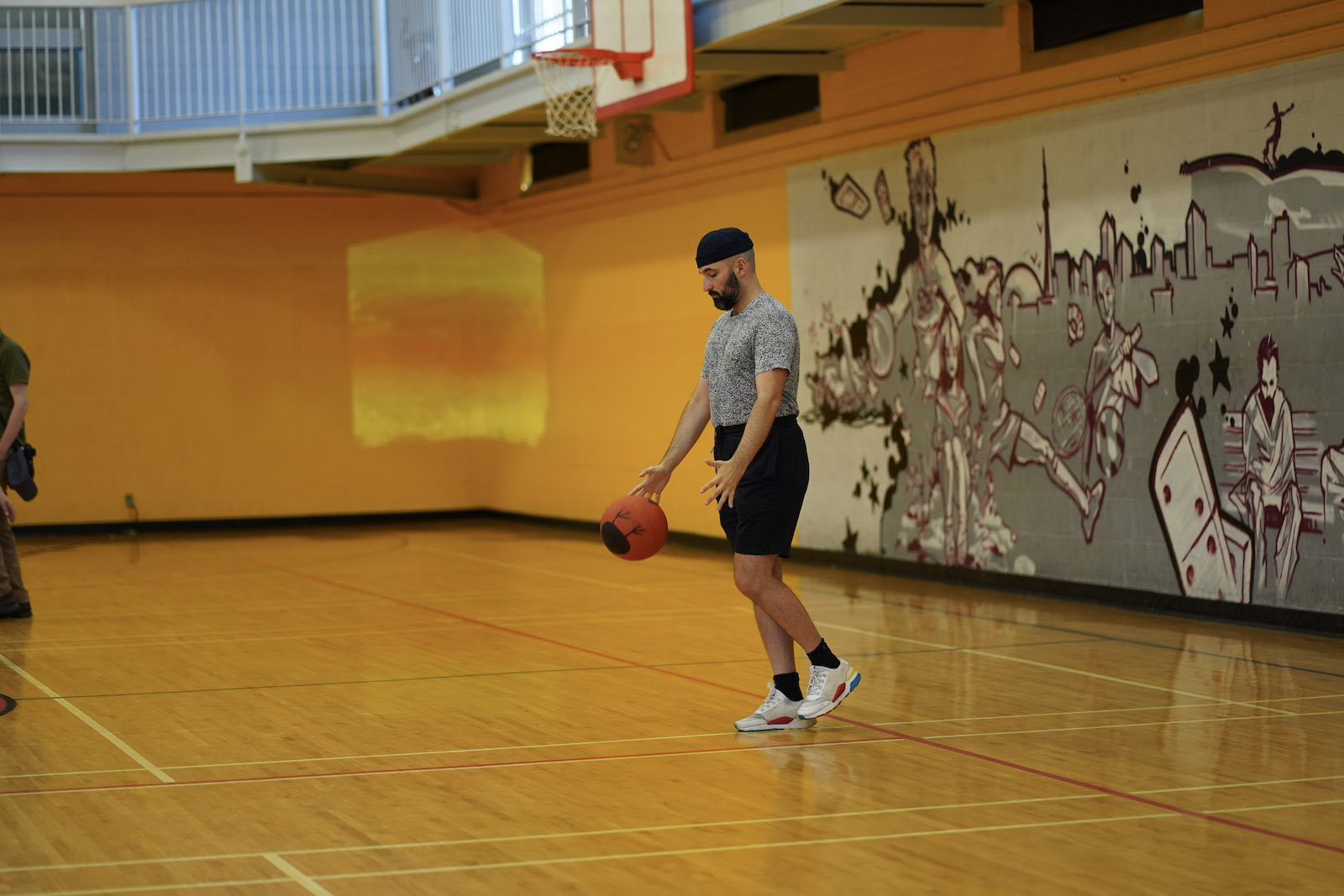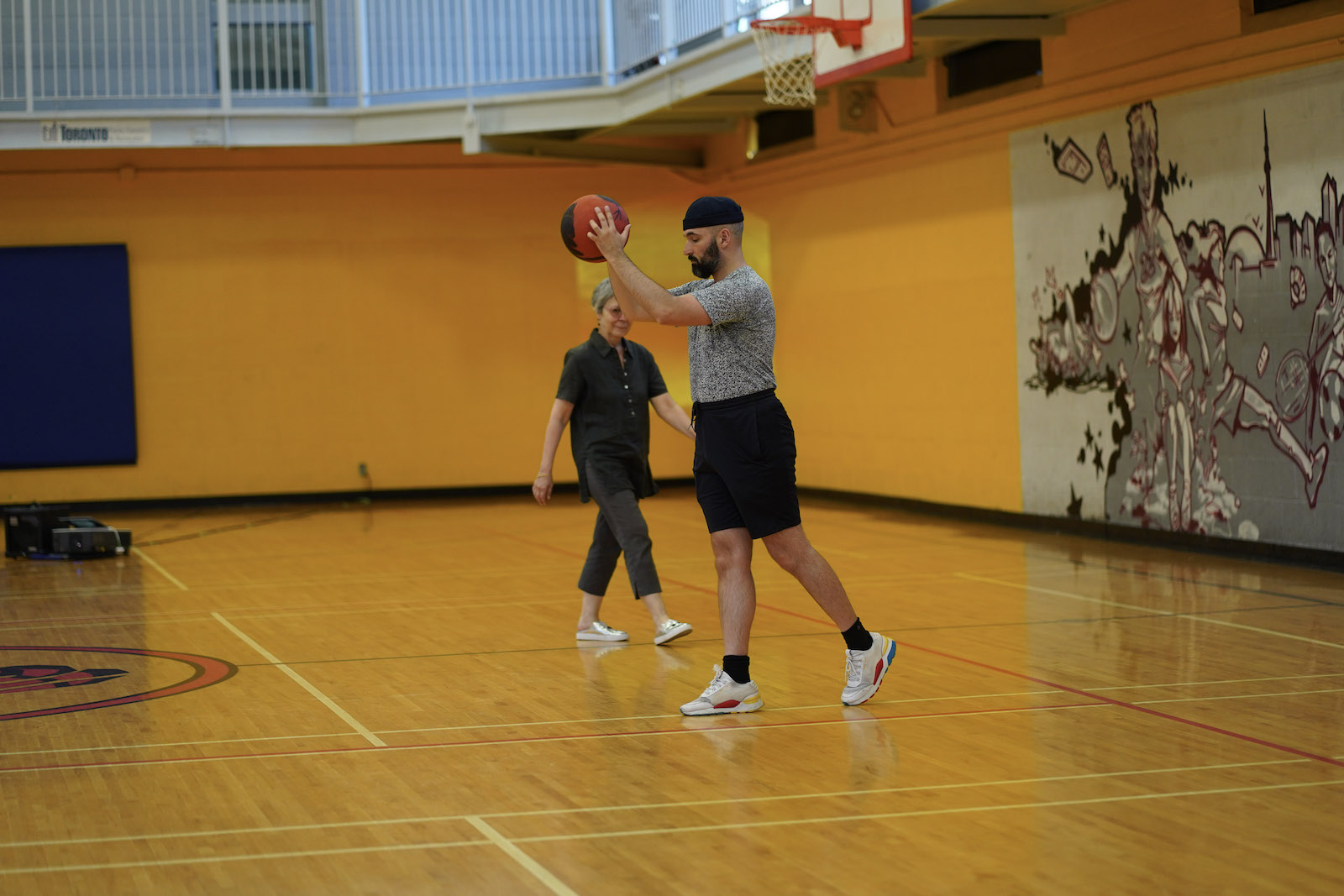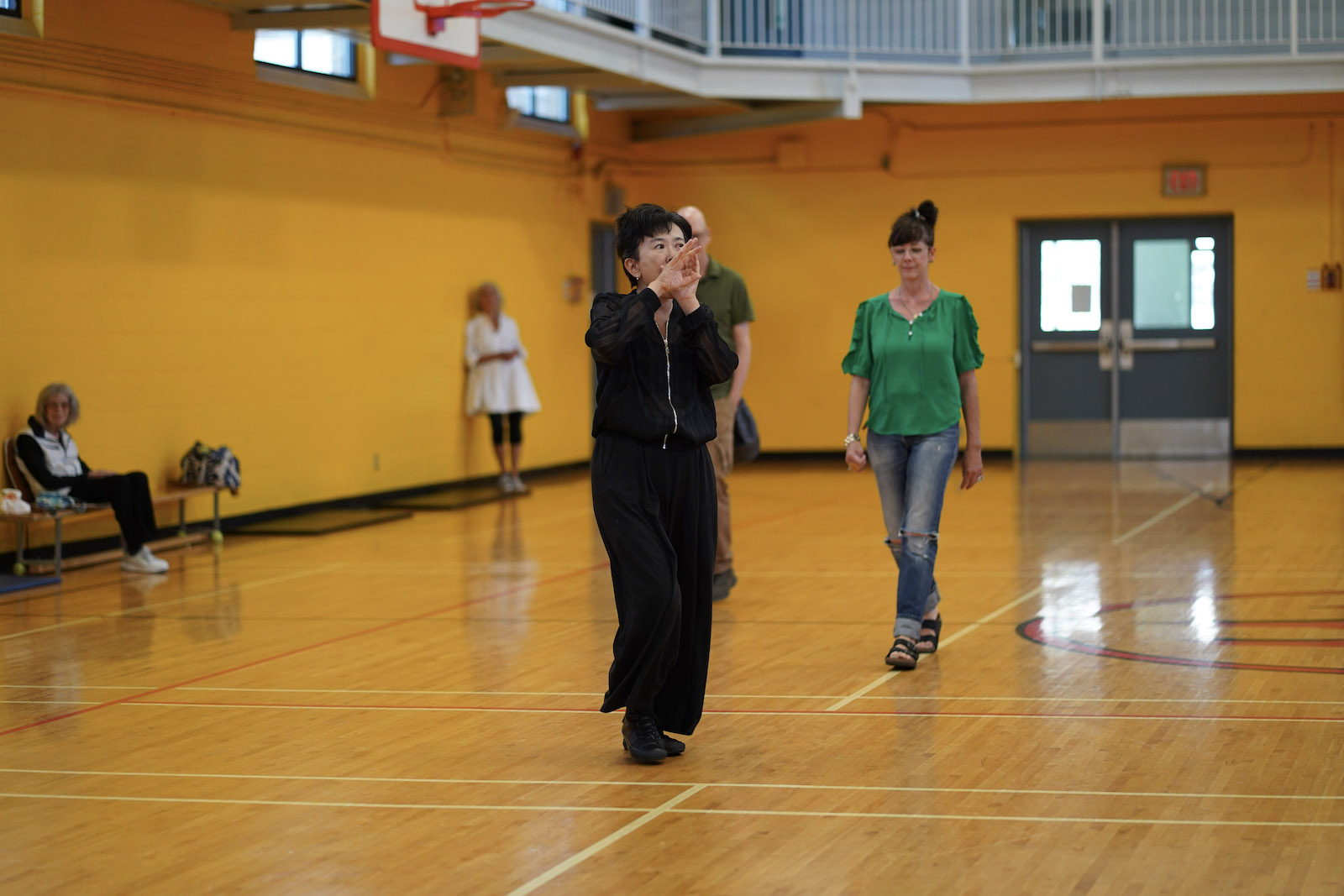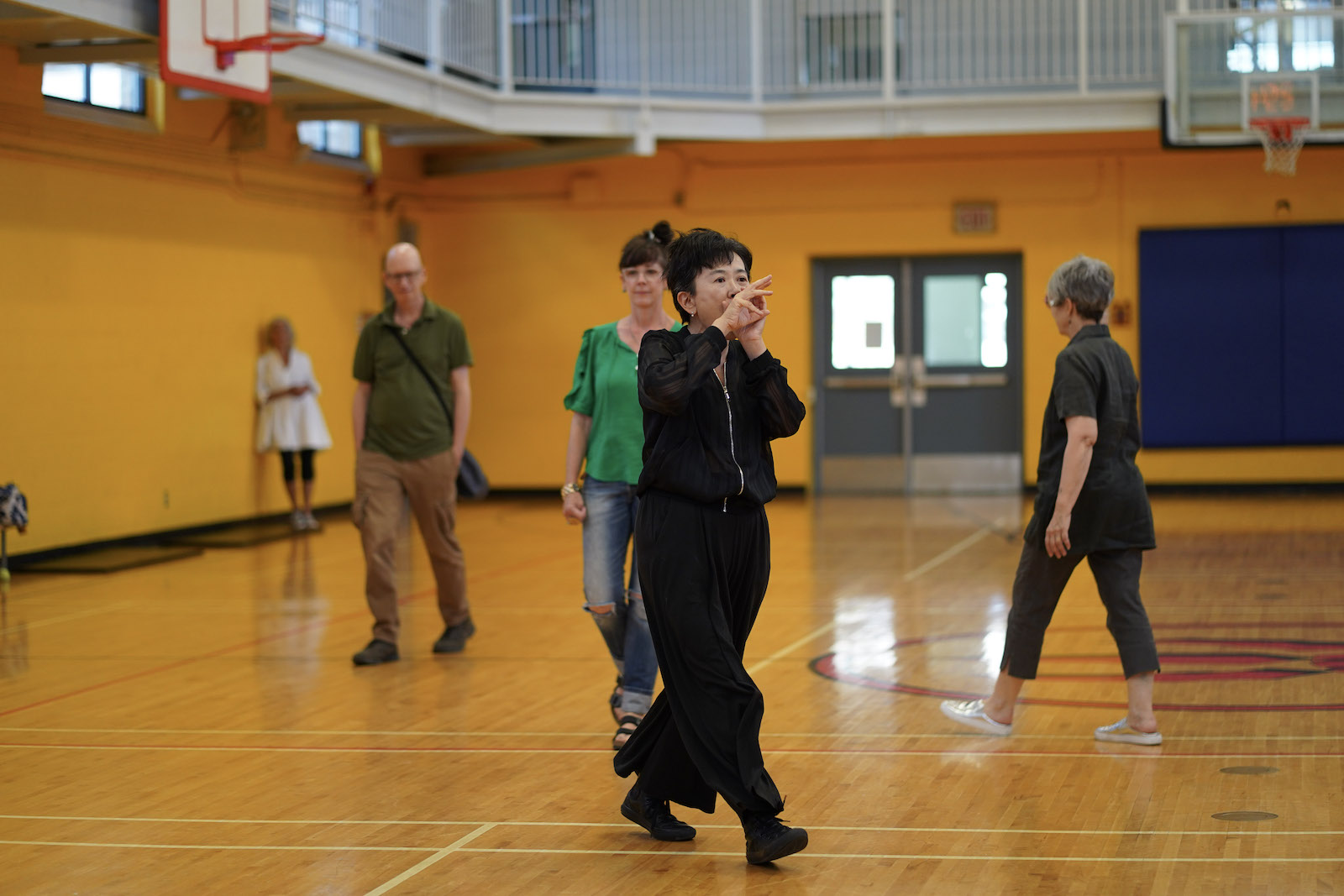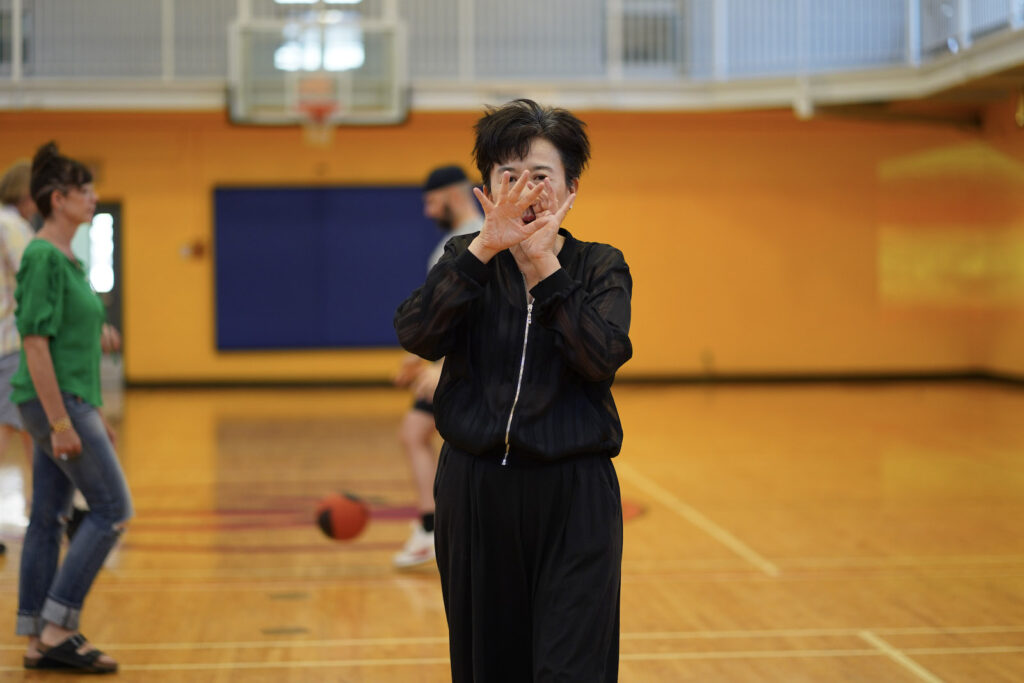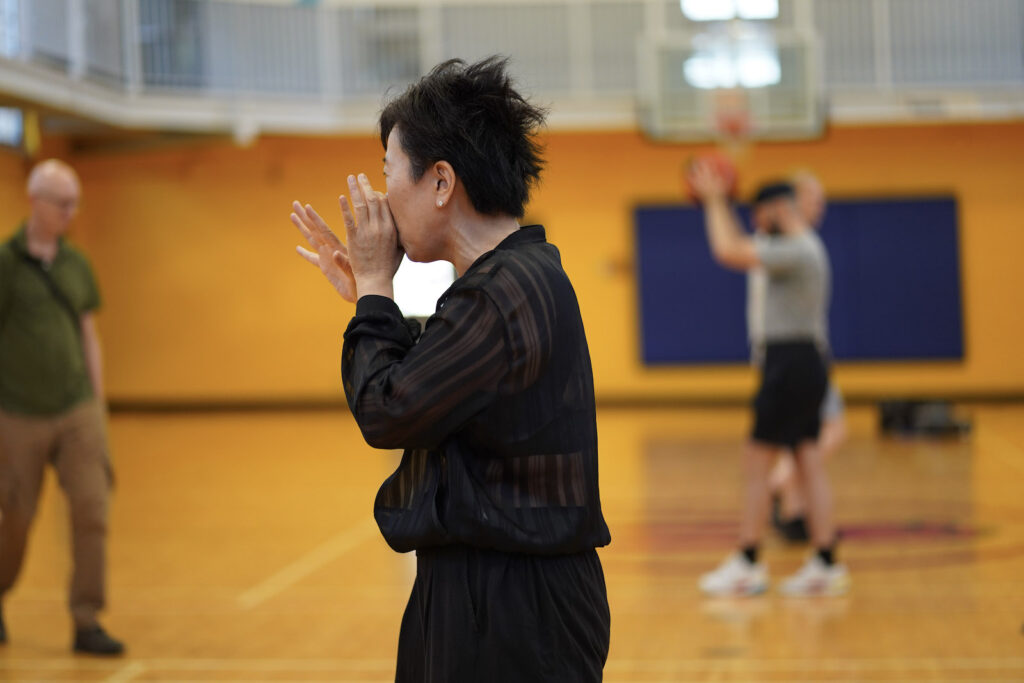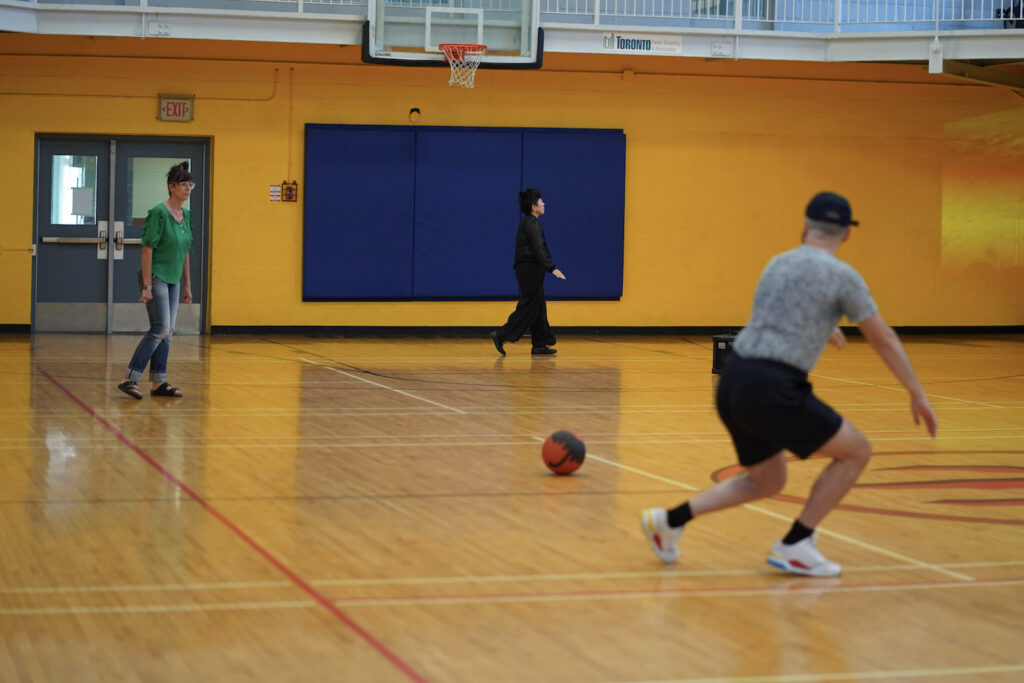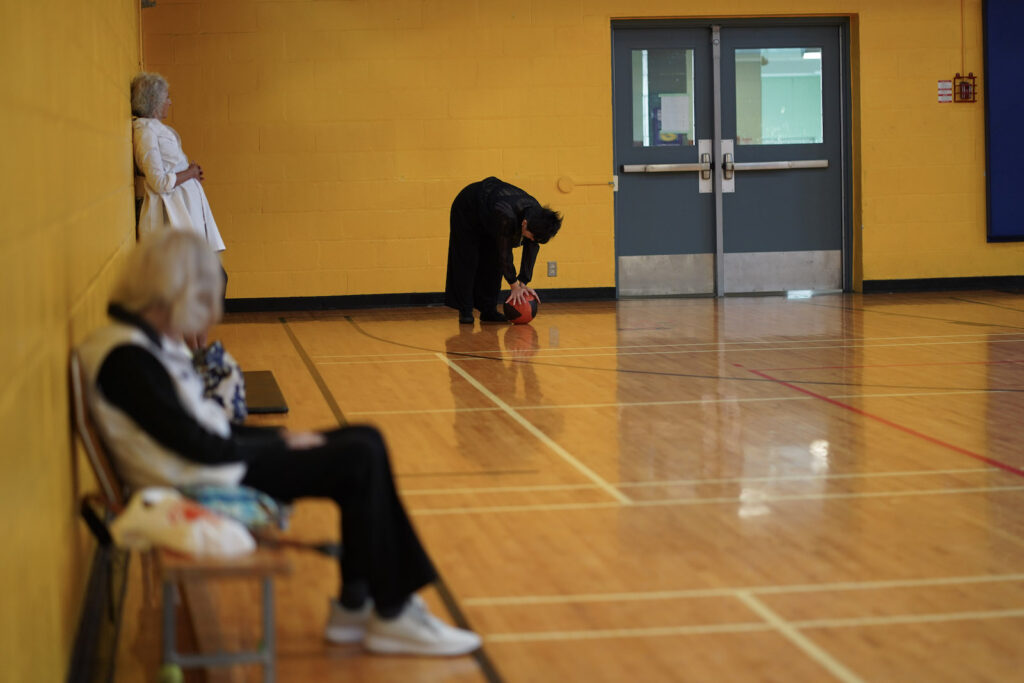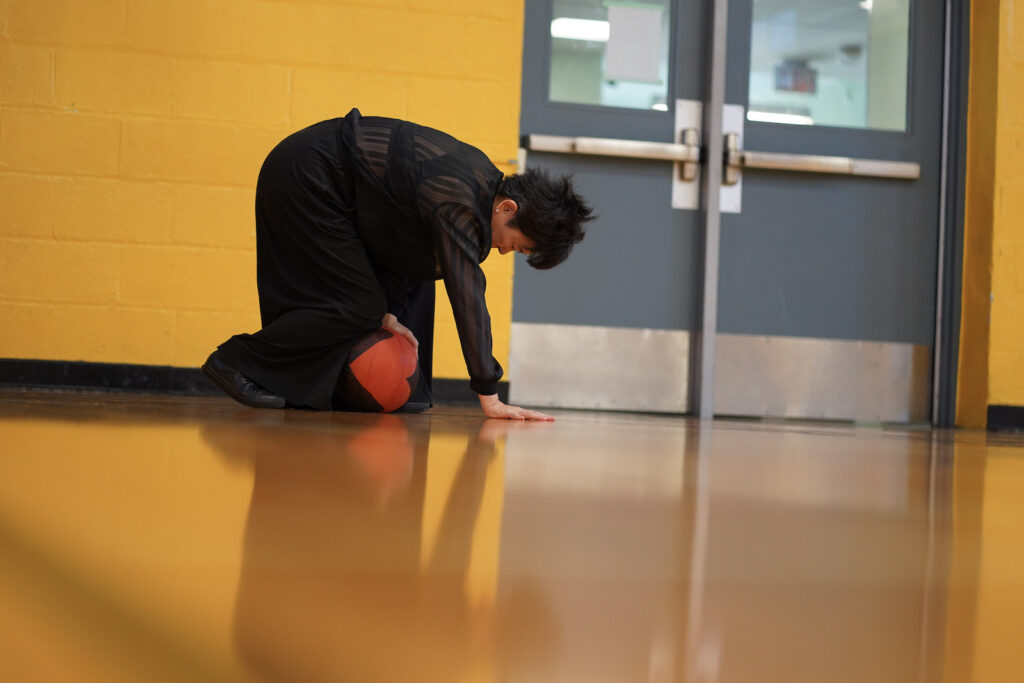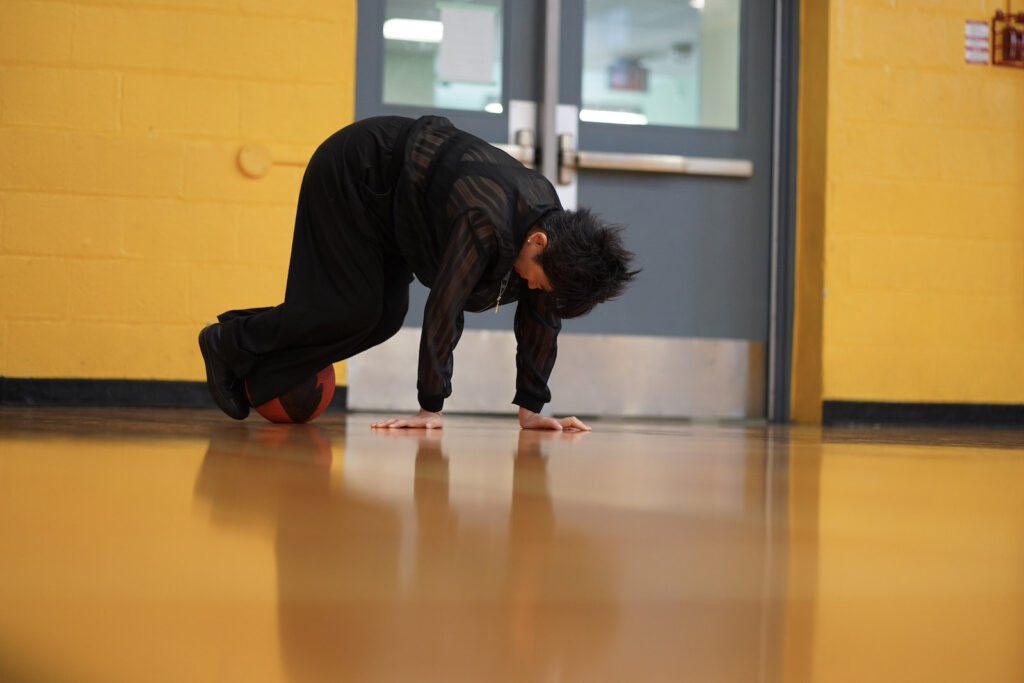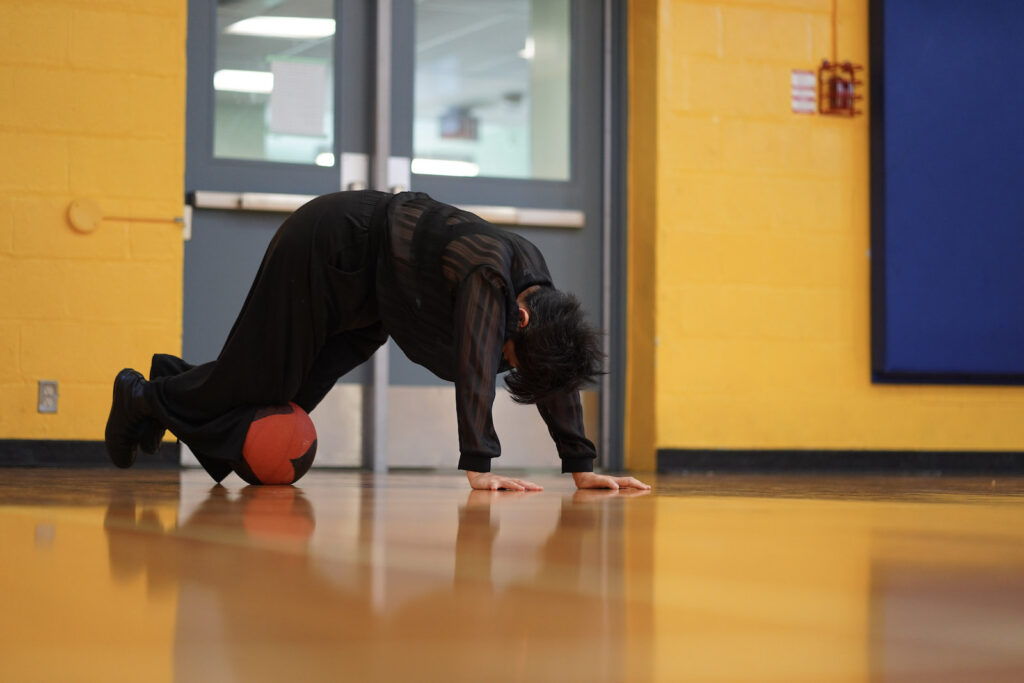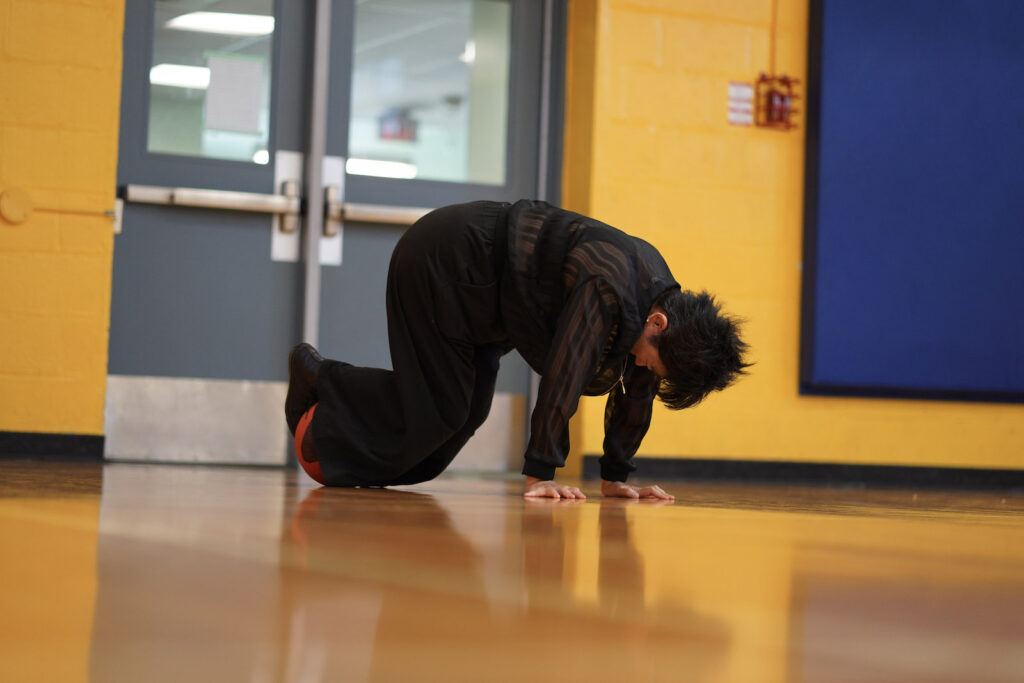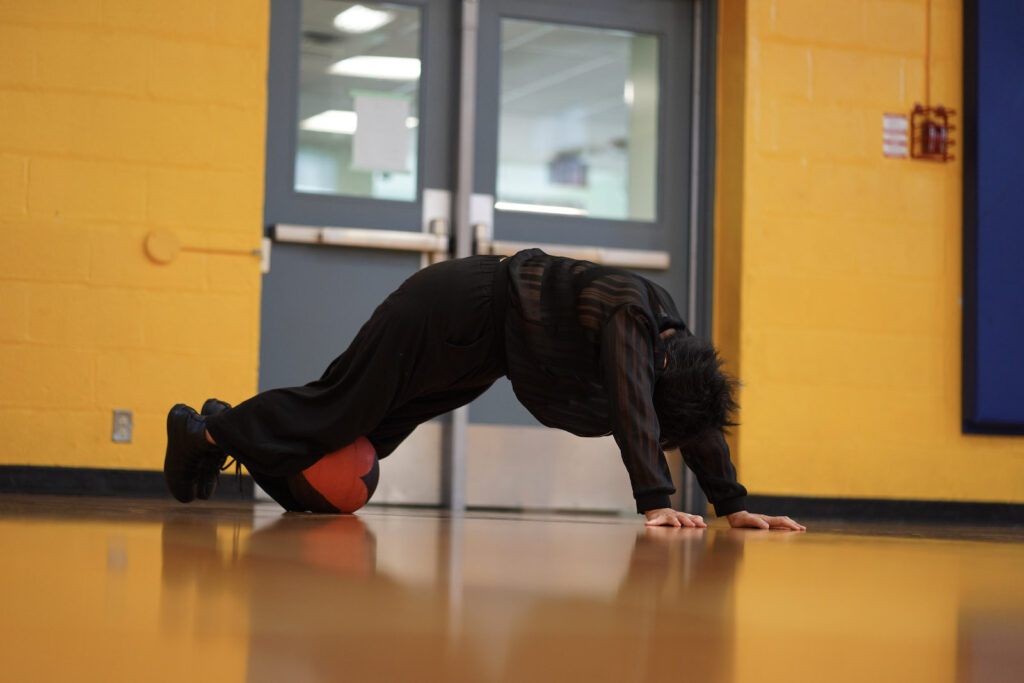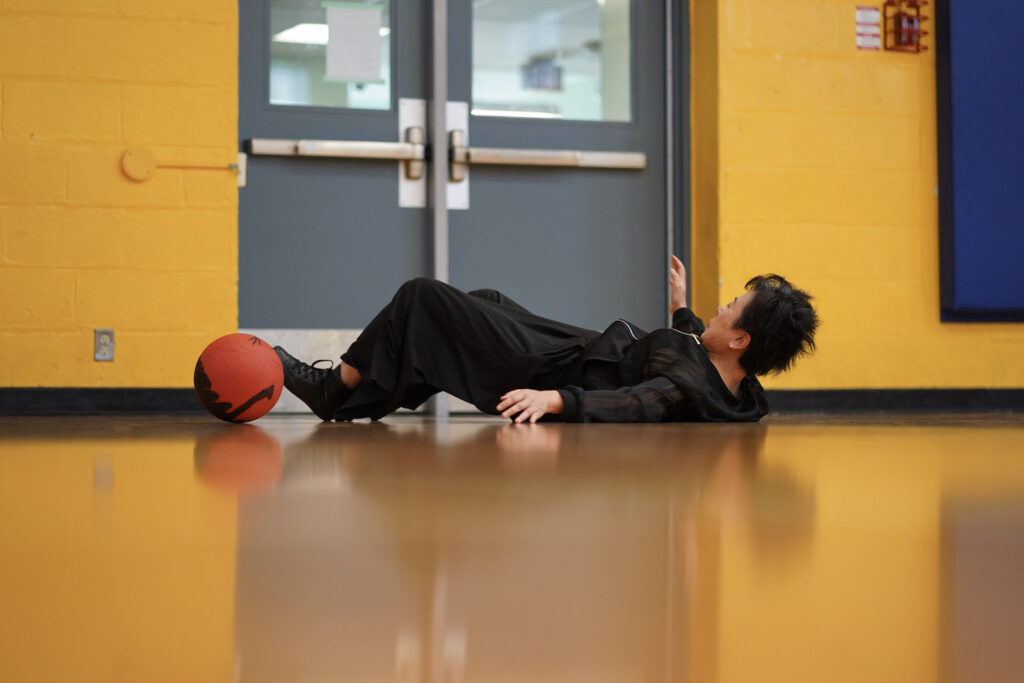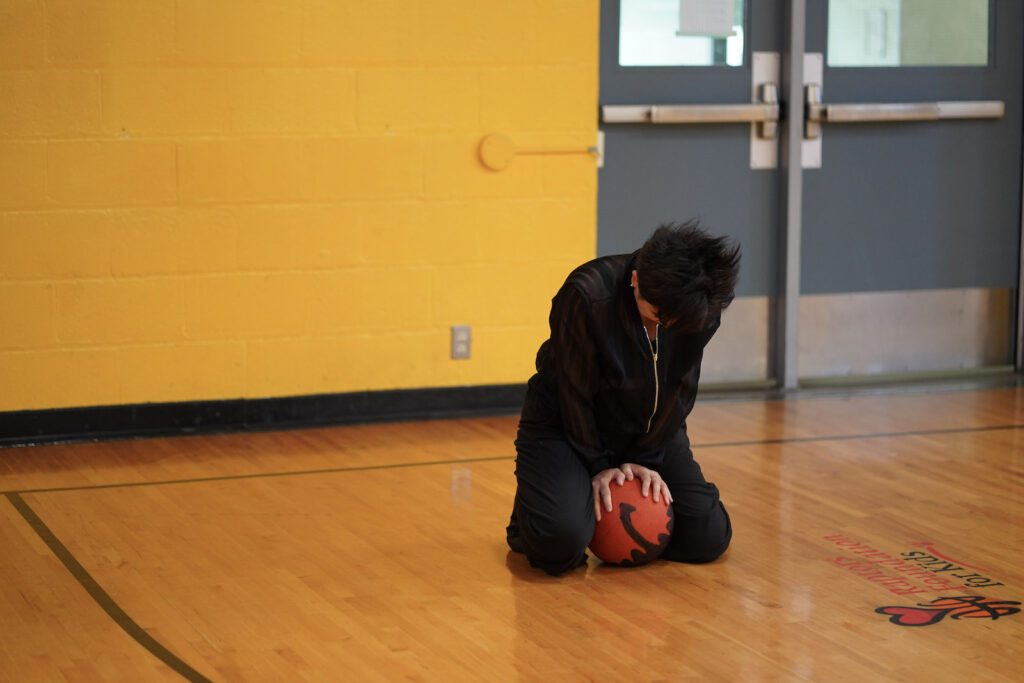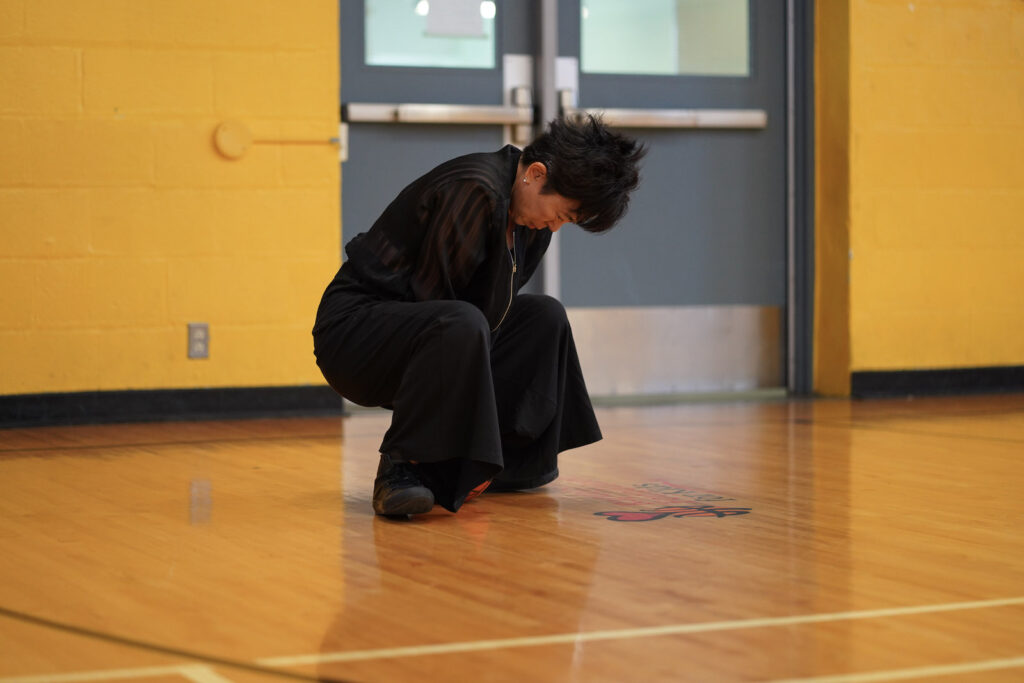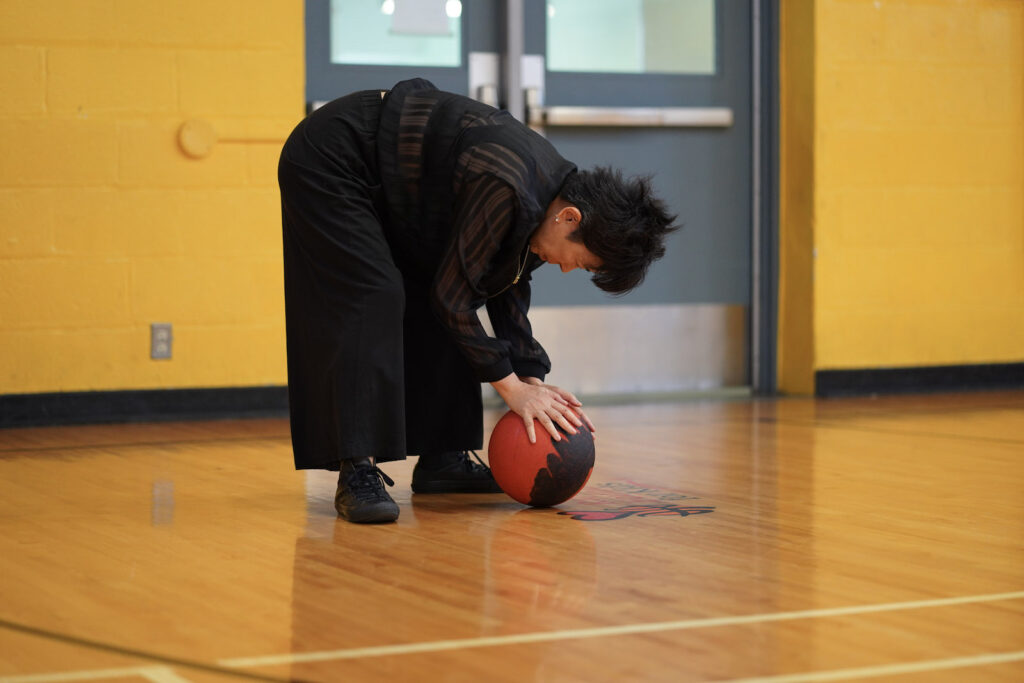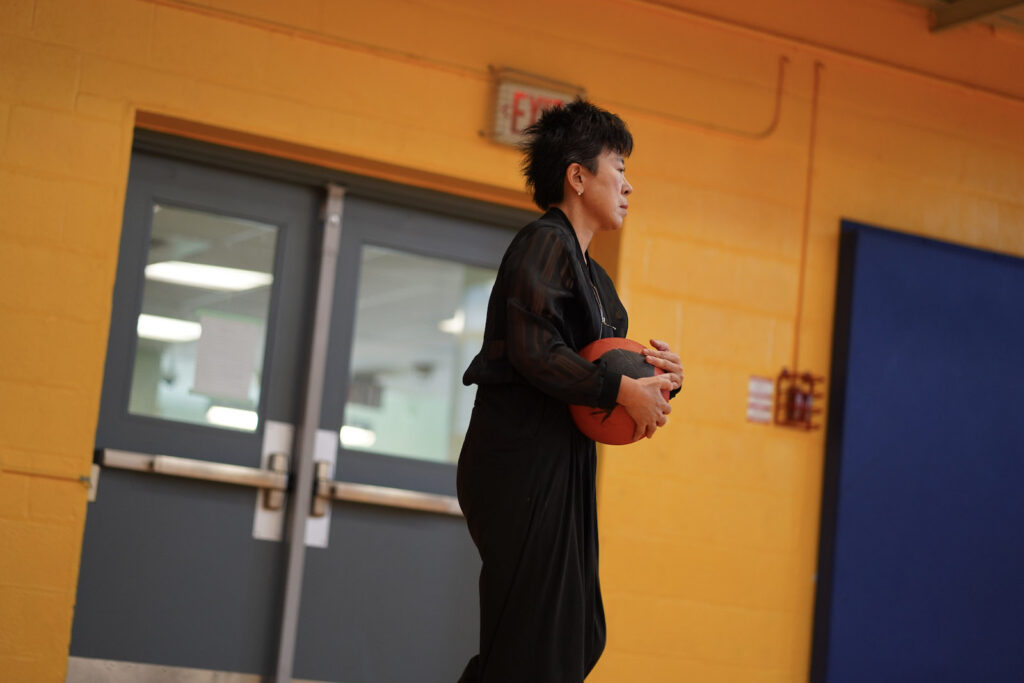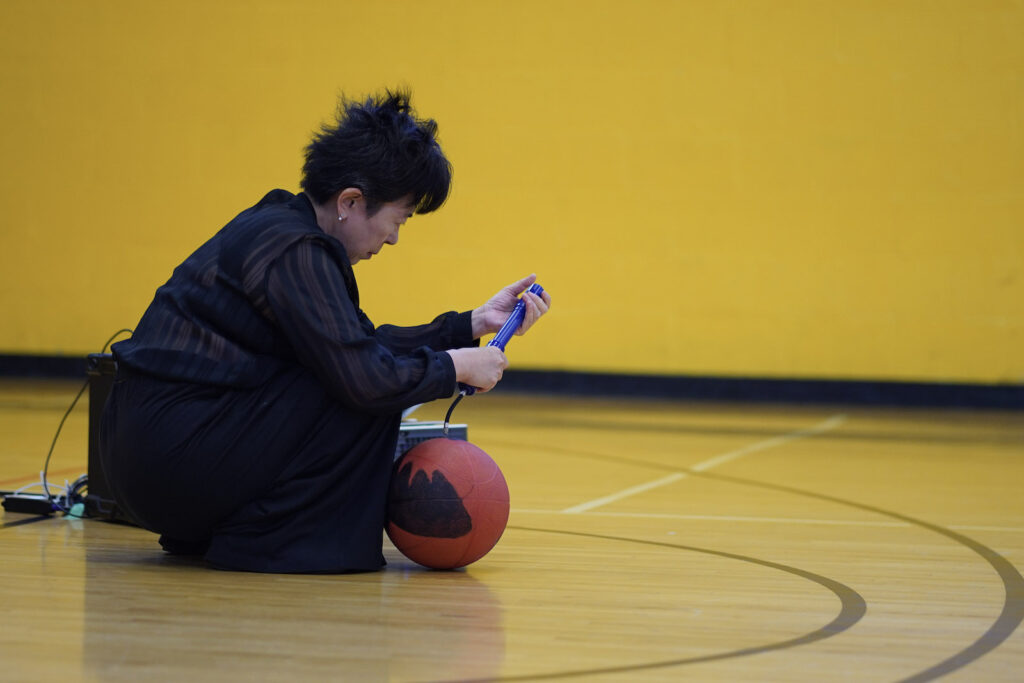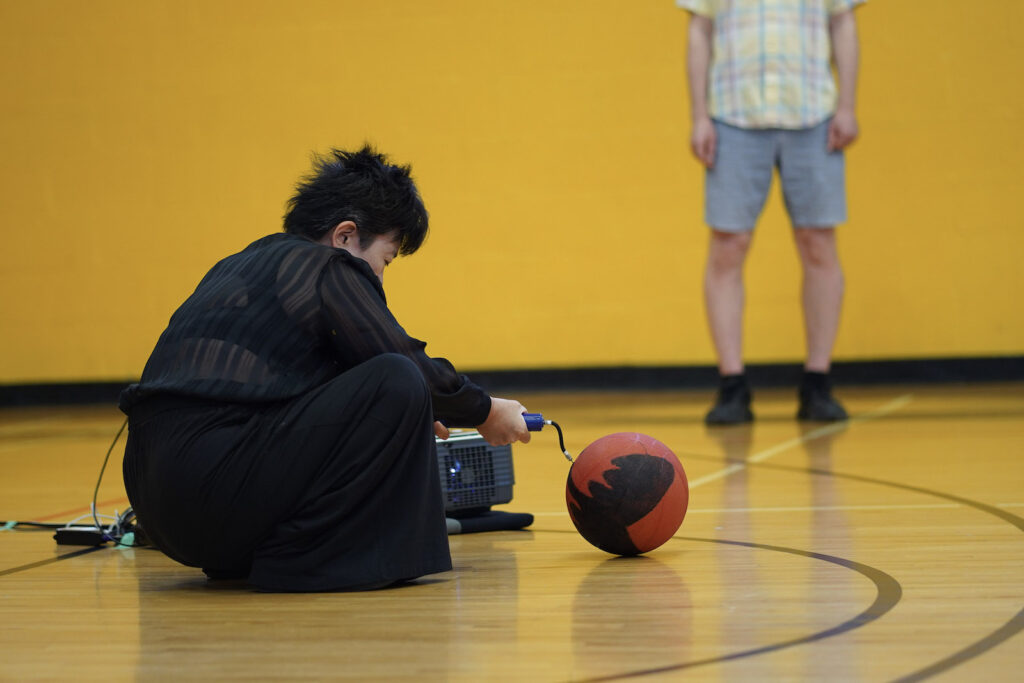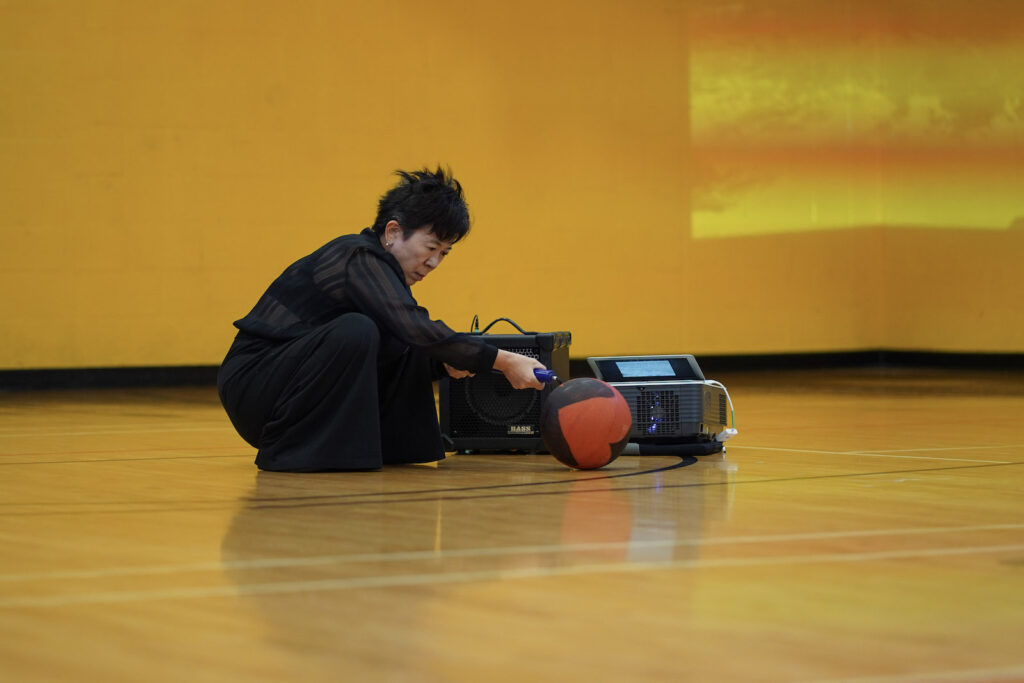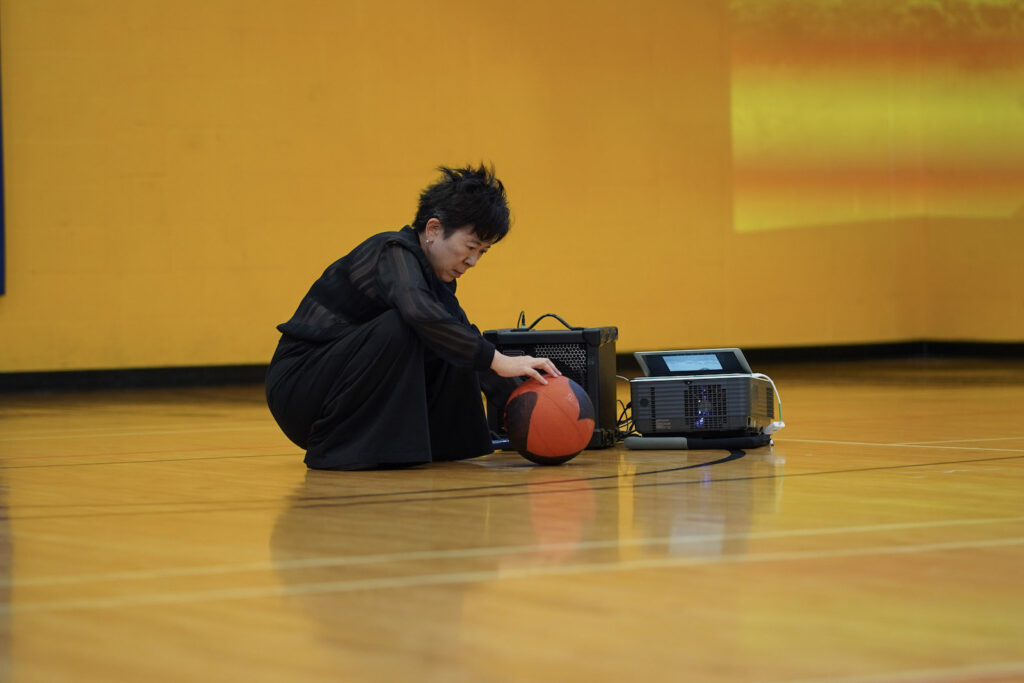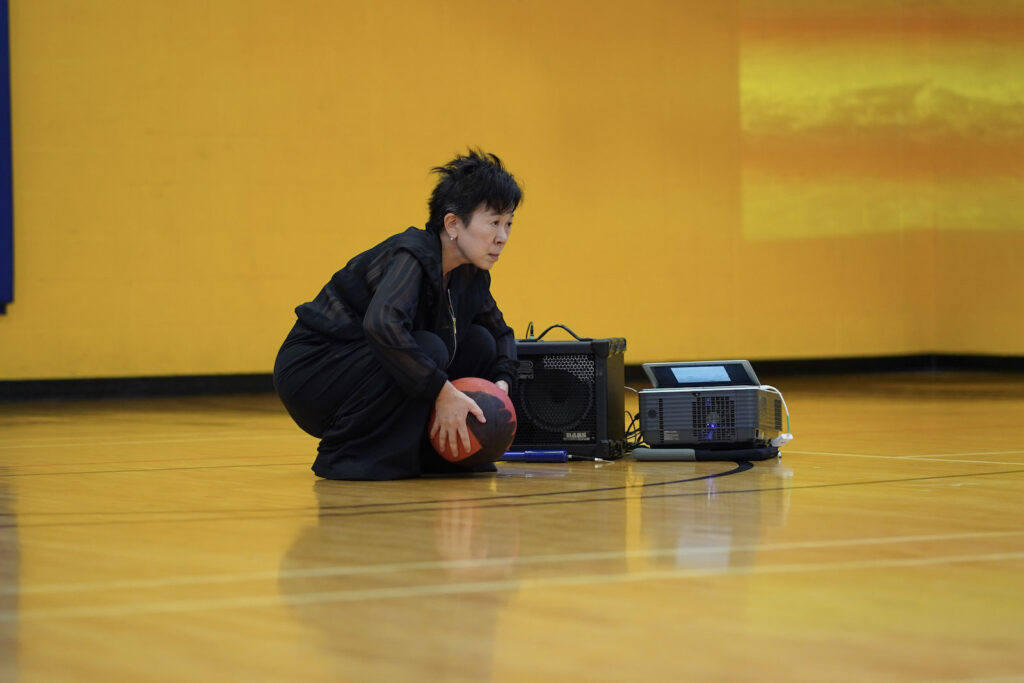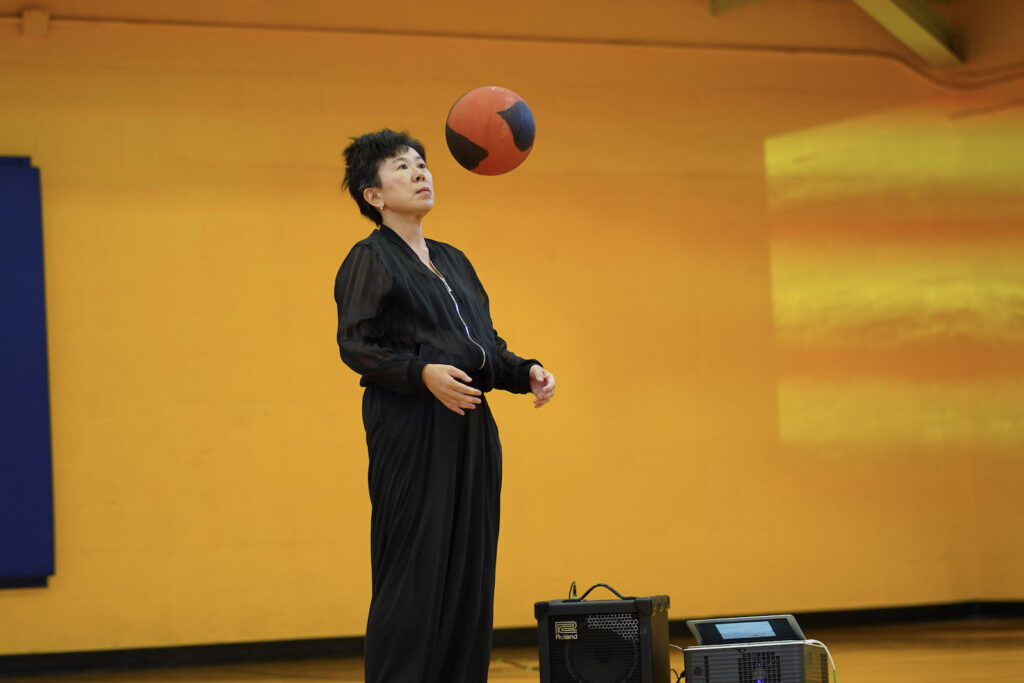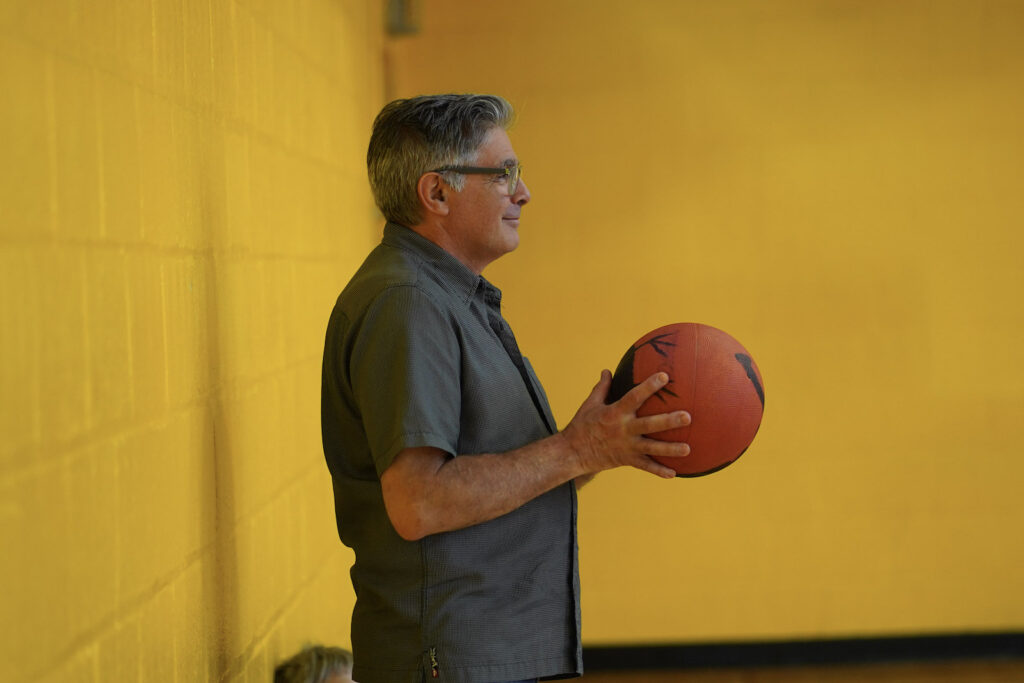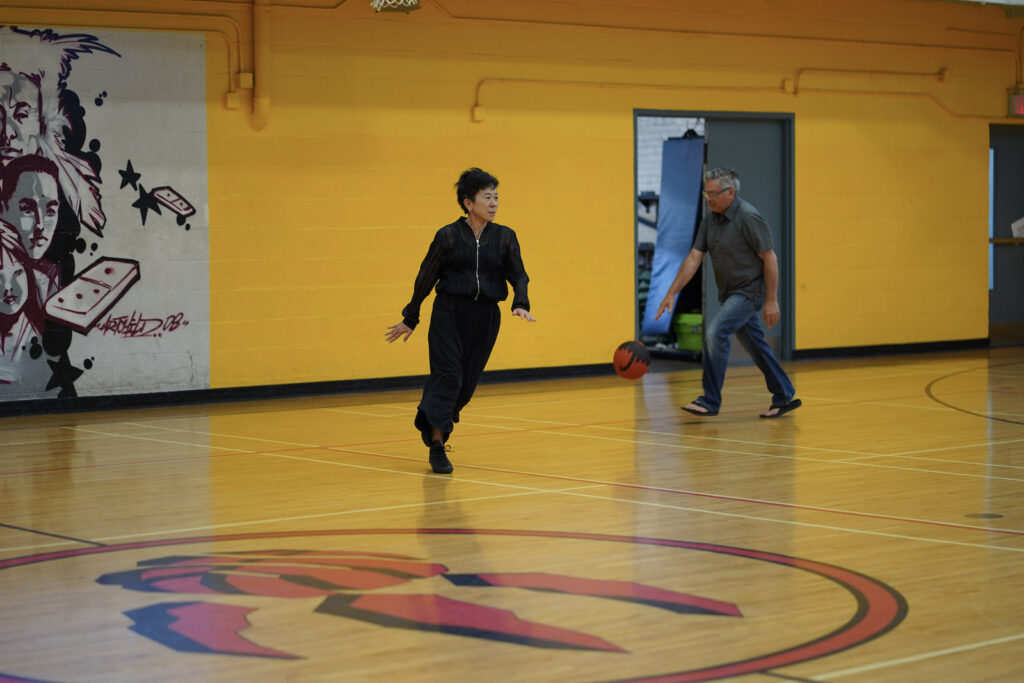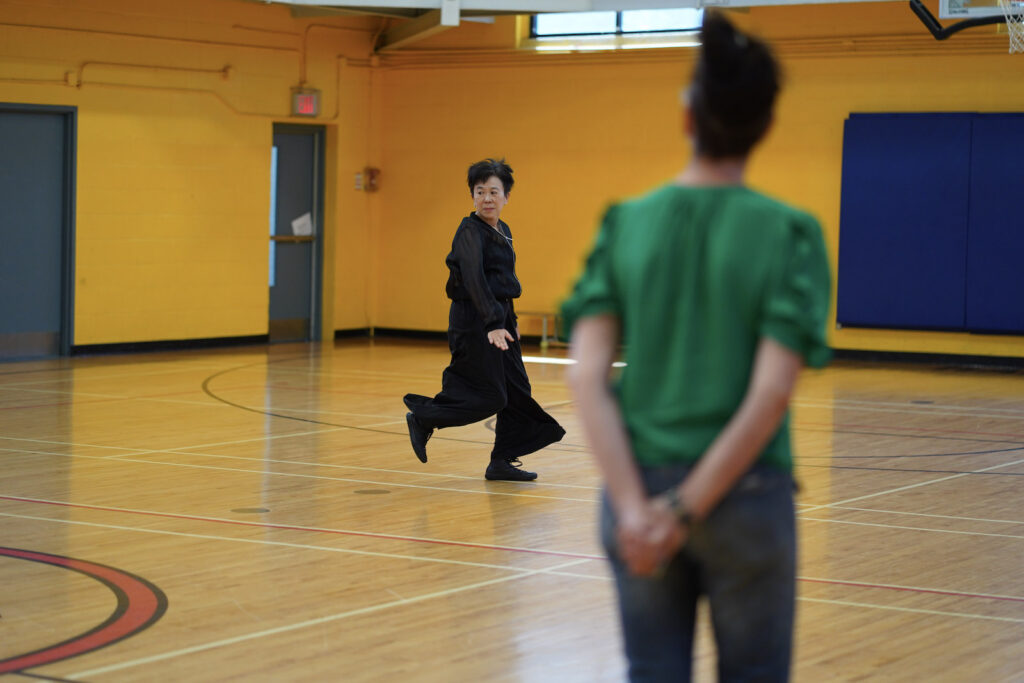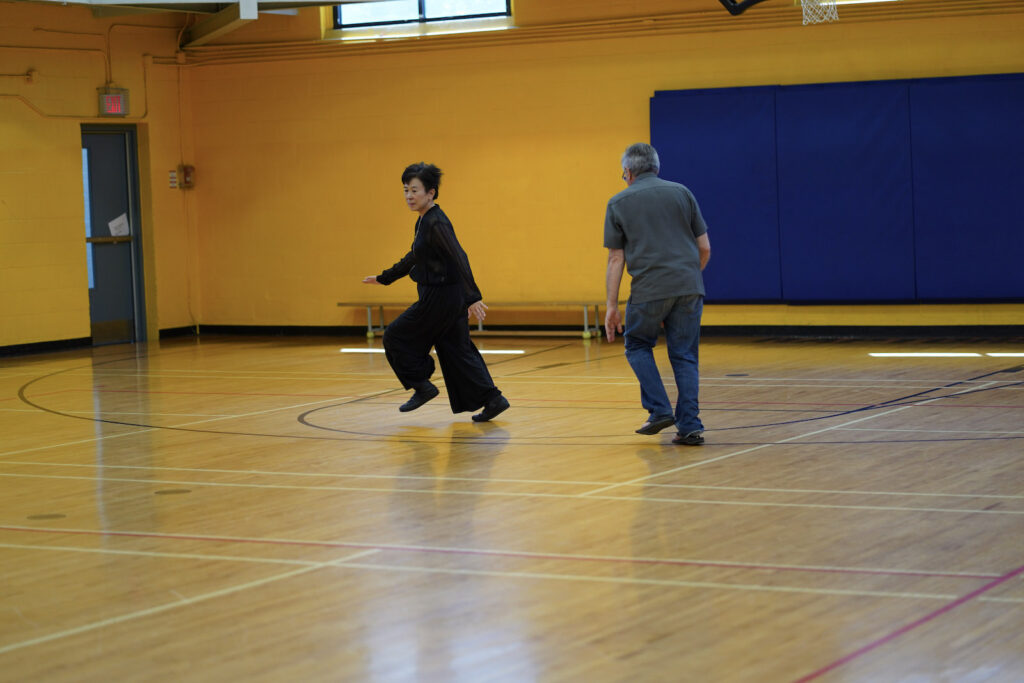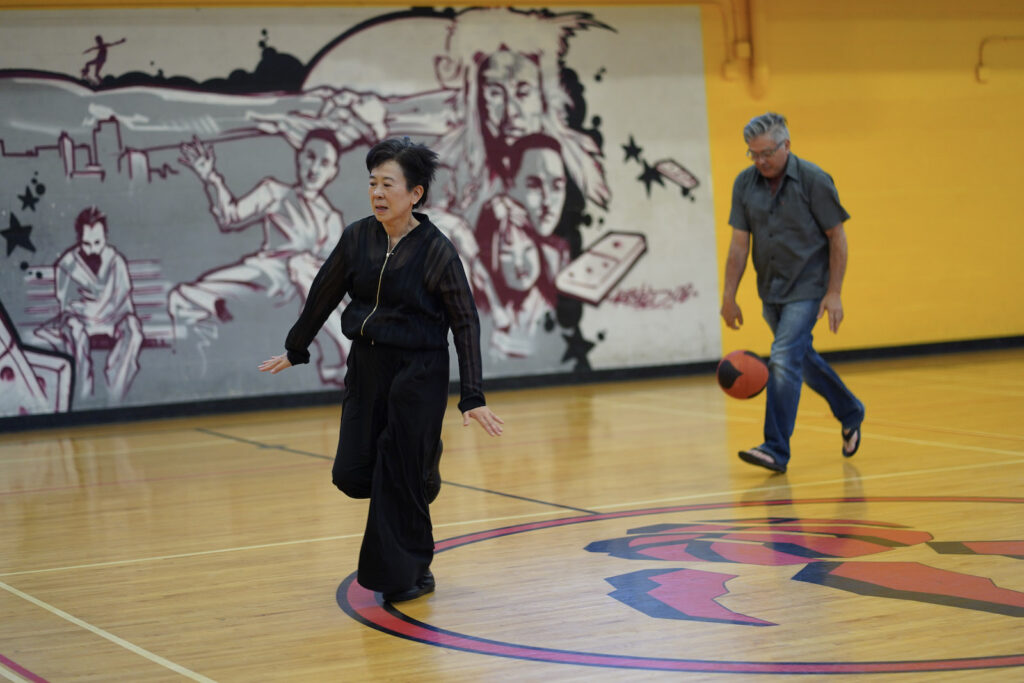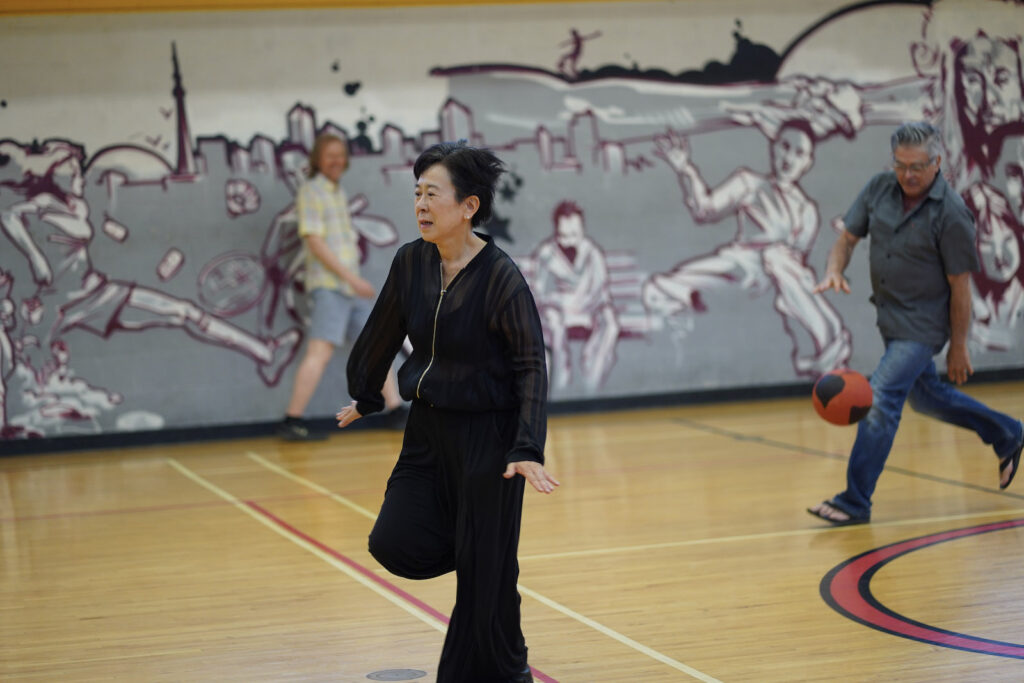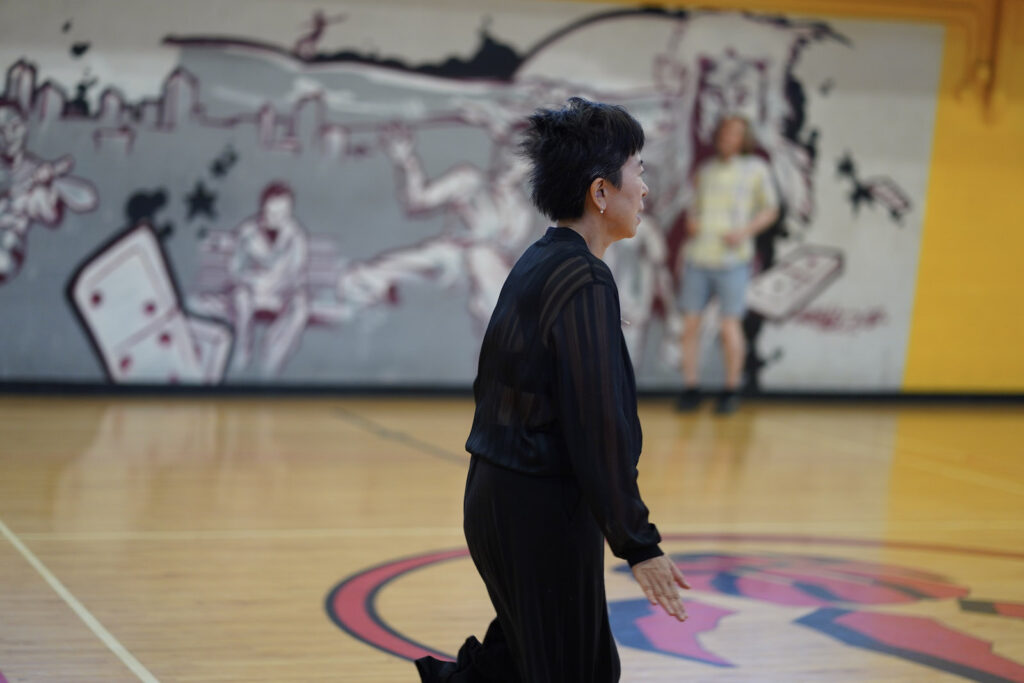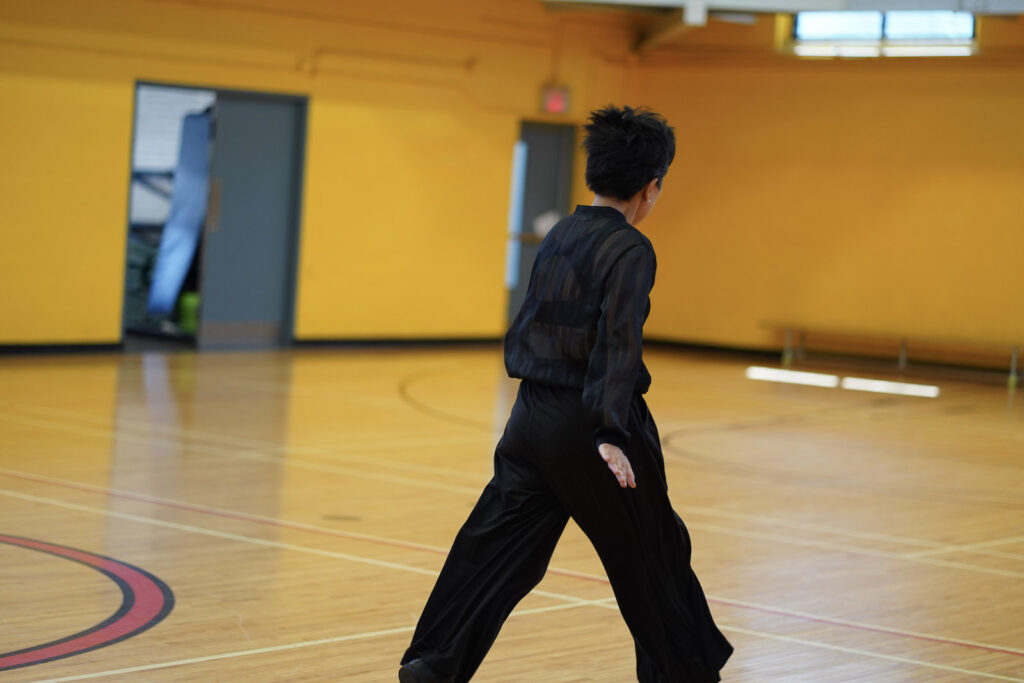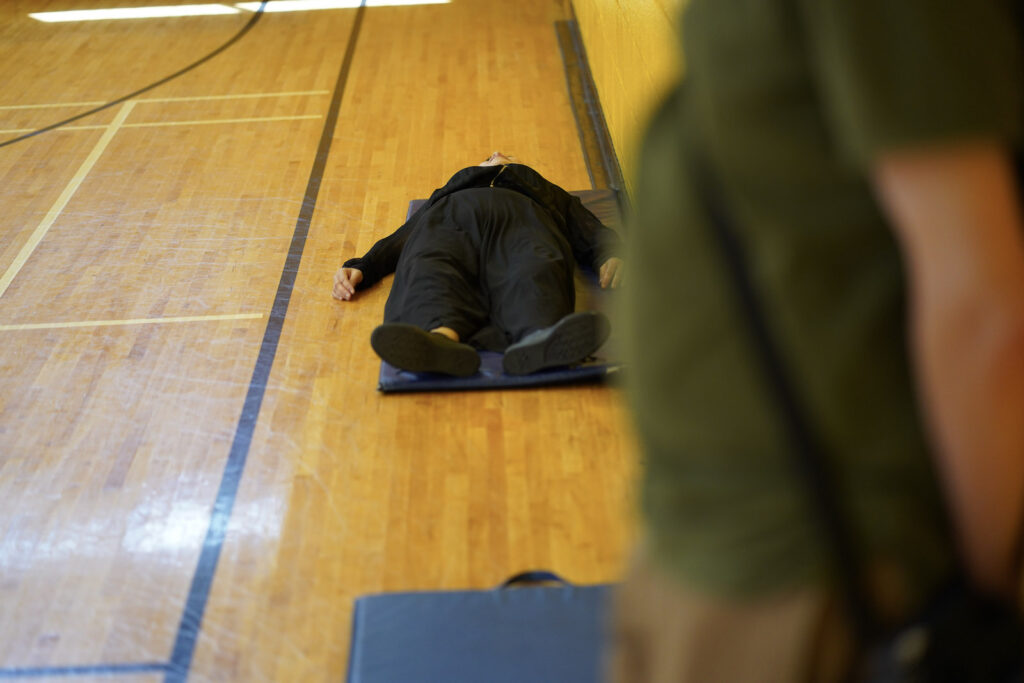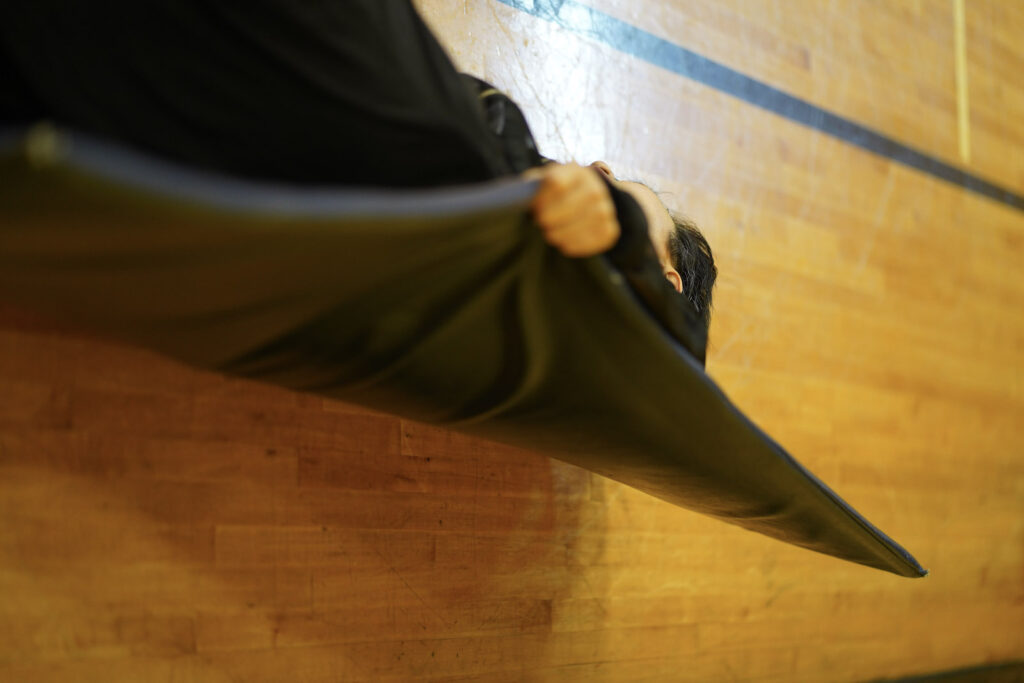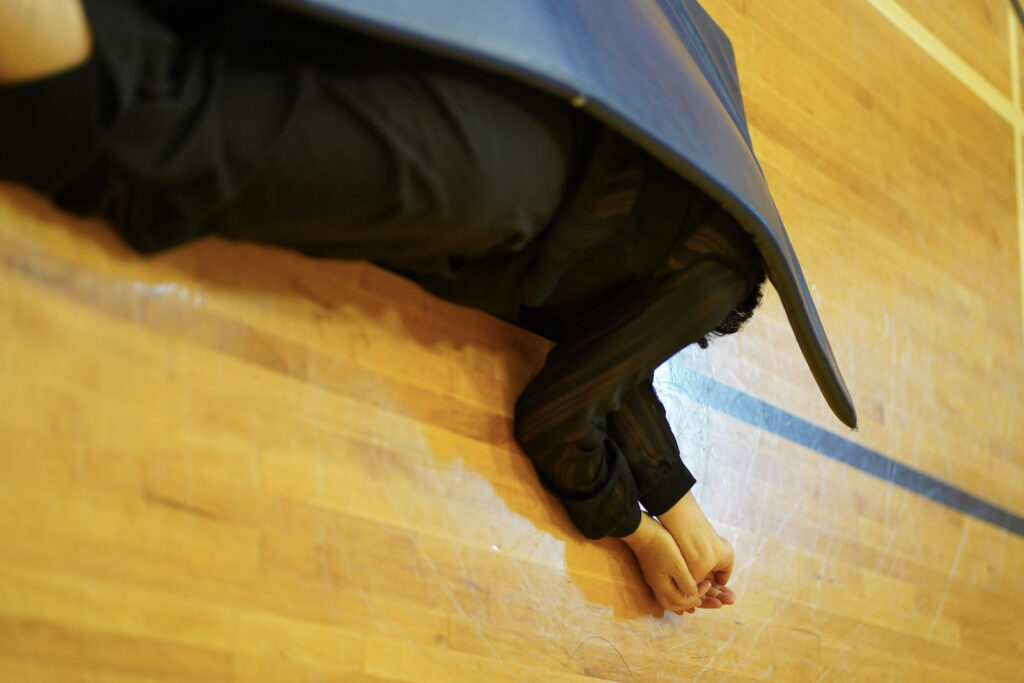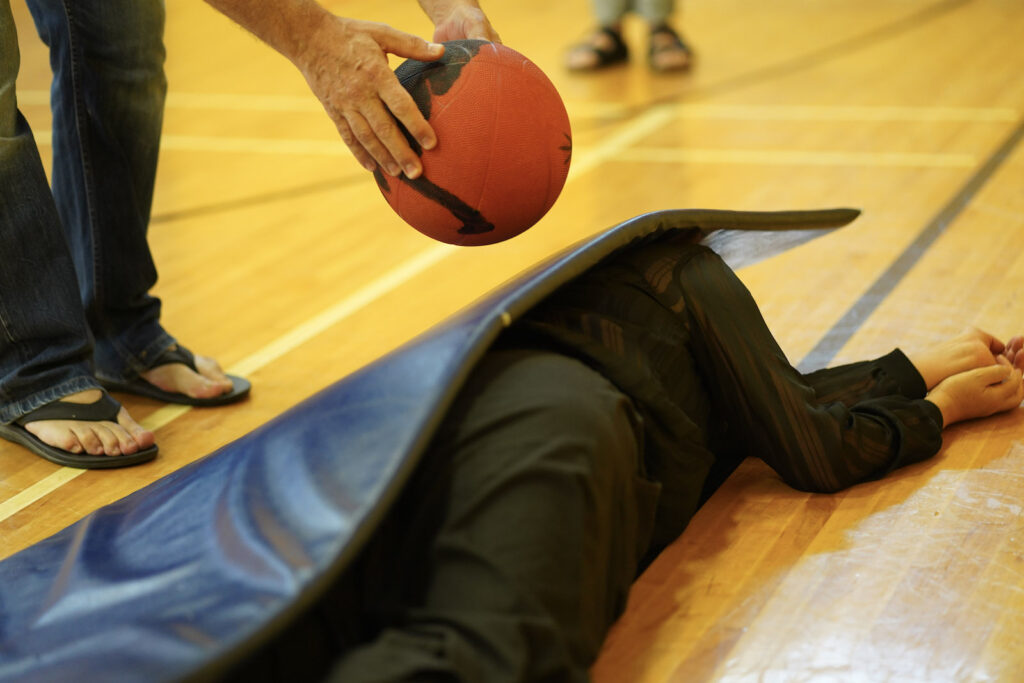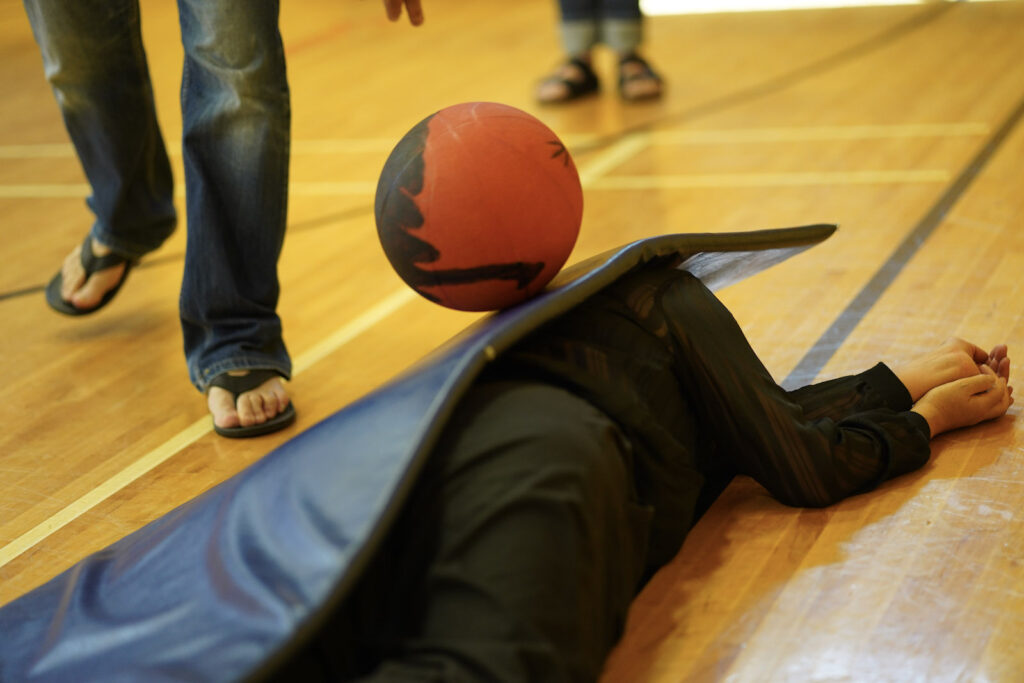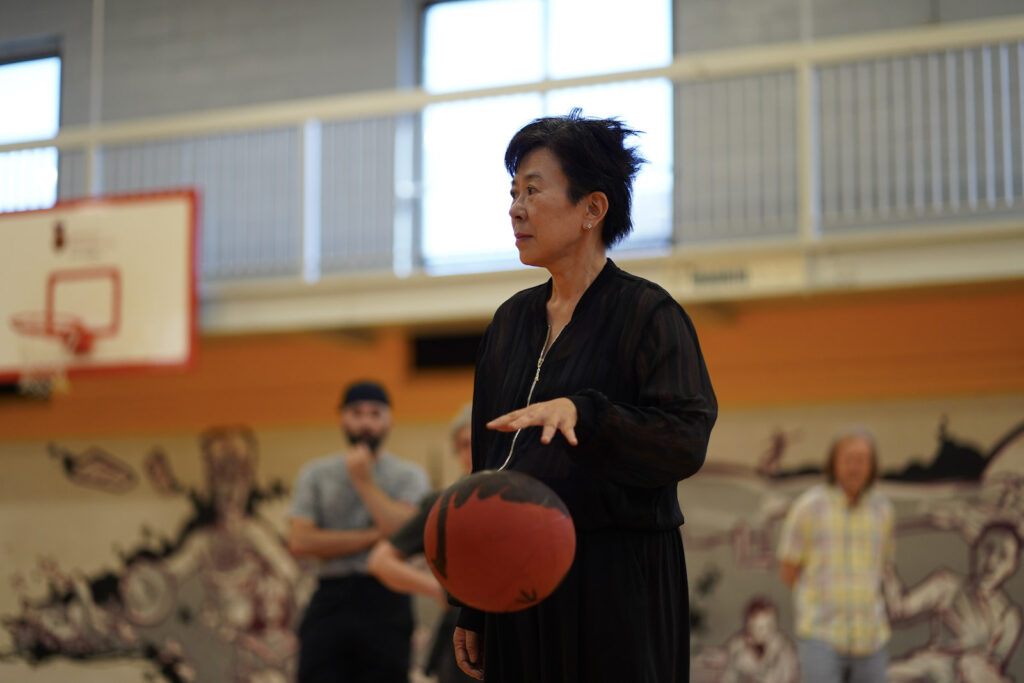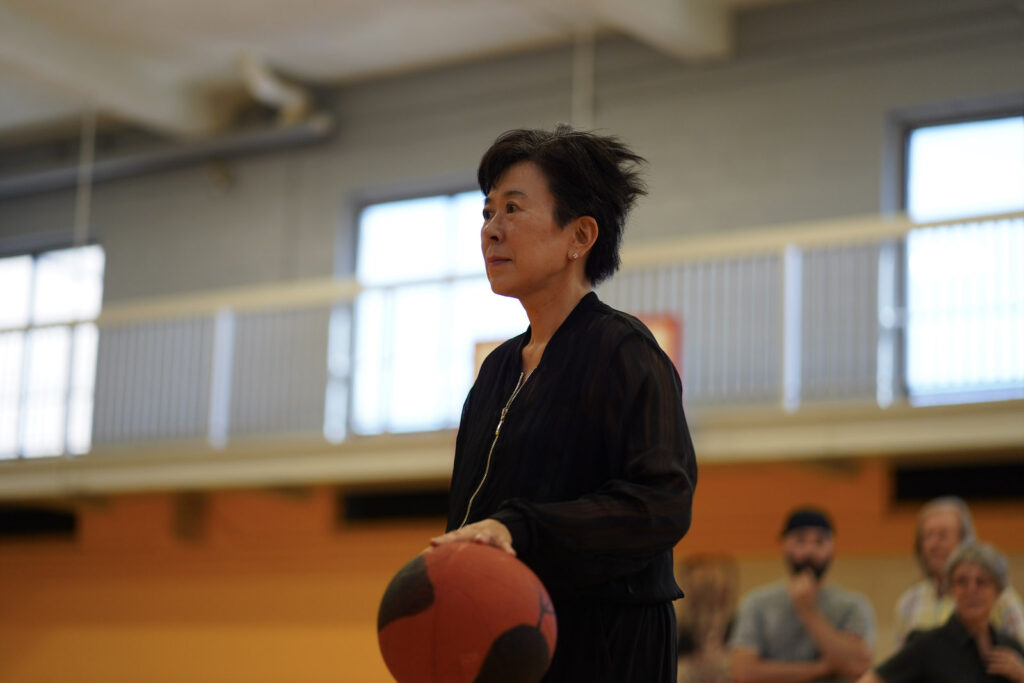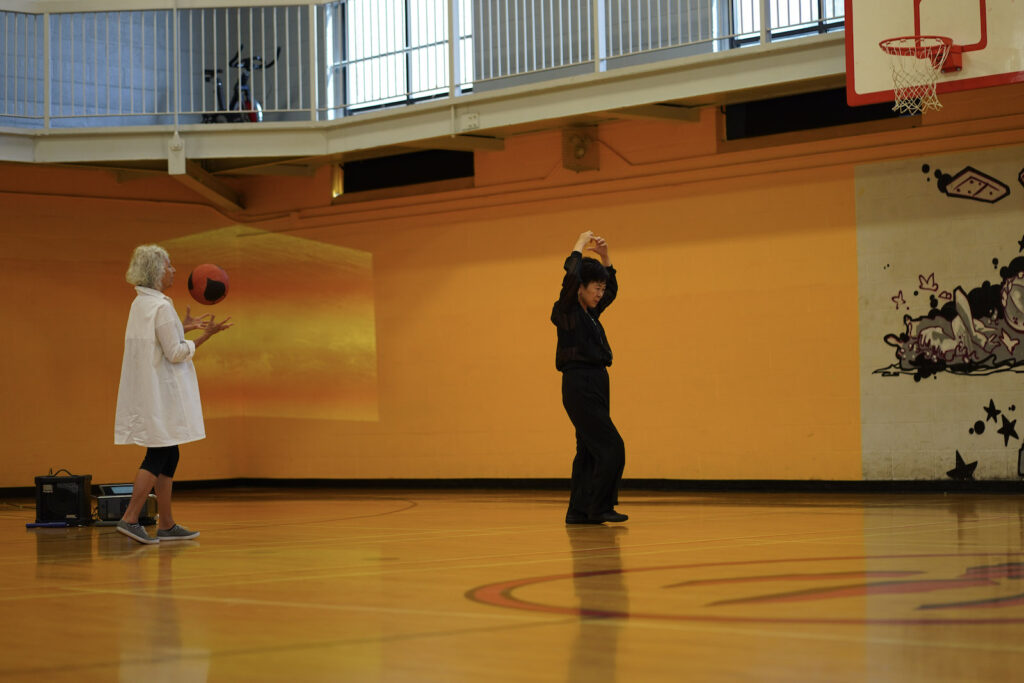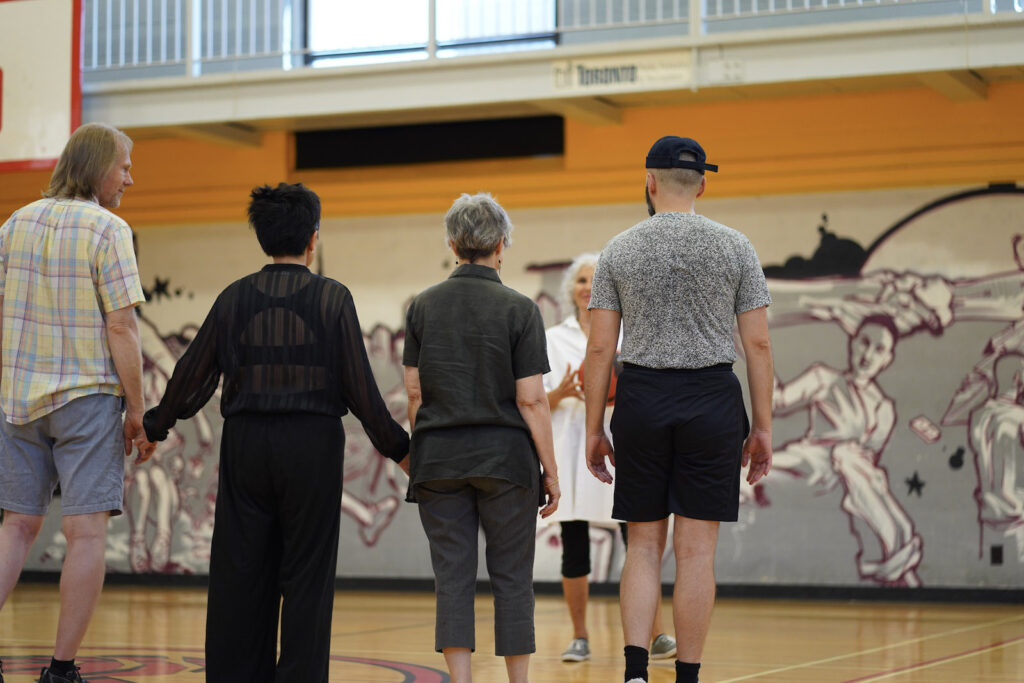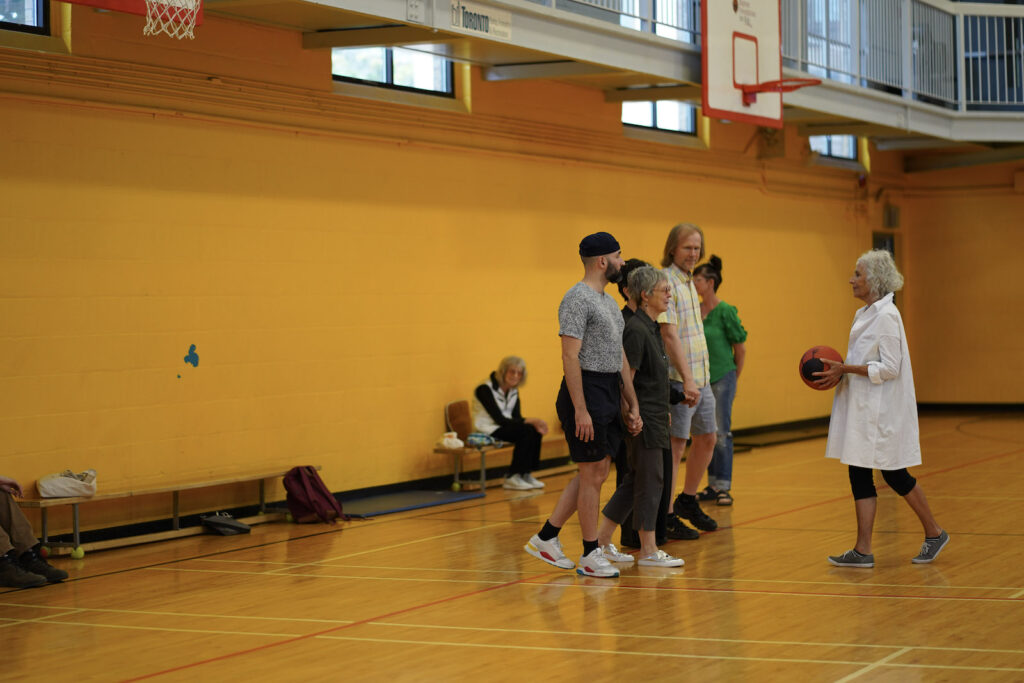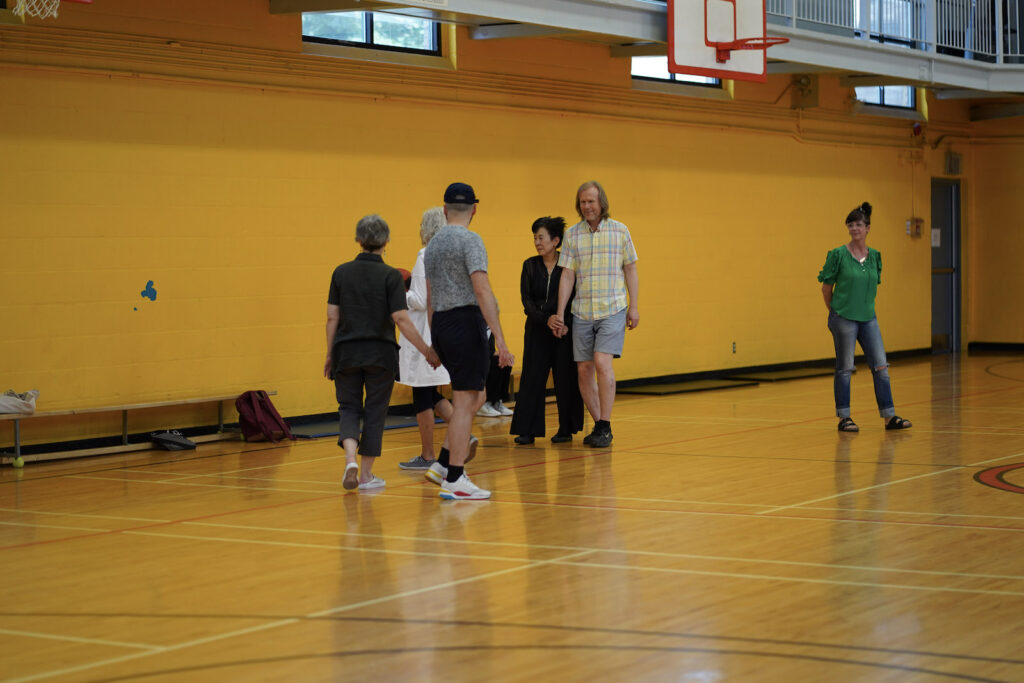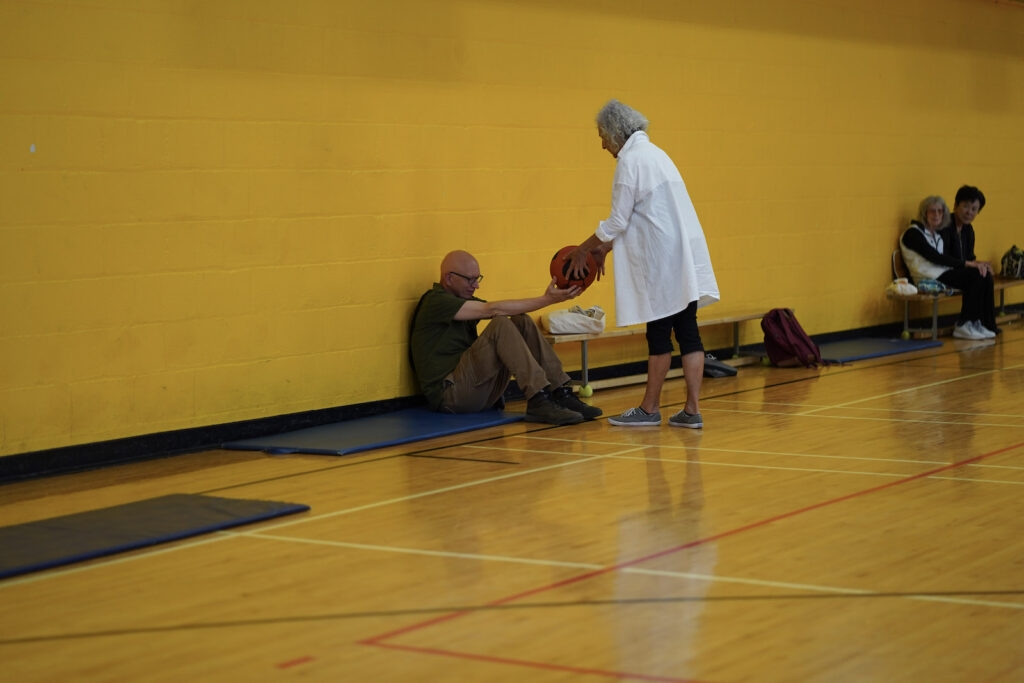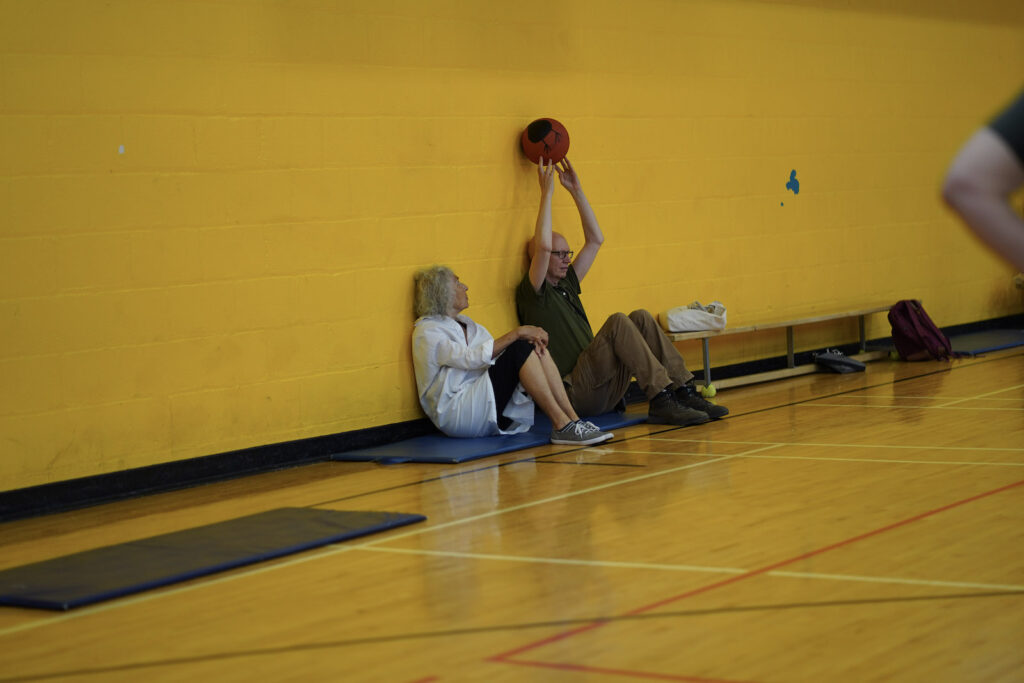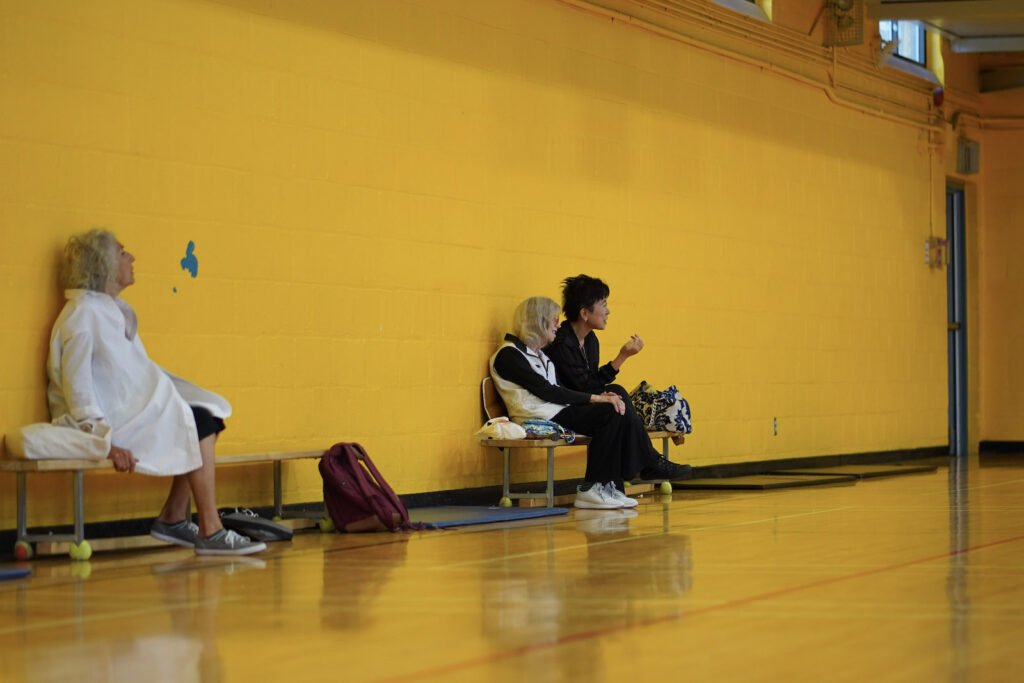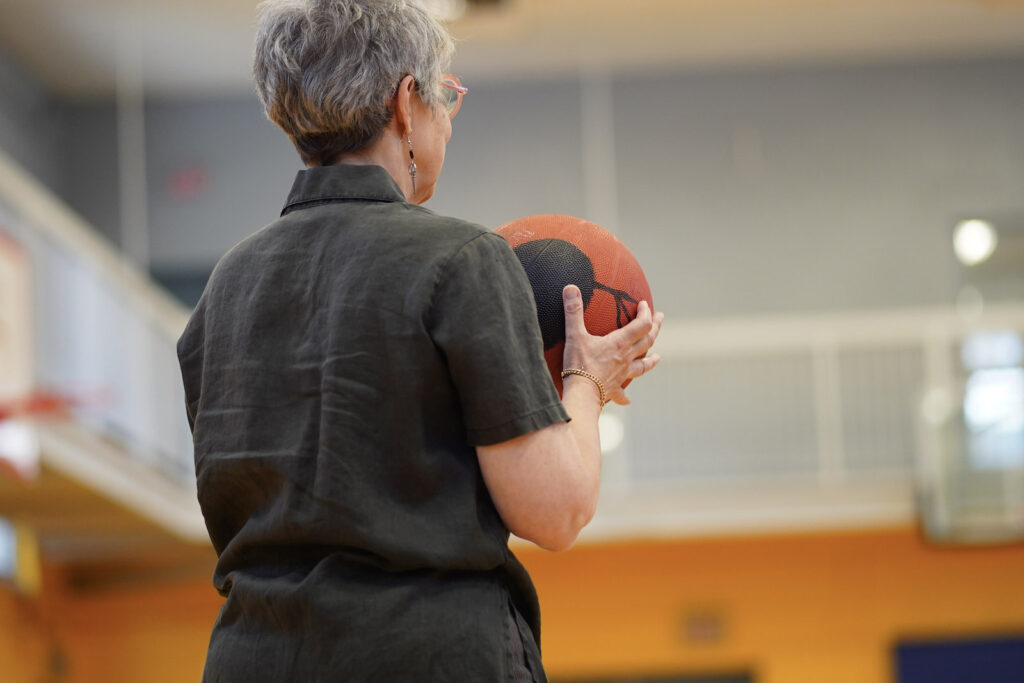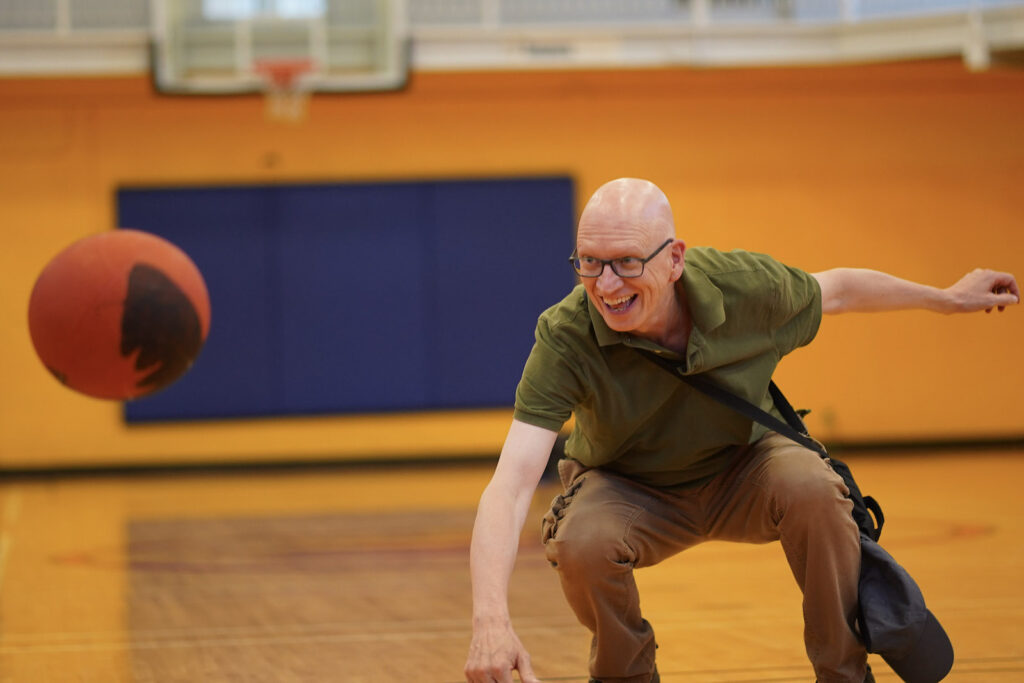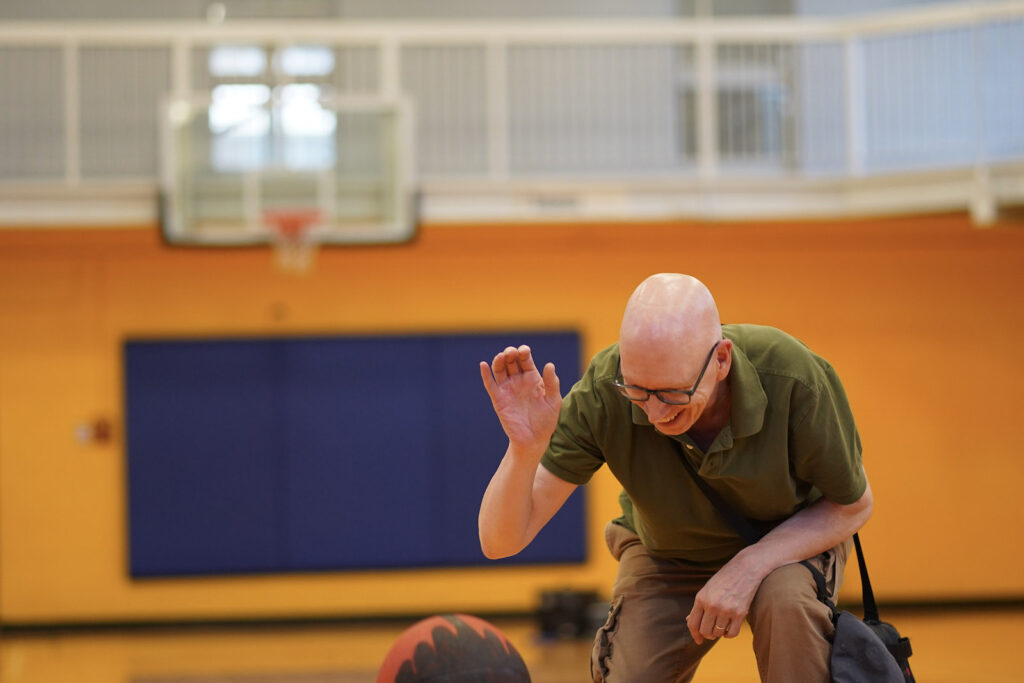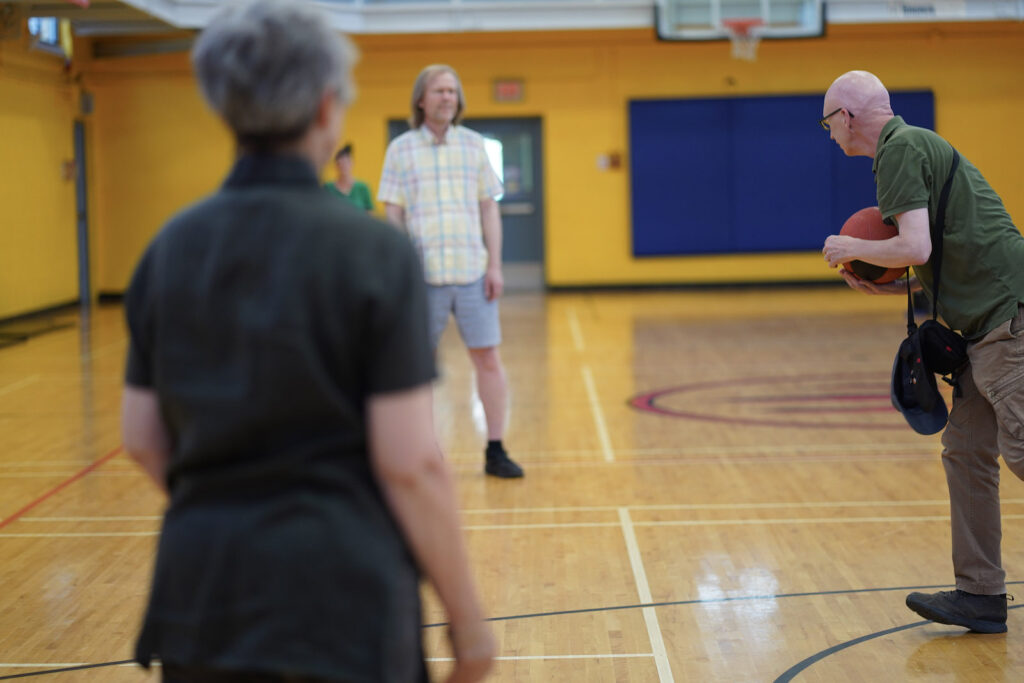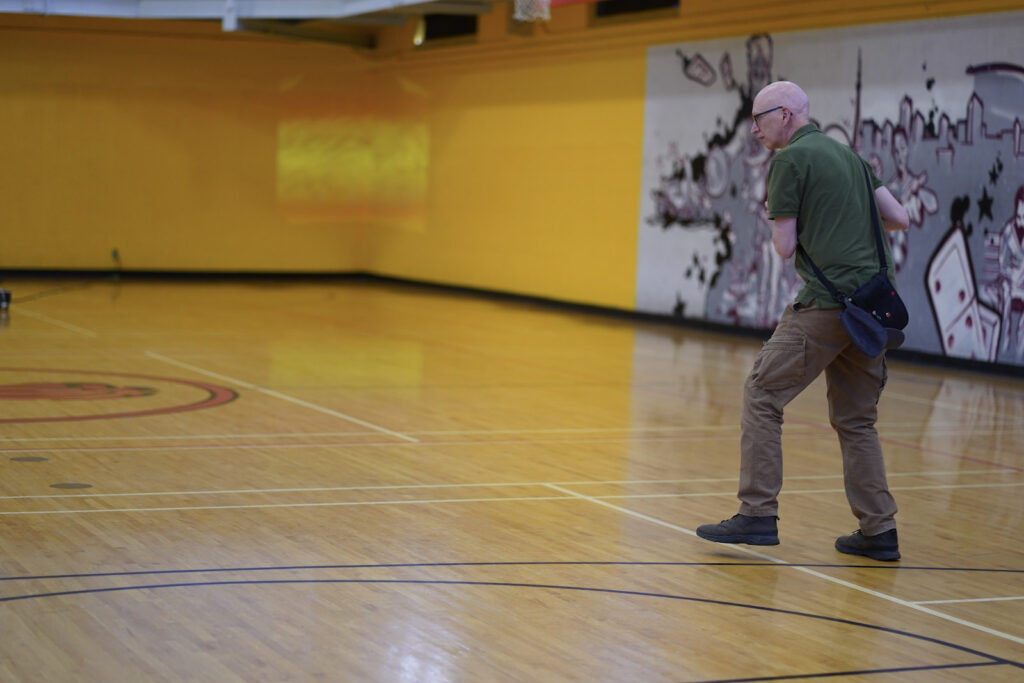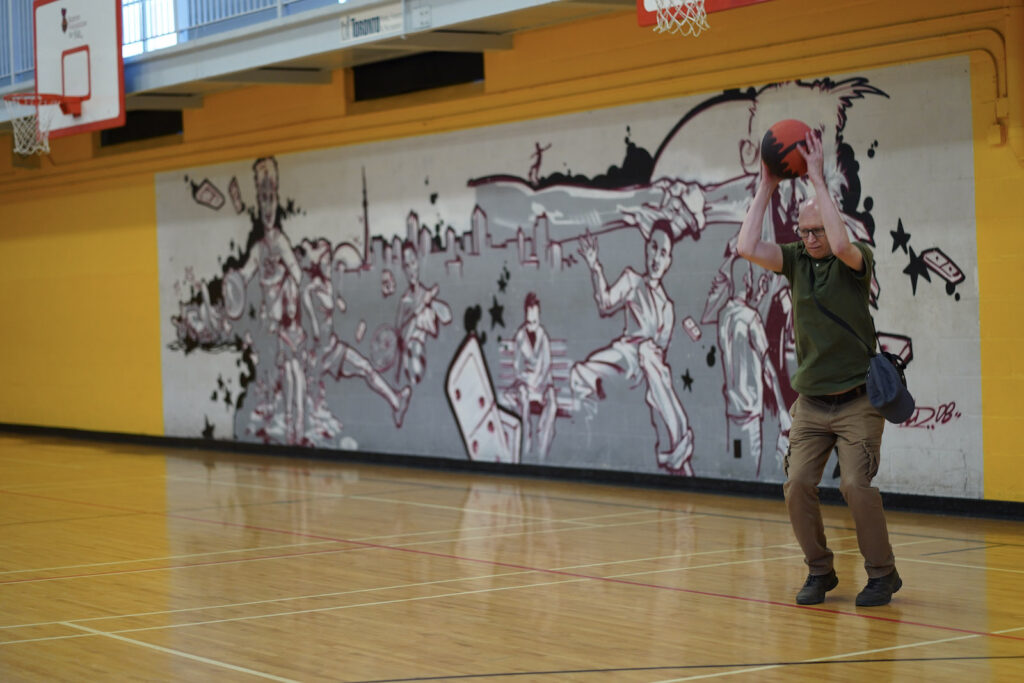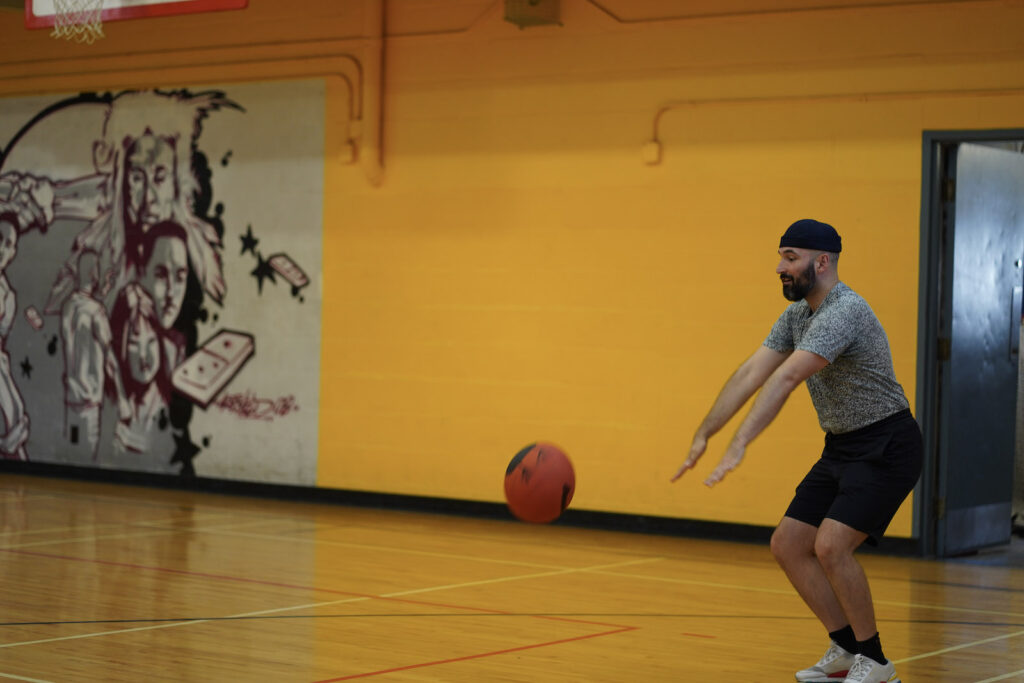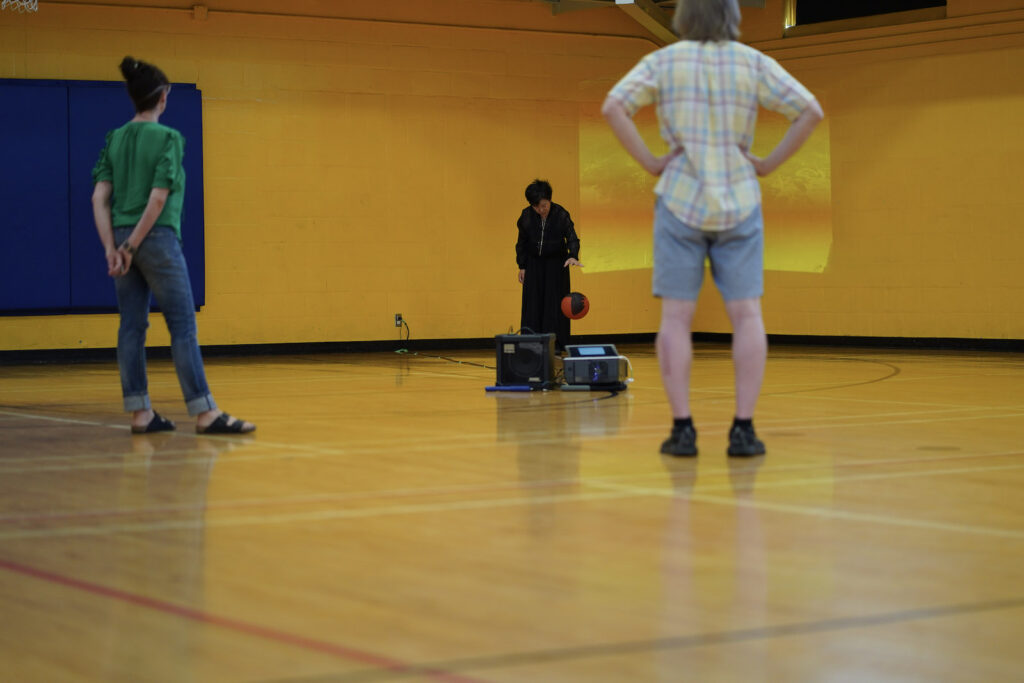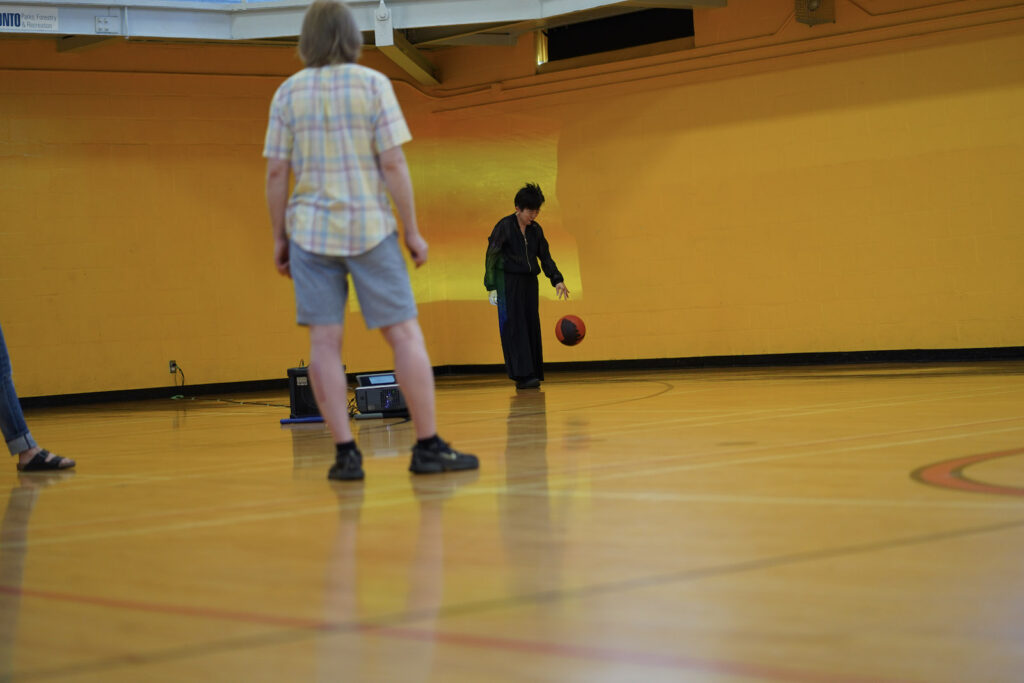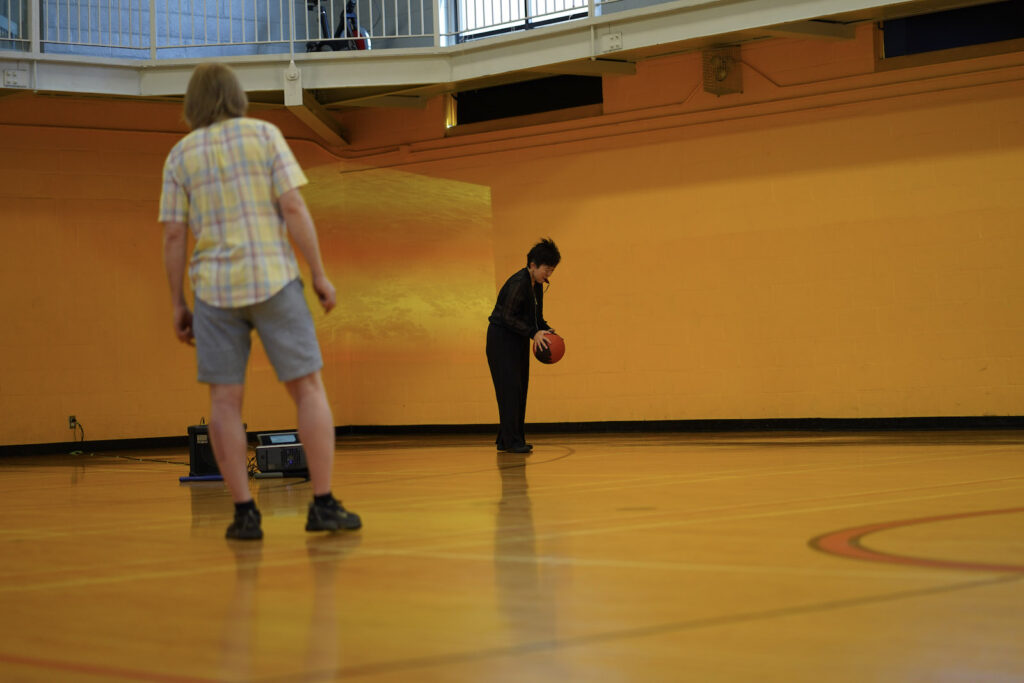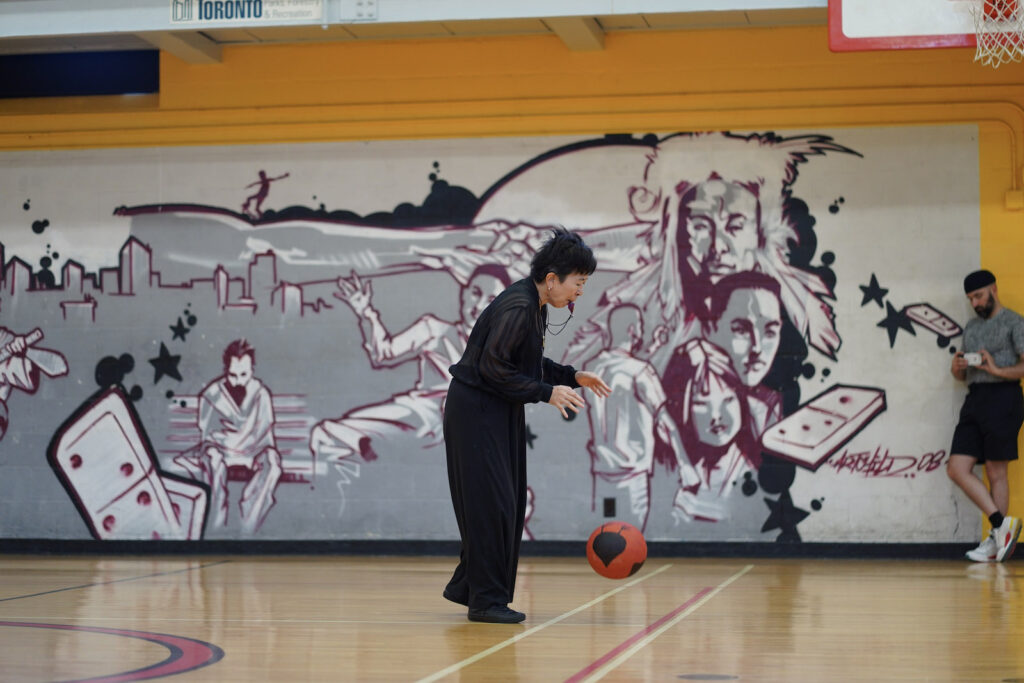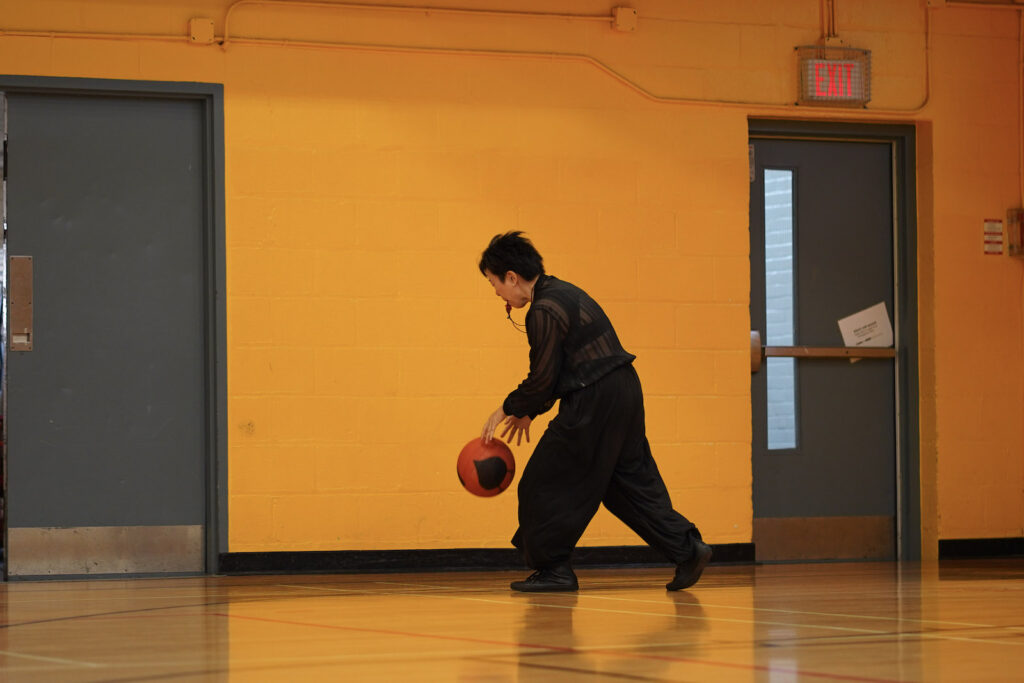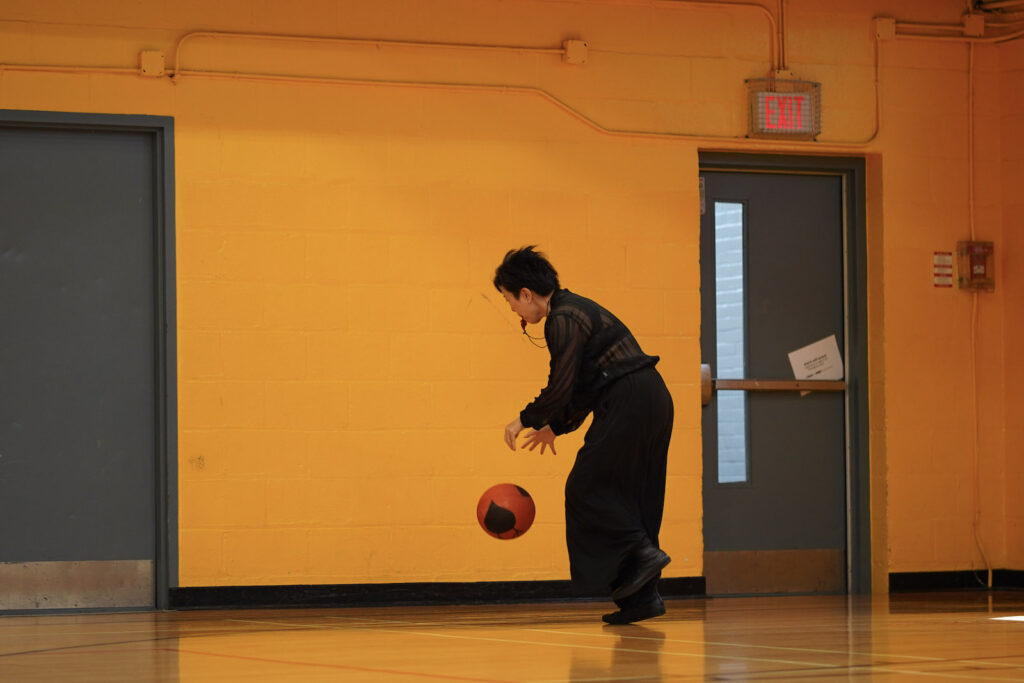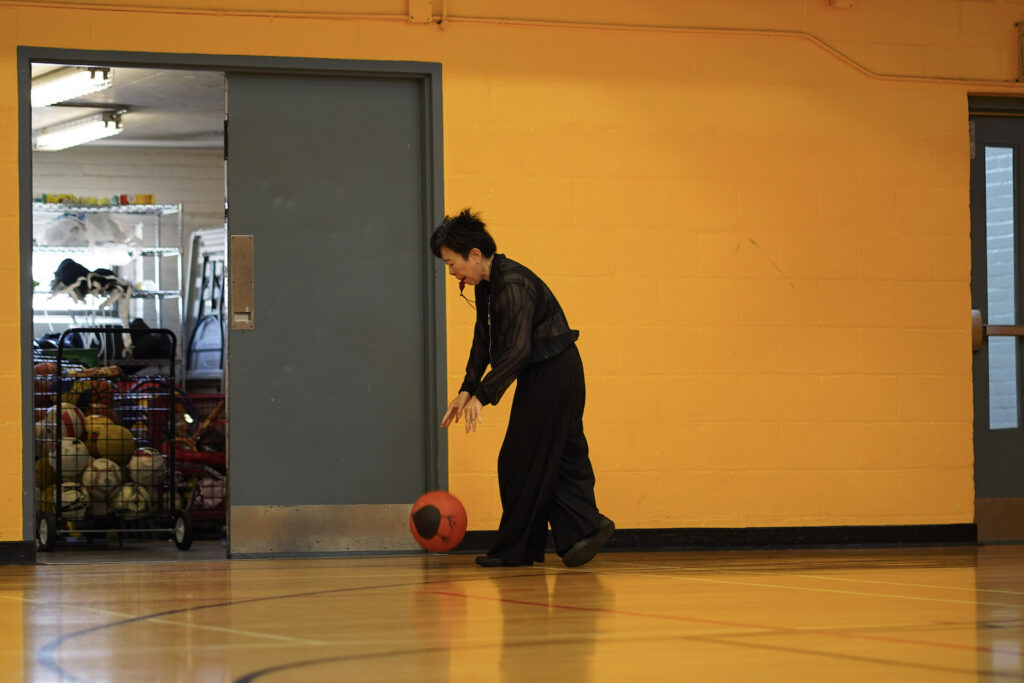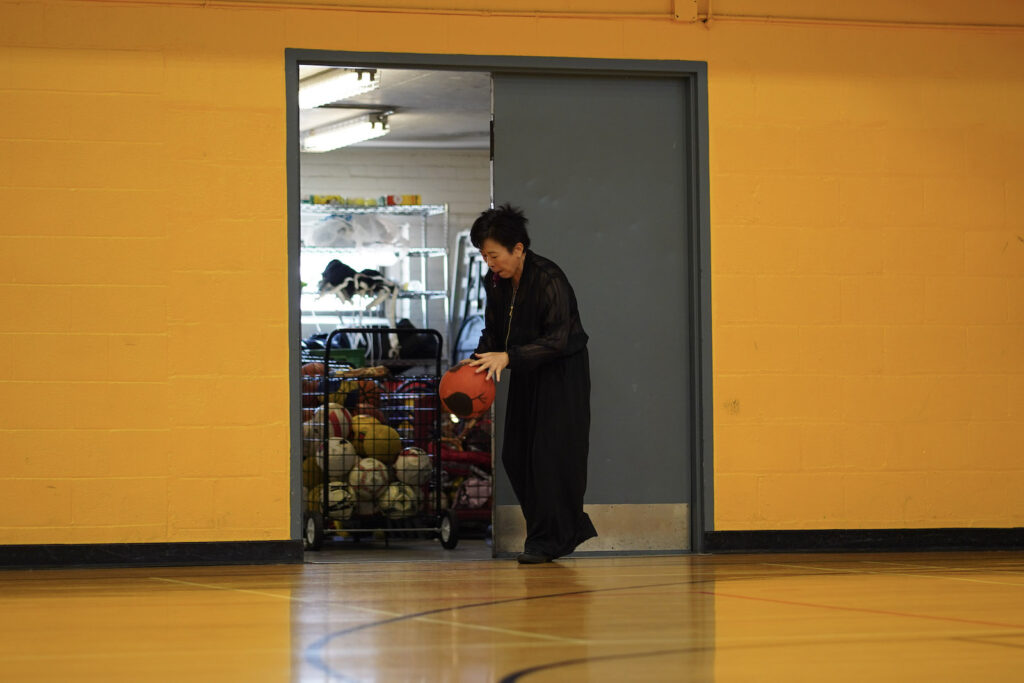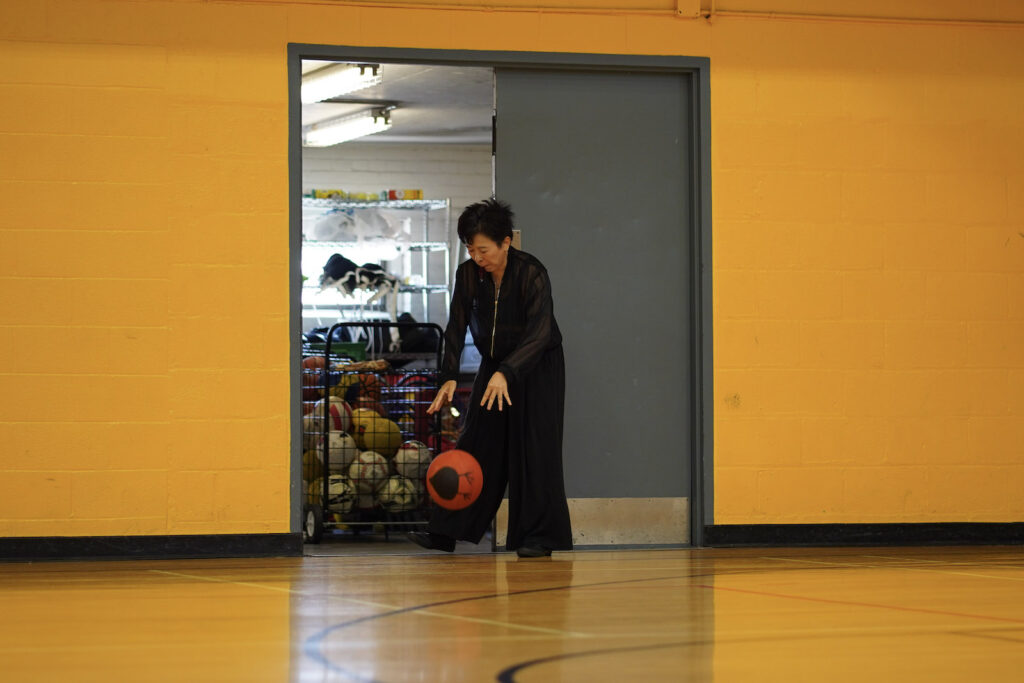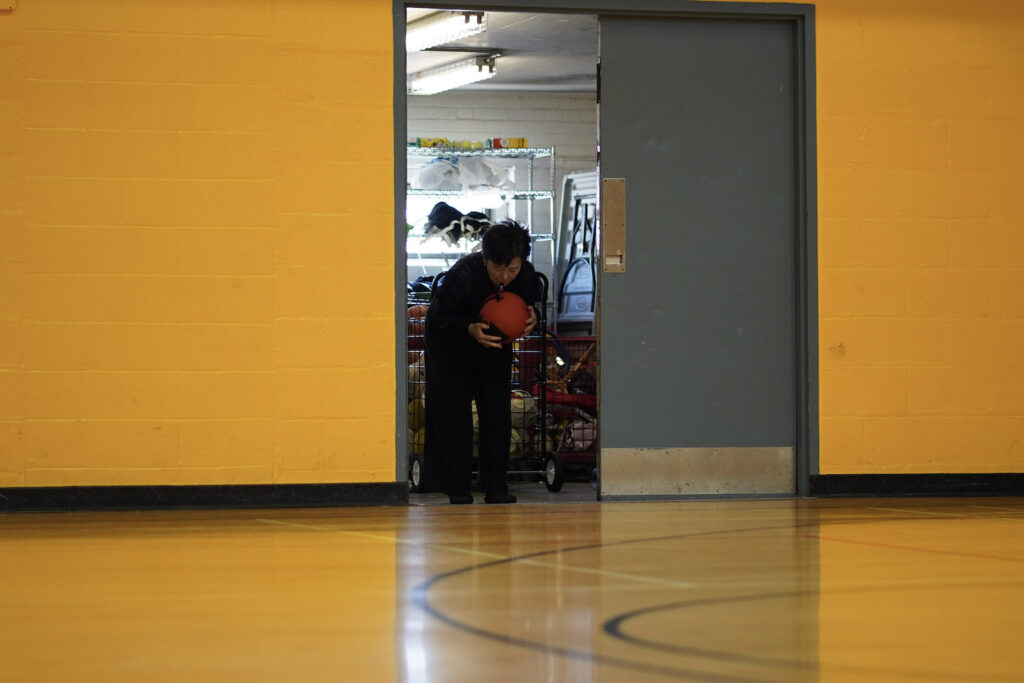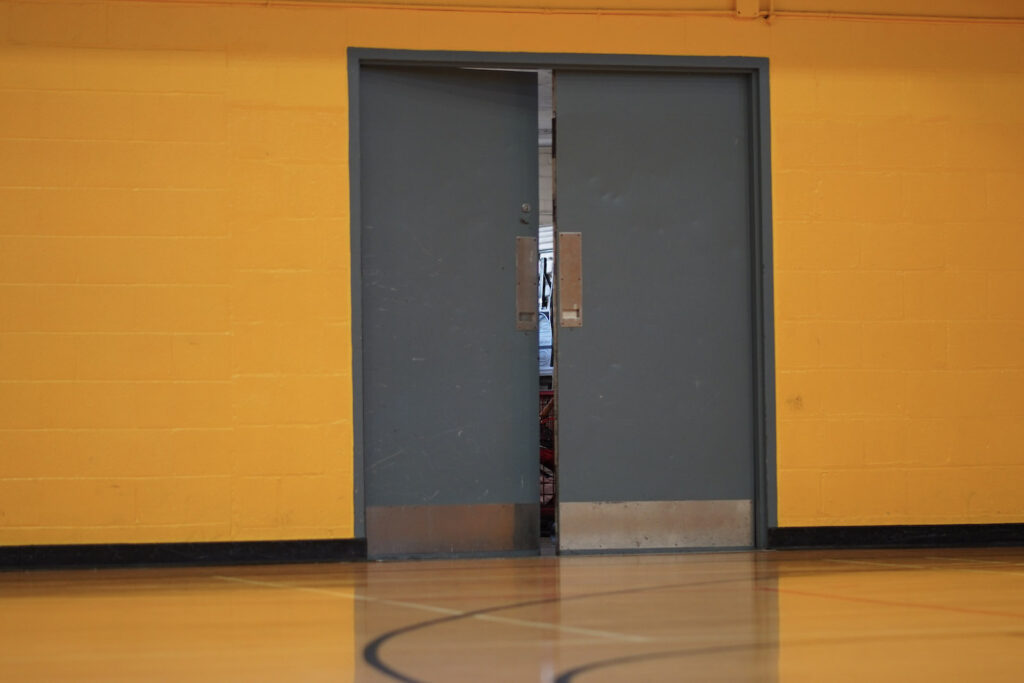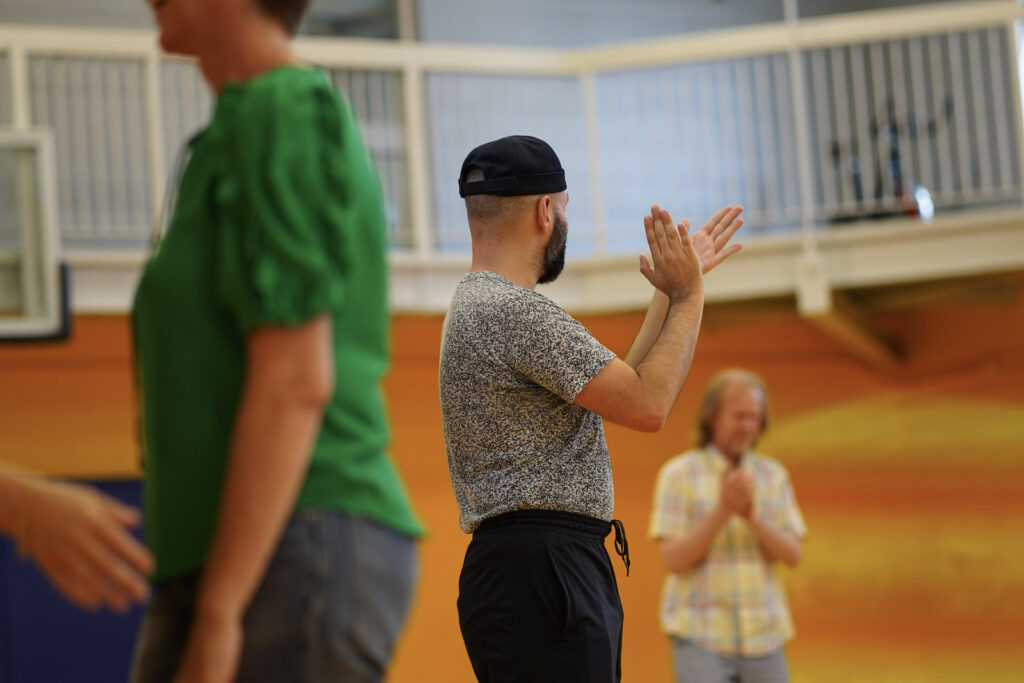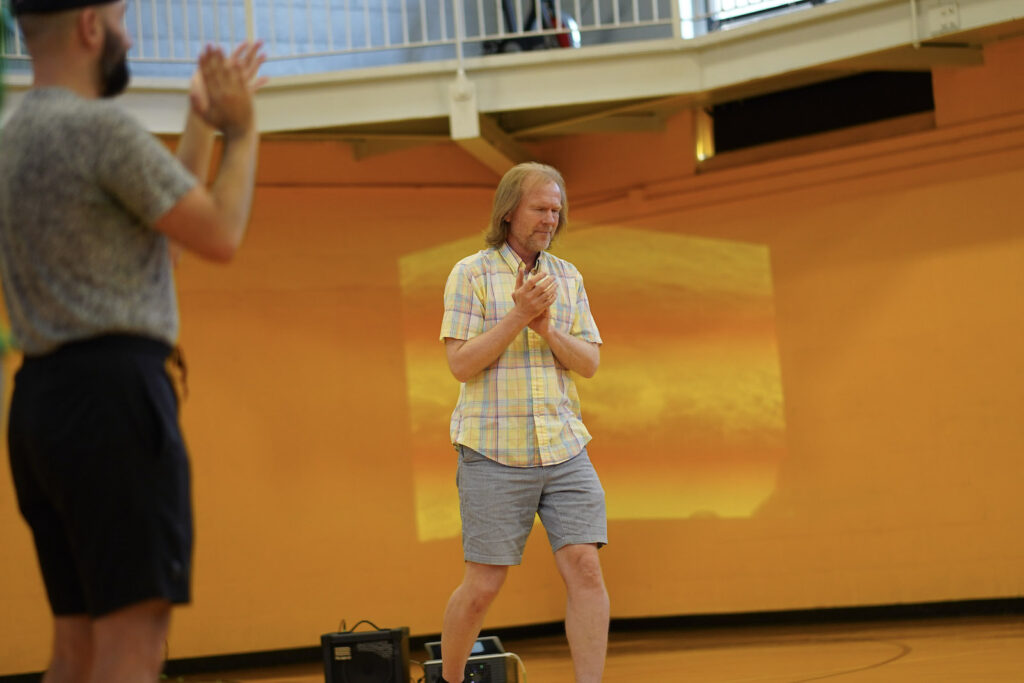Sakiko Yamaoka prefaced her KinesTHESES project, Body Maintenance, with these words: “I, personally, don’t like to do or watch any sports, but we can use the tools of sport for other intentions. For example, art performances.” Consequently, her project for KinesTHESES took place at a downtown Toronto basketball gymnasium on a sunny summer Sunday afternoon.
As a set of actions, the performance was deceptively simple. She began the performance framed in the doorway of an equipment storage room located along one of the long walls of the gymnasium. Bouncing a basketball, she entered the gym and proceeded to move through the space bouncing and rolling the ball in various rhythms, eventually using it to establish relationships with the audience that encouraged us to become active participants.
Whether overtly acknowledged or not, actions and events always have embedded contexts. In performances, for example, we generally expect a narrative to be driven by the “performer.” In sports, we have been trained to act according to established rules and objectives. Although the gestural elements of Body Maintenance were simple, they worked both with and against these powerful cultural expectations. As someone experiencing the event, I felt a tension between the anticipatory — What is Sakiko’s plan? Is there a particular direction to her actions? Something specific that she intends to happen? A feeling or perception she wants us to create or discover? Why is she moving in these particular ways? — and the improvisational — How are we meant to participate? Do I want to intervene in these actions? What would happen if I did this or that? What will the others do?
The site
The John Innes Community Recreation Centre is a physically accessible and free facility run by the City of Toronto to serve the low-income Moss Park neighbourhood. Its gymnasium is a large, brightly lit, echo-y basketball court with a sprung hardwood floor and additional basketball nets set up along its side walls to form three mini-courts. A raptor claw logo dominates the floor’s centre, a reminder that the gym was refurbished in 2008 with the support of the Toronto Raptors, the Raptors Foundation for Kids, and Rogers Communications Inc. More than just a fitness facility, this venue is intended to serve as a local dream factory for inner city youth.
When the centre’s rooms are not booked with the city’s programming, the facilities are made available to non-profit and community groups—but as one might expect, the high turnover of activities and limited staffing means there are few options for changing a space’s basic set-up. Rooms are offered for use on an as-is basis. For Body Maintenance, we did not even have access to the overhead fluorescent lights; the best we could do to alter the room lighting was to stuff some gym mats into the lower section of some of the high windows that line the walls on three sides.
The set-up
When Sakiko first saw the room she would be performing in, she was concerned that visitors might be seduced by the setting to start shooting hoops with the basketball. She considered hanging fresh cut flowers from the nets that line the walls to deter this impulse, but in the end she left them unmodified. Other than the partial covering of the windows, her one installational intervention was to beam a small video projection directly onto the yellow cinderblock walls in the darkest corner of the space. Sakiko nixed the stand-up screen I had provided, because she felt it was too incongruous with the space. The projected image—somewhat dim but still legible despite the brightness of the room and the distortion caused by the way the projector was aimed at an angle to the converging walls—was a loop of waves crashing onto a rocky shoreline, shot from above. The accompanying sound of the waves, amplified by the echo of the large space, permeated the room with a loud rhythmic wash of noise.
Once the video projection was in place with the sound turned up, visitors were free to enter the gym, although most chose to stay outside enjoying the weekend summer sun until the performance began. Those who did come in early could watch Sakiko, dressed in black—including wide-legged flowing pants and a sheer top that zipped up the front—as she prepared for the performance: standing, crouching, sitting, lying down, moving through the space, and bouncing an orange basketball inked in black with two silhouettes of birds.
Warming up in the space is certainly not unusual for performers, although it is somewhat rare to do so in front of an arriving audience. These moments of physical preparation allow a performer to go through a series of internal and external attunements: to clear away any thoughts and emotions that are extraneous to the performance, to run through familiar or planned gestures, to assess one’s energies and perhaps attempt to calm or energize oneself accordingly, to map out performance possibilities that sometimes only come into focus at the cusp of activation, to gauge the conditions and textures of the room—its size, its tone, its illumination, its temperature, its smells—all presumably in service of an intention to feel that one is truly present to the moment at hand. Such moments are generally not included as part of the documentary record of an event, but a static video camera set up on a tripod in one corner of the second-story observation deck that lines the space was turned on early, recording approximately 15 minutes of Sakiko’s preparatory work leading up to the Body Maintenance performance.
Digital records: video recordings
Two video cameras documented the Body Maintenance event. One, the continuous static overhead shot, offers a bird’s-eye view of the unfolding action from beginning to end. I find this viewpoint encourages me to focus on the physical trajectories and kinetic rhythms activated by the performance: how the participants move through the space, standing, sitting, grouping and scattering, following or establishing lines and arcs of movement, and speeding up or slowing down in relation to what is happening. When I introduced Sakiko’s performance to the live audience, I indicated that they should not expect to sit on the sidelines:
“Today is the first event in the KinesTHESES series, featuring Sakiko Yamaoka from Japan. She has asked, ideally, that we should be up and moving around, following her for the piece. The benches are here if you need to sit—if you’re tired, that’s fine—but the ideal way to view the piece is more actively: standing, moving around…”
This long-shot view does not cue the viewer to assume that Sakiko is necessarily or always the most important focal point. If anything, the steady, unblinking perspective encourages viewers to “follow the bouncing ball.” Because the shot is continuous, there are no gaps in the recording, but neither does it offer any close-up details or adjustments for when the action moves out of the camera’s field of vision. It can be challenging to maintain one’s attention when watching this kind of extended long shot; I find I have to work to stay focused on noting what is evident within such a static and distant gaze. It feels somewhat detached or depersonalized.
This vantage point is useful, however, for mapping out how various aspects of the performance unfold spatially and kinetically. Reviewing the footage, I even see some things in ways that were not apparent to me when I was participating in the performance. There is a moment, for example, when Sakiko places the ball on the floor, some distance from her sitting body. Watching from “above,” I view this gesture as an invitation, or maybe a provocation, for someone else to take the ball. When I was in the performance, sitting on the floor myself, this interpretation never occurred to me; I experienced it as a moment of stillness and tension exclusive to Sakiko’s relationship to the ball. How long will she sit beside the ball, not handling it? Is her connection to the ball strengthened or weakened by this distance? Watching from within the performance, my standpoint at that moment was that of a witness rather than a potential interlocutor. I had no impulse to take possession of the ball, reluctant to insert myself into the action.
A second, handheld video camera, operated by Alan Peng, also recorded the event. This camera shifts locations, offering something a bit closer to a participant’s point of view as Alan tries to watch from the sidelines, capturing all of the action without interfering with its flow, but this is tricky when the entire room is a potential playing area. The footage is not continuous; the camera is sometimes turned off briefly between positionings, resulting in a series of separate shots that inadvertently build an impromptu narrative of incidents as Alan decides what to shoot, and from what position in the room. Like the rest of the audience, Alan did not know in advance exactly what would happen. This invests the footage with a more interested perspective as an assembly of framings and details that he felt illustrated the action or that he found to be visually compelling in the moment. As a raw compilation of shots, the footage is not entirely seamless. There are (what could be viewed as) both serendipities and miscues as Alan attempts to record actions, reactions, kinetic trajectories, gestural beginnings, middles, endings, transitions, transformations, and emergences. To the extent that the event can be framed as a confluence of overlapping impulses, there are evident gaps—not only because of the camera’s inability to record the internal life of each of the participants, but also in the subjectively framed and directed visual mapping of the event’s animate and material unfolding.
Digital records: photo gallery
Body Maintenance was also recorded through a series of digital photos taken by Jeff Zhao. Although I had discussed the idea of creating a Digital Toolkit with Sakiko in advance of the performance to find out what kind of documentation she thought might provide an effective catalyst for potential reanimation, I did not share any details of the Toolkit with the documenters. Alan and Jeff approached their role with the traditional documenter’s understanding of trying to record some representative—and hopefully captivating—images of the event. In other words, their goal was to end up with a somewhat faithful and compelling log of what has been as opposed to providing an access point for what could be.
The event, of course, is already something both less and more than the gesture of the performance. The event cannot encompass any previous or later presentations with the same title that the artist might undertake, nor can it contain the ongoing reactions, recurrences, or reverberations that go beyond the published times of the work’s iteration. At the same time, the event encompasses details that might be considered extraneous to the performance. Does a photo of me as the organizer introducing the project, or of audience members clapping at the end, convey something useful about Body Maintenance for anyone seeking to access or reanimate Sakiko’s tactile-kinesthetic propositions? I am not sure.
Usually, a web record of such an event might include a small number of images chosen as much for their status as great photographs—that is, striking in terms of the aesthetic vocabularies of photography—as for their ability to accurately convey what happened or to give a sense of what the performance was “like.” For this project, since Sakiko did not express any particular editorial preferences, I am instead including in the Toolkit almost all of the images and footage shot by Jeff and Alan, although not necessarily at their full original digital resolution. I am aware that this approach may ultimately work against the possibility of conveying a clear, vivid sense of Body Maintenance. Judicious editing is a necessary and useful part of any storytelling process, and there is more than a grain of a truth in the old adage that “less is more.” Providing more images does not offer any guarantee of completeness. It is not as if Alan’s videography, Jeff’s photography, and my written descriptions are not already highly selective recordings, reflecting the technical limitations of each medium, our particular virtuosities as documenters, our varied understandings of what we are trying to capture, as well as our personal tastes and affinities.
The Digital Toolkit, however, is less a storytelling mechanism than it is a prompt for ongoing storymaking. The documentation included here is meant to address the still-lively question of how best to record an event if one’s goal is corporeal access and potential reanimation. This particular decision, to include what may seem like a plethora of material, is specific to Body Maintenance; other projects in the KinesTHESES series will explore different approaches. I don’t propose any consistent or serial institutional response to the question of what documents should be collected for or included in such a Toolkit. Instead, what is consistent across the KinesTHESES projects is to pose the question of how each individual performance, developed or at least framed as a tactile-kinesthetic and audience-centred experience, might best be preserved or documented in a way that facilitates the performance’s continued access and liveliness for expanded audiences.
Embedded in this question is the parallel concern of what types of documentation best represent a performance. As a performance artist, I confess that when it comes to recordings of actions presented as live events for an in-person audience, I generally prefer photo to video documentation. This preference is more intuitively than intellectually driven, but in trying to think through why I respond this way, it strikes me that although video can record a linear, temporal progression of activity, it very seldom if ever replicates the “feeling” of time and relationality that exists in a performance. To get a sense of a performance’s liveliness from a video, then, I find I have to read not just into, but against the recording medium, which has its own distinct temporal affect—one that many documents try to compensate for through careful editing. Watching video documentation, I often experience a sense of dissonance that interferes with my ability to intuit or resonate with the intra-active relationality (how time, space, materials, and animateness are entangled in mutually effecting ways) of the original event—somehow more so than with a still photo.
This is, of course, a speculative observation. It may be accurate as a description of how recorded documents make me feel, but it remains suspect as a truth claim about the relative effectiveness of either medium in delivering an authentic reading of the live event, let alone as an indication of how useful either may be in facilitating a reanimation of (some aspect of) the performance for someone accessing a document. A still photo may be differently evocative than a video recording, but it is no less demanding of interpretive translation. This is clear from Jeff’s images of Body Maintenance, which offer a more finely sliced parsing of visual information than a human body’s unassisted senses could ever achieve. These photos are rife with the uncanny stasis that often makes photography so compelling: objects hanging impossibly in mid air, faces frozen mid-expression, with not even a hint of blur to suggest the directions or trajectories of movement. These photos present images of states that were passed through but could never be continually inhabited, selectively composed and framed with narrow focal lengths that dictate for the viewer what details should be taken as germane or superfluous. At the same time, shifting colour tones from photo to photo remind us of technical differences between the way digital and human eyes read light, while surface textures are transposed into flat registers of glint and sheen.
Neither video nor photo can really be said to capture or reproduce in itself the direct experience of a past event as it unfolded. Both are prompts for triggering corporeal experience, and as such they require a thinking body to complete any activation or transmission process.
The Digital Toolkit encourages users to discover a performance’s gestural material—its tactile-kinesthetic propositions—in ways that are not purely visual or even audiovisual. I am framing this engagement as a potential reanimation process, without being able to know—without even wishing to predetermine—how subtle or overt, how automatic or conscious, the shape and influence of that reanimation may be. Might it be found, for example, in the saccadic movement of the viewers’ eyes watching the video footage on a computer screen as they follow the movements of the basketball and the participants? Can it be embodied by a simple reaction: say, seeing a close-up image of Sakiko’s face, eyes closed and head bowed, and closing one’s own eyes to mimetically conjure up one’s own familiarity with a particular feeling of concentration and attunement to one’s surroundings? Could it play out as a chance corporeal reminiscence, in which one suddenly finds oneself not mimicking, exactly, but being propelled along a gestural trajectory informed by the speed, force, rhythm or delicacy of another’s movement in just such a way as some of Sakiko’s actions were informed by the participants during certain moments of Body Maintenance? Or, does it demand a more deliberate and conscious effort, where one might, for example, gather a group of friends together to experiment with passing a basketball back and forth in various ways, for no other reason than to discover what relationships are made evident through that play, or to pay close attention to the ways in which those movements and inter-relationships are affected by the basketball’s animate materiality; that is, by the ways it is or isn’t able to move through space?
How much or little of a performance’s material, gestural, and/or relational potential needs to be activated for the performance to remain or recur as a lively, tactile-kinesthetic proposition for an audience? This is one of the Digital Toolkit’s open questions.
